Quick filters:
Tang dynasty painting Stock Photos and Images
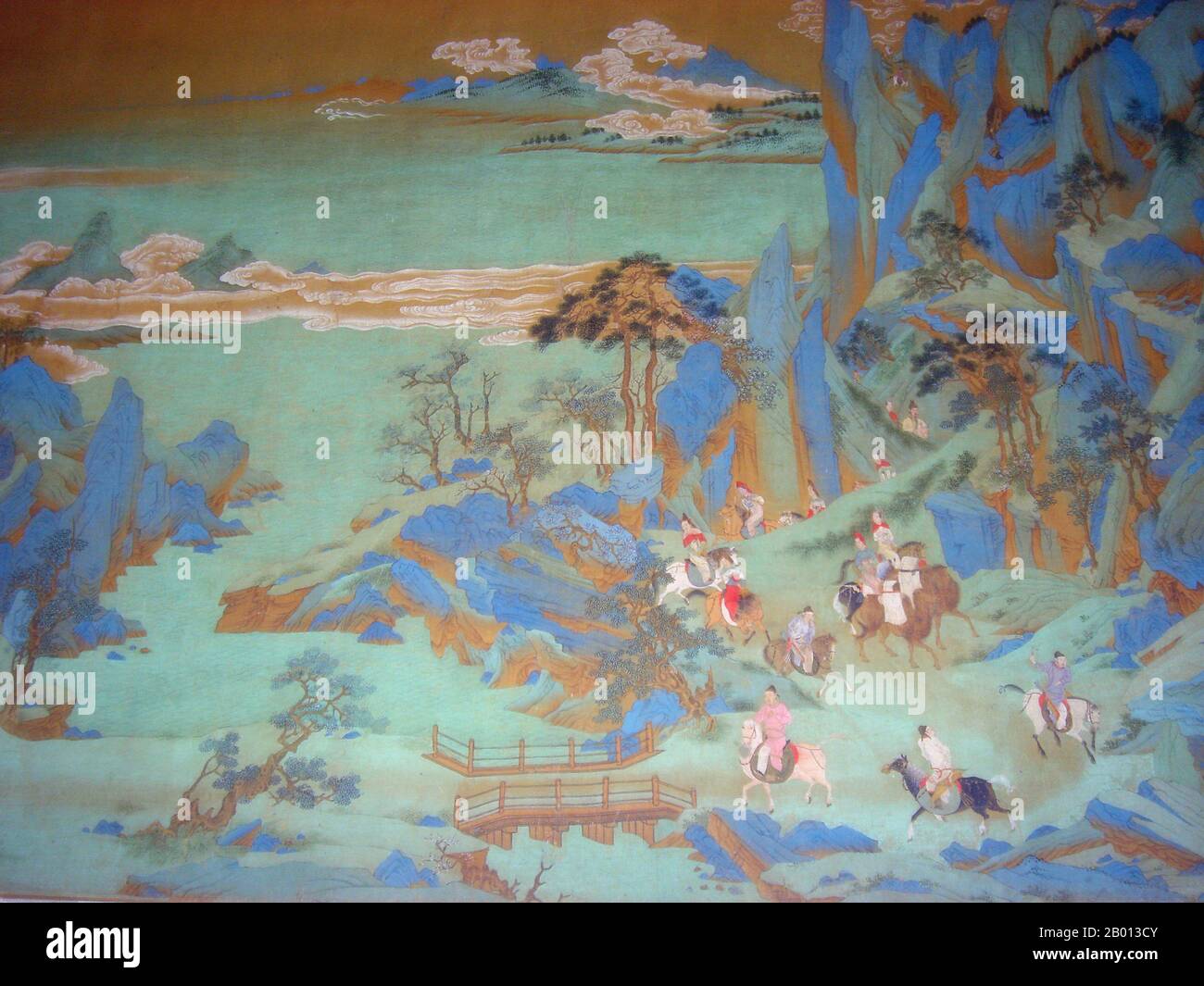 China: 'Journey to Shu'. Detail of handscroll painting by Qiu Ying (1494-1552), 16th century. This section of a much larger Ming Dynasty (1368-1644) handscroll painting on silk shows Tang Minghuang, or Emperor Xuanzong of Tang (685-762), fleeing the capital Chang'an and the violence of the An Shi Rebellion that began in the year 756 during the mid-Tang Dynasty. Stock Photohttps://www.alamy.com/image-license-details/?v=1https://www.alamy.com/china-journey-to-shu-detail-of-handscroll-painting-by-qiu-ying-1494-1552-16th-century-this-section-of-a-much-larger-ming-dynasty-1368-1644-handscroll-painting-on-silk-shows-tang-minghuang-or-emperor-xuanzong-of-tang-685-762-fleeing-the-capital-changan-and-the-violence-of-the-an-shi-rebellion-that-began-in-the-year-756-during-the-mid-tang-dynasty-image344232027.html
China: 'Journey to Shu'. Detail of handscroll painting by Qiu Ying (1494-1552), 16th century. This section of a much larger Ming Dynasty (1368-1644) handscroll painting on silk shows Tang Minghuang, or Emperor Xuanzong of Tang (685-762), fleeing the capital Chang'an and the violence of the An Shi Rebellion that began in the year 756 during the mid-Tang Dynasty. Stock Photohttps://www.alamy.com/image-license-details/?v=1https://www.alamy.com/china-journey-to-shu-detail-of-handscroll-painting-by-qiu-ying-1494-1552-16th-century-this-section-of-a-much-larger-ming-dynasty-1368-1644-handscroll-painting-on-silk-shows-tang-minghuang-or-emperor-xuanzong-of-tang-685-762-fleeing-the-capital-changan-and-the-violence-of-the-an-shi-rebellion-that-began-in-the-year-756-during-the-mid-tang-dynasty-image344232027.htmlRM2B013CY–China: 'Journey to Shu'. Detail of handscroll painting by Qiu Ying (1494-1552), 16th century. This section of a much larger Ming Dynasty (1368-1644) handscroll painting on silk shows Tang Minghuang, or Emperor Xuanzong of Tang (685-762), fleeing the capital Chang'an and the violence of the An Shi Rebellion that began in the year 756 during the mid-Tang Dynasty.
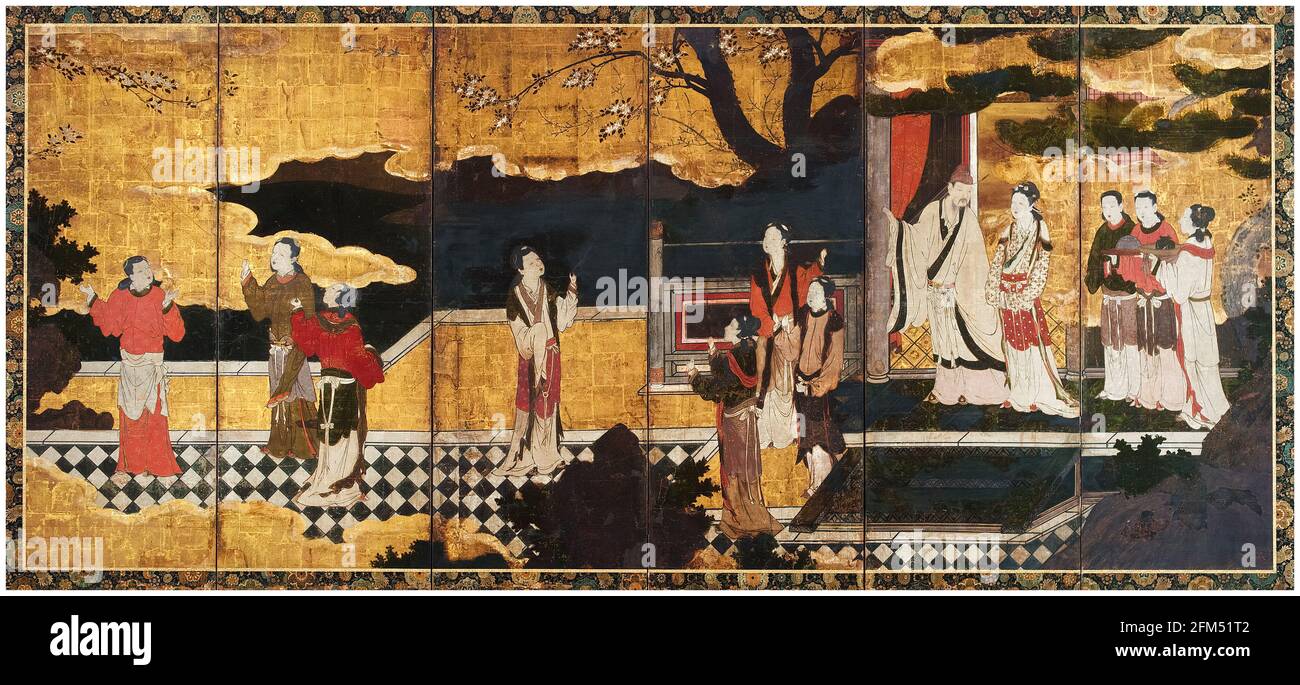 The Chinese Emperor Xuanzong of Tang (685-762), and Concubine Yang Guifei (719-756), with attendants on a terrace, painting by Kano Eitoku, 1550-1590 Stock Photohttps://www.alamy.com/image-license-details/?v=1https://www.alamy.com/the-chineseemperor-xuanzong-of-tang-685-762-and-concubine-yang-guifei-719-756-with-attendants-on-a-terrace-painting-by-kano-eitoku-1550-1590-image425453170.html
The Chinese Emperor Xuanzong of Tang (685-762), and Concubine Yang Guifei (719-756), with attendants on a terrace, painting by Kano Eitoku, 1550-1590 Stock Photohttps://www.alamy.com/image-license-details/?v=1https://www.alamy.com/the-chineseemperor-xuanzong-of-tang-685-762-and-concubine-yang-guifei-719-756-with-attendants-on-a-terrace-painting-by-kano-eitoku-1550-1590-image425453170.htmlRM2FM51T2–The Chinese Emperor Xuanzong of Tang (685-762), and Concubine Yang Guifei (719-756), with attendants on a terrace, painting by Kano Eitoku, 1550-1590
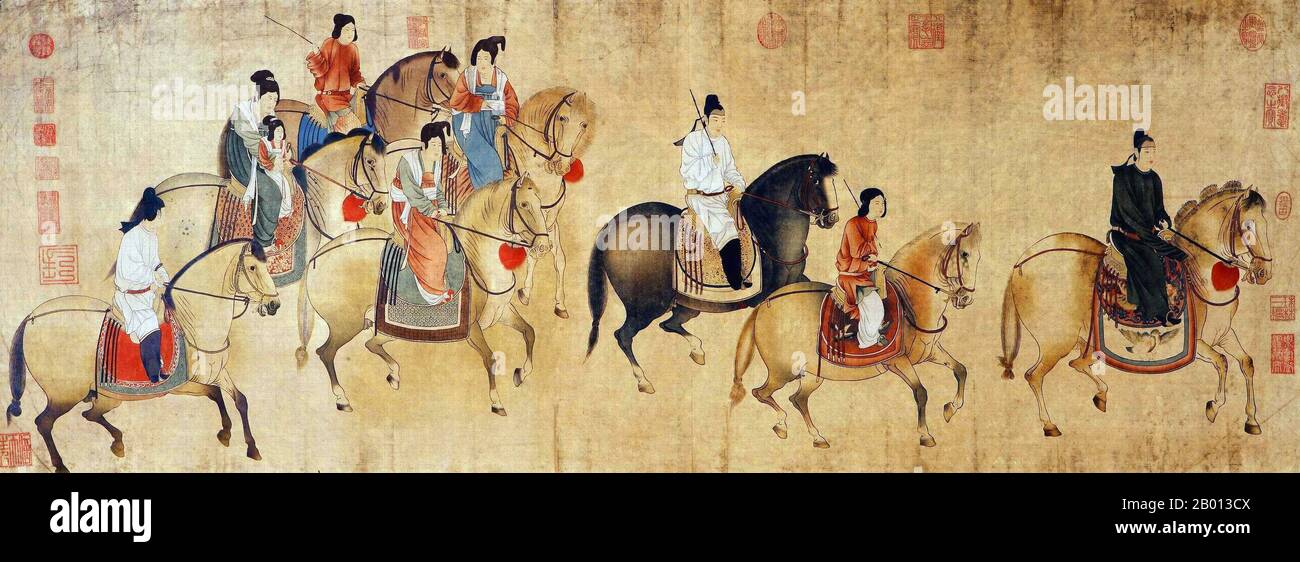 China: 'Spring Outing of the Tang Court'. Handscroll painting by Zhang Xuan (713-755), 8th century. Zhang Xuan, who flourished during the reign of Tang Emperor Xuanzong (712-756), painted many pieces of art, one of his best known paintings is 'Court Ladies Preparing Newly-Woven Silk', of which a single copy survives, painted by Emperor Huizong of Song (r. 1100–1125) in the early 12th century. He also painted the ,Spring Outing of the Tang Court,, which was later remade by Li Gonglin. Stock Photohttps://www.alamy.com/image-license-details/?v=1https://www.alamy.com/china-spring-outing-of-the-tang-court-handscroll-painting-by-zhang-xuan-713-755-8th-century-zhang-xuan-who-flourished-during-the-reign-of-tang-emperor-xuanzong-712-756-painted-many-pieces-of-art-one-of-his-best-known-paintings-is-court-ladies-preparing-newly-woven-silk-of-which-a-single-copy-survives-painted-by-emperor-huizong-of-song-r-11001125-in-the-early-12th-century-he-also-painted-the-spring-outing-of-the-tang-court-which-was-later-remade-by-li-gonglin-image344232026.html
China: 'Spring Outing of the Tang Court'. Handscroll painting by Zhang Xuan (713-755), 8th century. Zhang Xuan, who flourished during the reign of Tang Emperor Xuanzong (712-756), painted many pieces of art, one of his best known paintings is 'Court Ladies Preparing Newly-Woven Silk', of which a single copy survives, painted by Emperor Huizong of Song (r. 1100–1125) in the early 12th century. He also painted the ,Spring Outing of the Tang Court,, which was later remade by Li Gonglin. Stock Photohttps://www.alamy.com/image-license-details/?v=1https://www.alamy.com/china-spring-outing-of-the-tang-court-handscroll-painting-by-zhang-xuan-713-755-8th-century-zhang-xuan-who-flourished-during-the-reign-of-tang-emperor-xuanzong-712-756-painted-many-pieces-of-art-one-of-his-best-known-paintings-is-court-ladies-preparing-newly-woven-silk-of-which-a-single-copy-survives-painted-by-emperor-huizong-of-song-r-11001125-in-the-early-12th-century-he-also-painted-the-spring-outing-of-the-tang-court-which-was-later-remade-by-li-gonglin-image344232026.htmlRM2B013CX–China: 'Spring Outing of the Tang Court'. Handscroll painting by Zhang Xuan (713-755), 8th century. Zhang Xuan, who flourished during the reign of Tang Emperor Xuanzong (712-756), painted many pieces of art, one of his best known paintings is 'Court Ladies Preparing Newly-Woven Silk', of which a single copy survives, painted by Emperor Huizong of Song (r. 1100–1125) in the early 12th century. He also painted the ,Spring Outing of the Tang Court,, which was later remade by Li Gonglin.
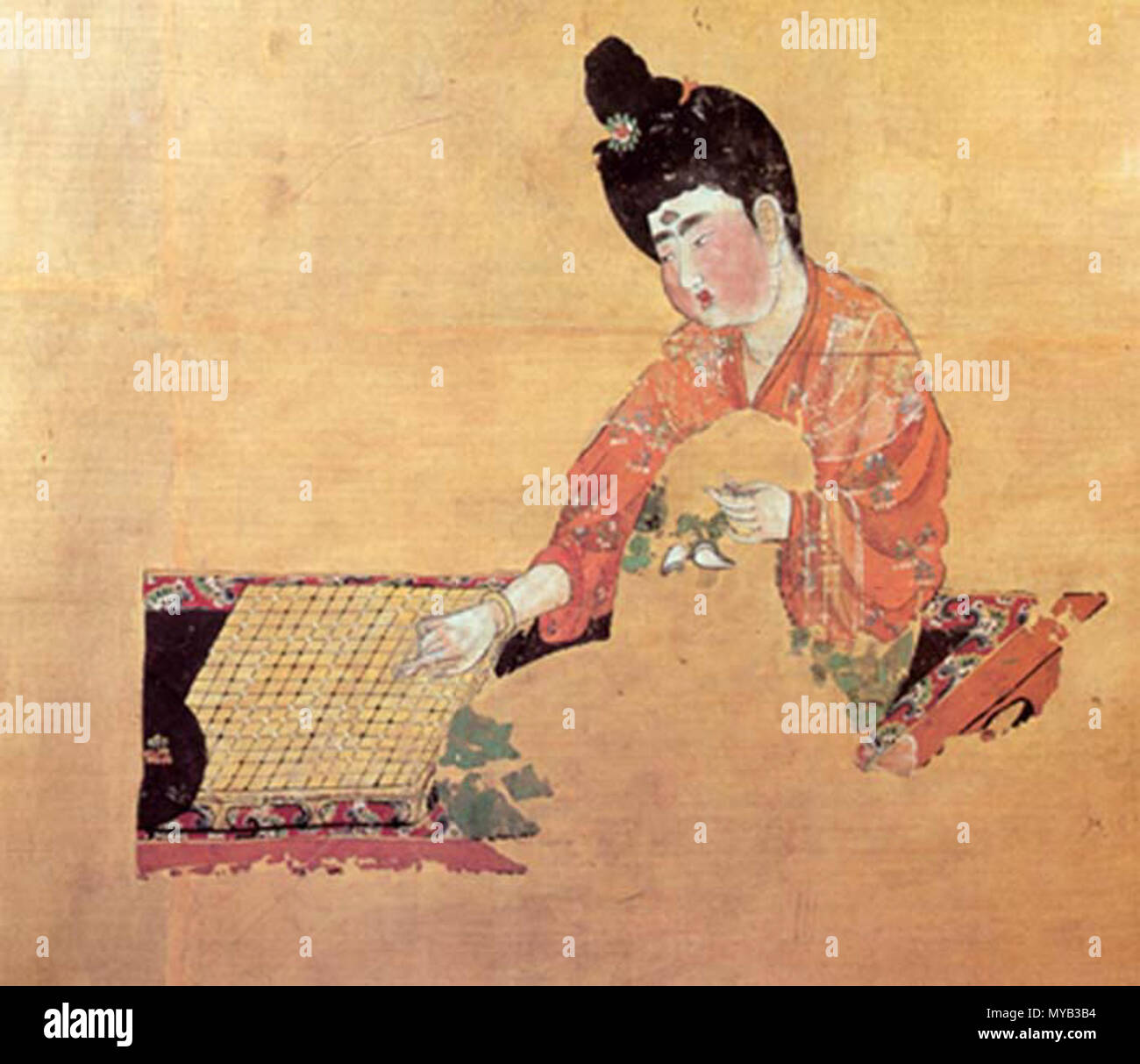 . 'Beauty Playing Go', a painting by an unknown Chinese artist of the Tang Dynasty period; the painting shows a woman playing Go. 7th-10th Century, Tang Dynasty. Unknown 68 Beauty playing Go (Tang Dynasty) Stock Photohttps://www.alamy.com/image-license-details/?v=1https://www.alamy.com/beauty-playing-go-a-painting-by-an-unknown-chinese-artist-of-the-tang-dynasty-period-the-painting-shows-a-woman-playing-go-7th-10th-century-tang-dynasty-unknown-68-beauty-playing-go-tang-dynasty-image188943528.html
. 'Beauty Playing Go', a painting by an unknown Chinese artist of the Tang Dynasty period; the painting shows a woman playing Go. 7th-10th Century, Tang Dynasty. Unknown 68 Beauty playing Go (Tang Dynasty) Stock Photohttps://www.alamy.com/image-license-details/?v=1https://www.alamy.com/beauty-playing-go-a-painting-by-an-unknown-chinese-artist-of-the-tang-dynasty-period-the-painting-shows-a-woman-playing-go-7th-10th-century-tang-dynasty-unknown-68-beauty-playing-go-tang-dynasty-image188943528.htmlRMMYB3B4–. 'Beauty Playing Go', a painting by an unknown Chinese artist of the Tang Dynasty period; the painting shows a woman playing Go. 7th-10th Century, Tang Dynasty. Unknown 68 Beauty playing Go (Tang Dynasty)
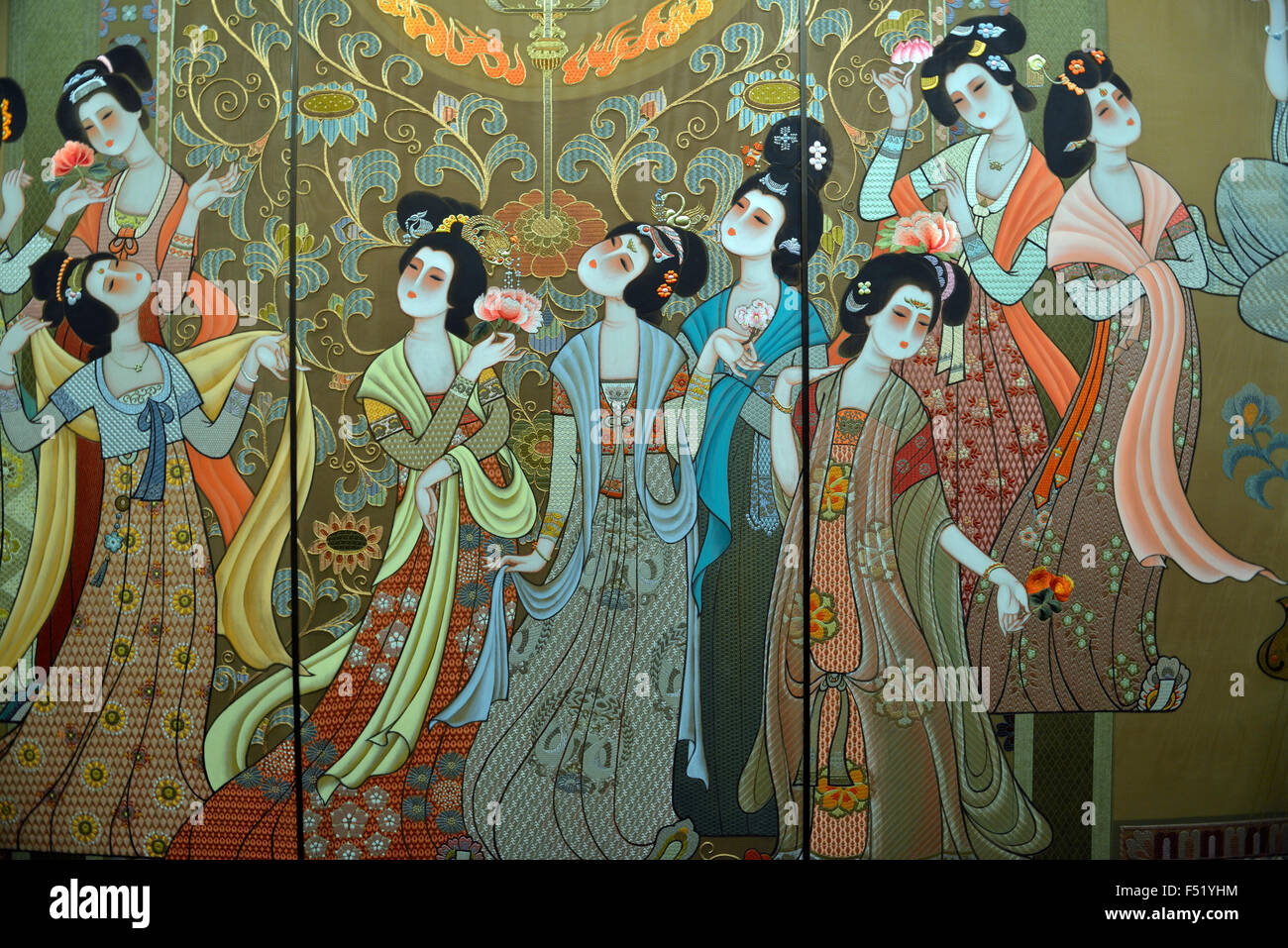 Part of Embroidered painting mural 'Tang Music and Dance' by Fang Eqin in 1987. Shanxi museum in Xian. Stock Photohttps://www.alamy.com/image-license-details/?v=1https://www.alamy.com/stock-photo-part-of-embroidered-painting-mural-tang-music-and-dance-by-fang-eqin-89168736.html
Part of Embroidered painting mural 'Tang Music and Dance' by Fang Eqin in 1987. Shanxi museum in Xian. Stock Photohttps://www.alamy.com/image-license-details/?v=1https://www.alamy.com/stock-photo-part-of-embroidered-painting-mural-tang-music-and-dance-by-fang-eqin-89168736.htmlRMF51YHM–Part of Embroidered painting mural 'Tang Music and Dance' by Fang Eqin in 1987. Shanxi museum in Xian.
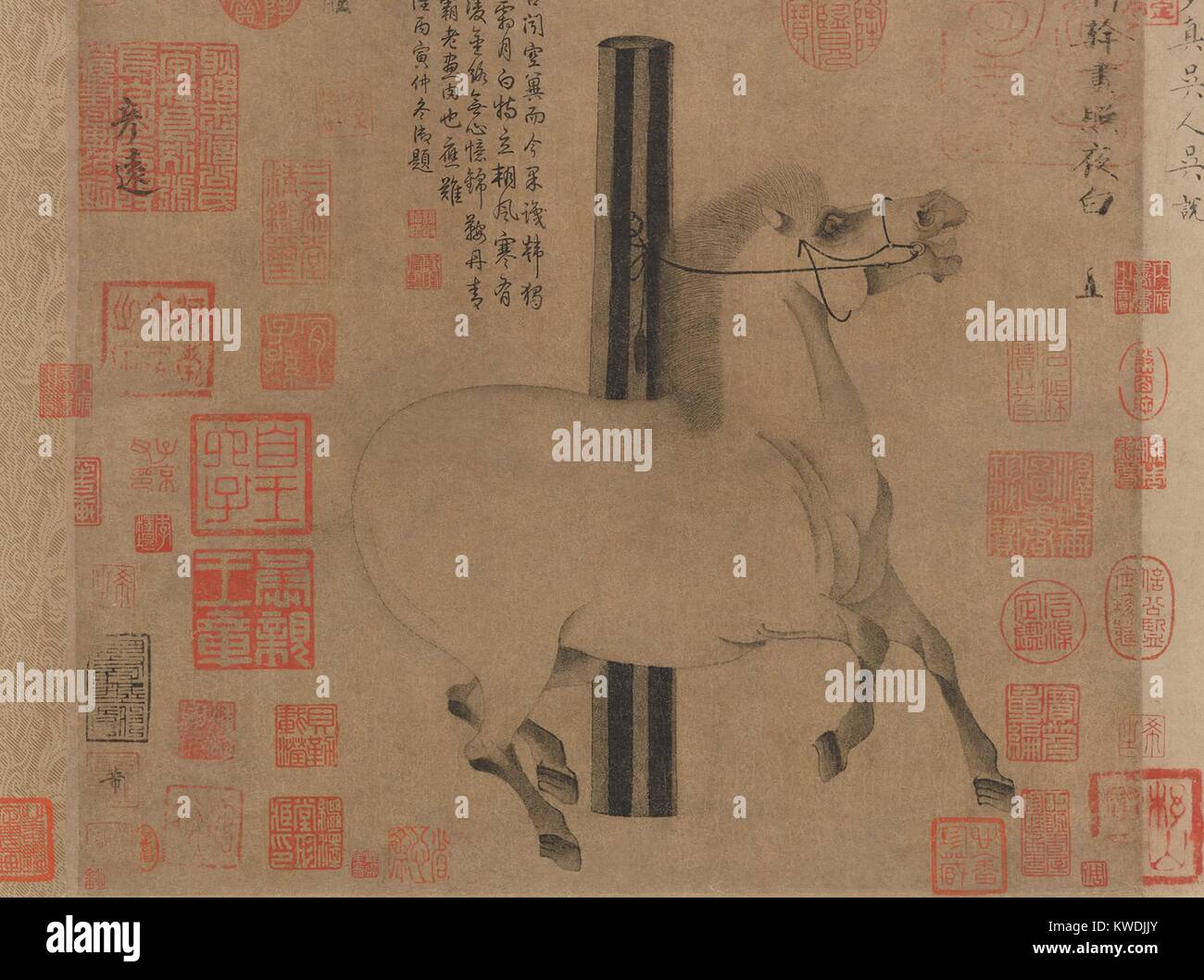 NIGHT SHINING WHITE, by Han Gan, 743-756, Chinese, Tang dynasty, painting, ink on paper. The animated horse of 8th century Emperor Xuanzong is portrayed with flaring nostrils and raised hoofs. This is the most famous work by Han Gan, the leading horse painter of his time. The seals and inscriptions added by later owners are a custom of Chinese connoisseurship (BSLOC 2017 16 6) Stock Photohttps://www.alamy.com/image-license-details/?v=1https://www.alamy.com/stock-photo-night-shining-white-by-han-gan-743-756-chinese-tang-dynasty-painting-170559731.html
NIGHT SHINING WHITE, by Han Gan, 743-756, Chinese, Tang dynasty, painting, ink on paper. The animated horse of 8th century Emperor Xuanzong is portrayed with flaring nostrils and raised hoofs. This is the most famous work by Han Gan, the leading horse painter of his time. The seals and inscriptions added by later owners are a custom of Chinese connoisseurship (BSLOC 2017 16 6) Stock Photohttps://www.alamy.com/image-license-details/?v=1https://www.alamy.com/stock-photo-night-shining-white-by-han-gan-743-756-chinese-tang-dynasty-painting-170559731.htmlRMKWDJJY–NIGHT SHINING WHITE, by Han Gan, 743-756, Chinese, Tang dynasty, painting, ink on paper. The animated horse of 8th century Emperor Xuanzong is portrayed with flaring nostrils and raised hoofs. This is the most famous work by Han Gan, the leading horse painter of his time. The seals and inscriptions added by later owners are a custom of Chinese connoisseurship (BSLOC 2017 16 6)
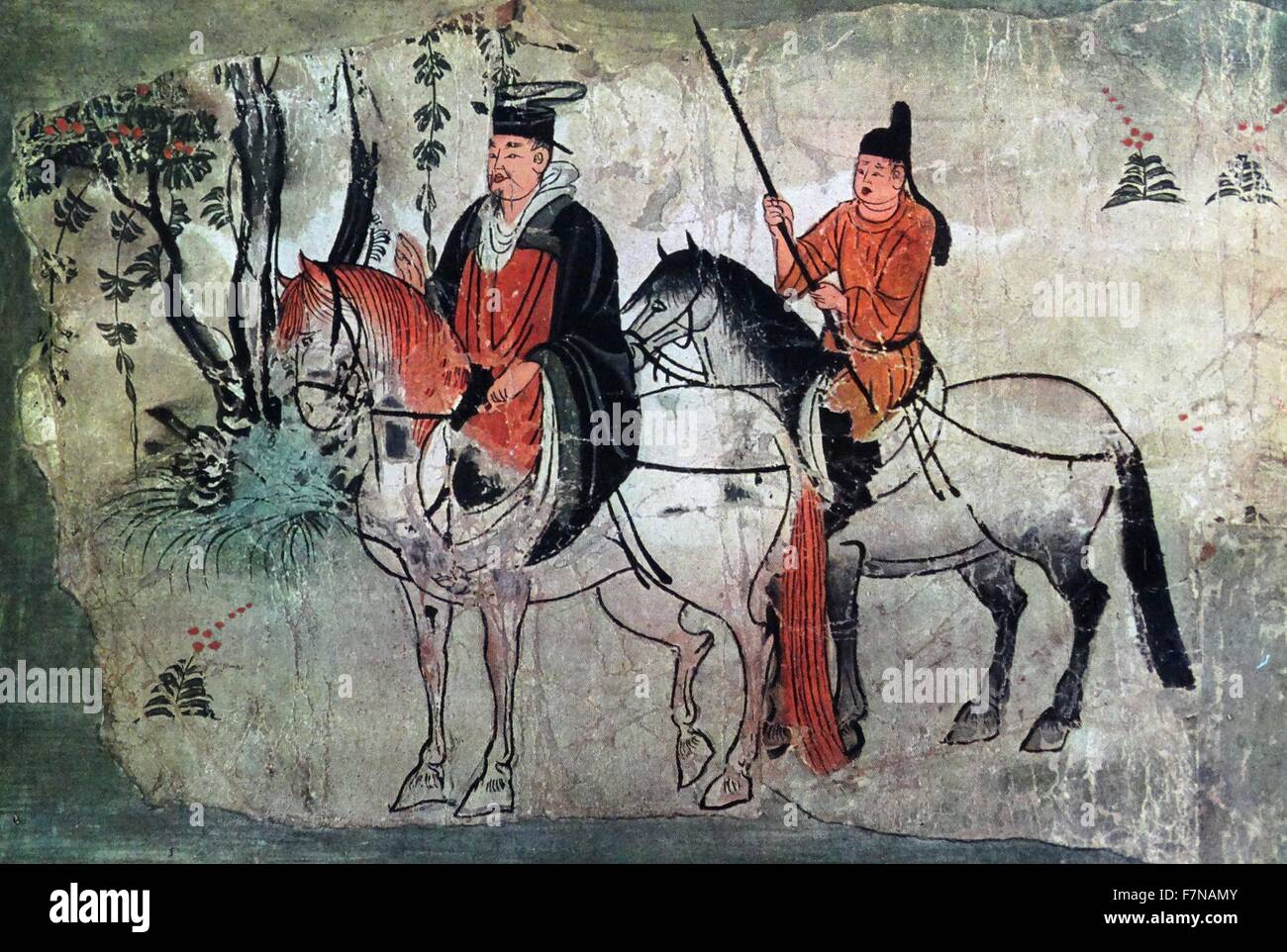 Two Horsemen in a Landscape, (The Boddhisatva and his page). Chinese; Tang Dynasty, (painted stone), 7th century. Stock Photohttps://www.alamy.com/image-license-details/?v=1https://www.alamy.com/stock-photo-two-horsemen-in-a-landscape-the-boddhisatva-and-his-page-chinese-tang-90823851.html
Two Horsemen in a Landscape, (The Boddhisatva and his page). Chinese; Tang Dynasty, (painted stone), 7th century. Stock Photohttps://www.alamy.com/image-license-details/?v=1https://www.alamy.com/stock-photo-two-horsemen-in-a-landscape-the-boddhisatva-and-his-page-chinese-tang-90823851.htmlRMF7NAMY–Two Horsemen in a Landscape, (The Boddhisatva and his page). Chinese; Tang Dynasty, (painted stone), 7th century.
 The Moon Goddess Chang E, Unidentified Artist, After Tang Yin Stock Photohttps://www.alamy.com/image-license-details/?v=1https://www.alamy.com/stock-image-the-moon-goddess-chang-e-unidentified-artist-after-tang-yin-162537149.html
The Moon Goddess Chang E, Unidentified Artist, After Tang Yin Stock Photohttps://www.alamy.com/image-license-details/?v=1https://www.alamy.com/stock-image-the-moon-goddess-chang-e-unidentified-artist-after-tang-yin-162537149.htmlRMKCC5P5–The Moon Goddess Chang E, Unidentified Artist, After Tang Yin
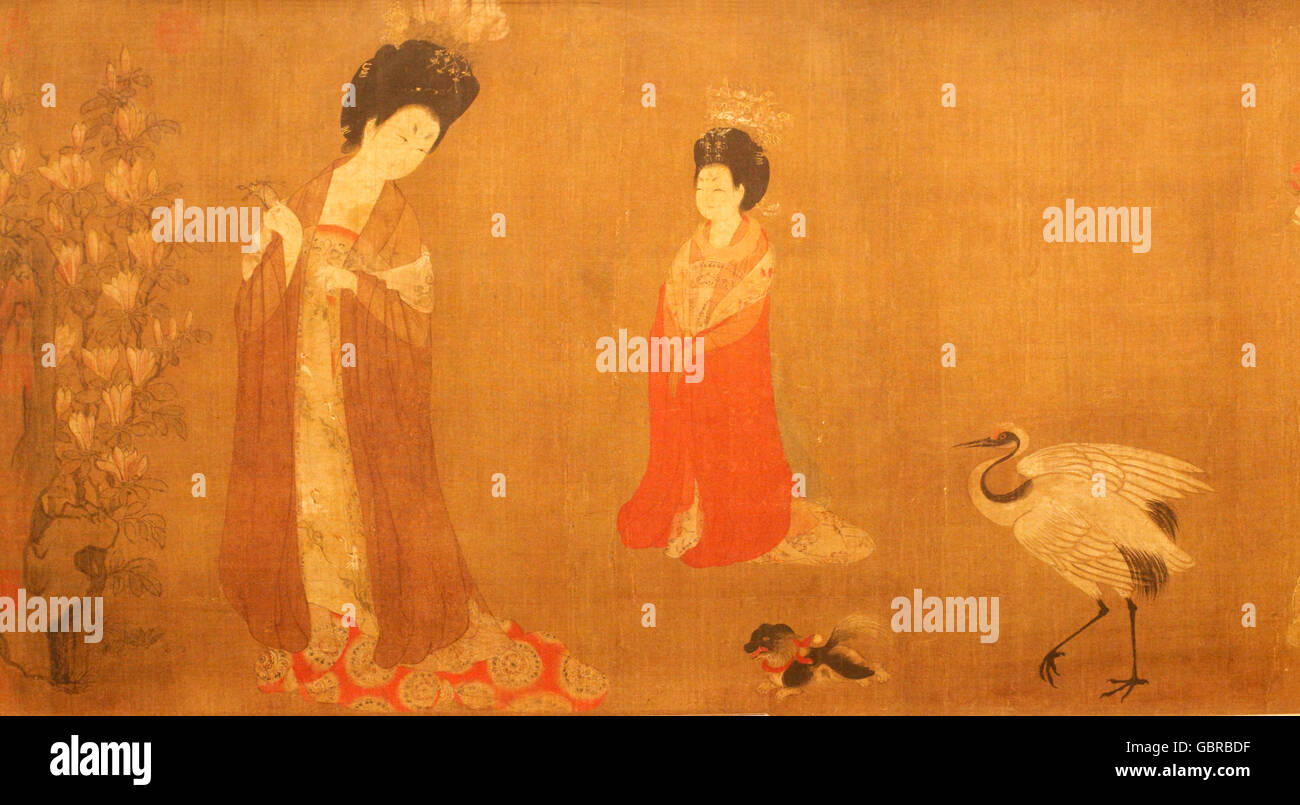 Zanhua had Stock Photohttps://www.alamy.com/image-license-details/?v=1https://www.alamy.com/stock-photo-zanhua-had-110537323.html
Zanhua had Stock Photohttps://www.alamy.com/image-license-details/?v=1https://www.alamy.com/stock-photo-zanhua-had-110537323.htmlRFGBRBDF–Zanhua had
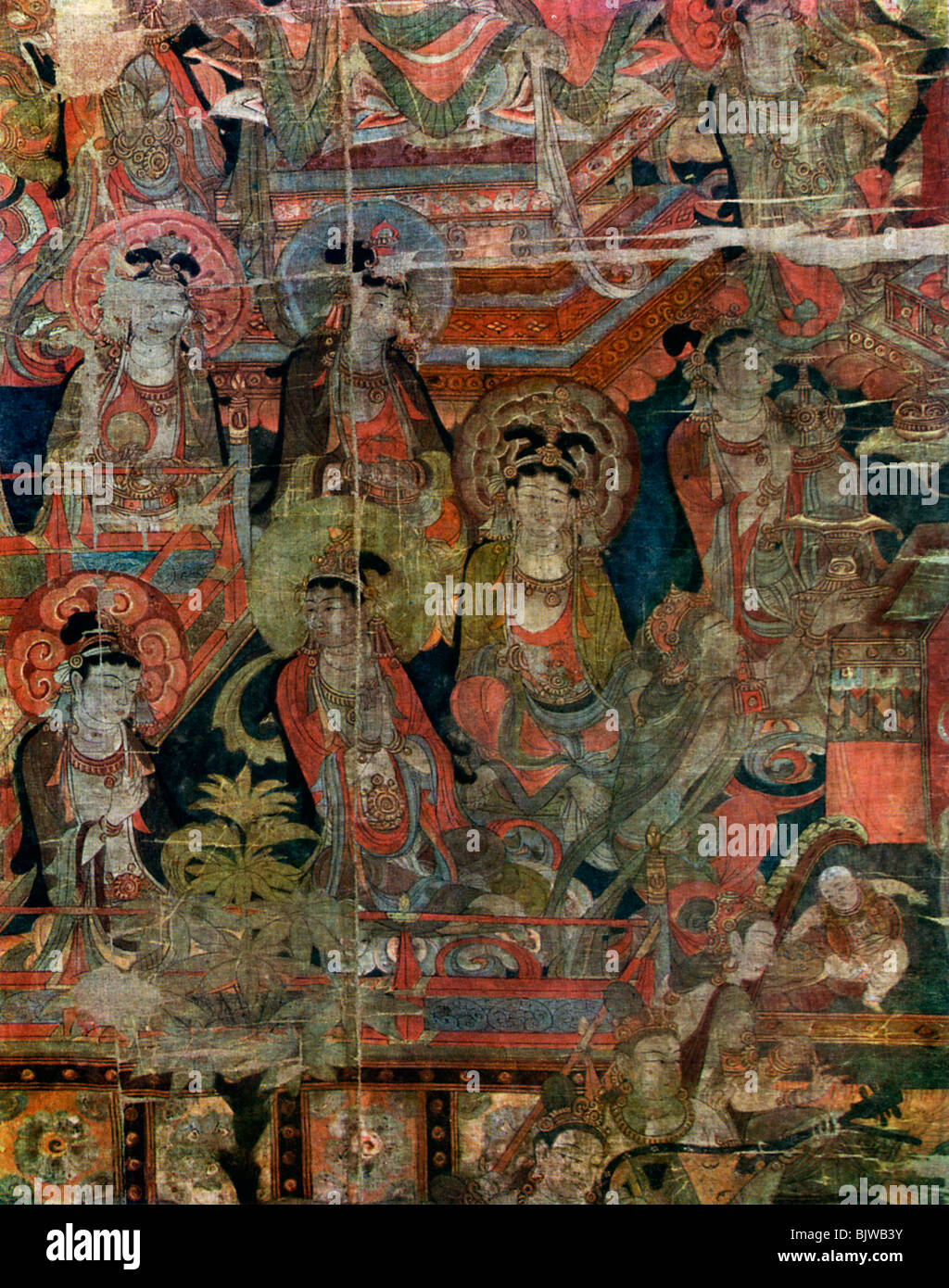 Detail of a picture of Paradise, Chinese, Tang dynasty, 618-907 (1925). Artist: Unknown Stock Photohttps://www.alamy.com/image-license-details/?v=1https://www.alamy.com/stock-photo-detail-of-a-picture-of-paradise-chinese-tang-dynasty-618-907-1925-28831711.html
Detail of a picture of Paradise, Chinese, Tang dynasty, 618-907 (1925). Artist: Unknown Stock Photohttps://www.alamy.com/image-license-details/?v=1https://www.alamy.com/stock-photo-detail-of-a-picture-of-paradise-chinese-tang-dynasty-618-907-1925-28831711.htmlRMBJWB3Y–Detail of a picture of Paradise, Chinese, Tang dynasty, 618-907 (1925). Artist: Unknown
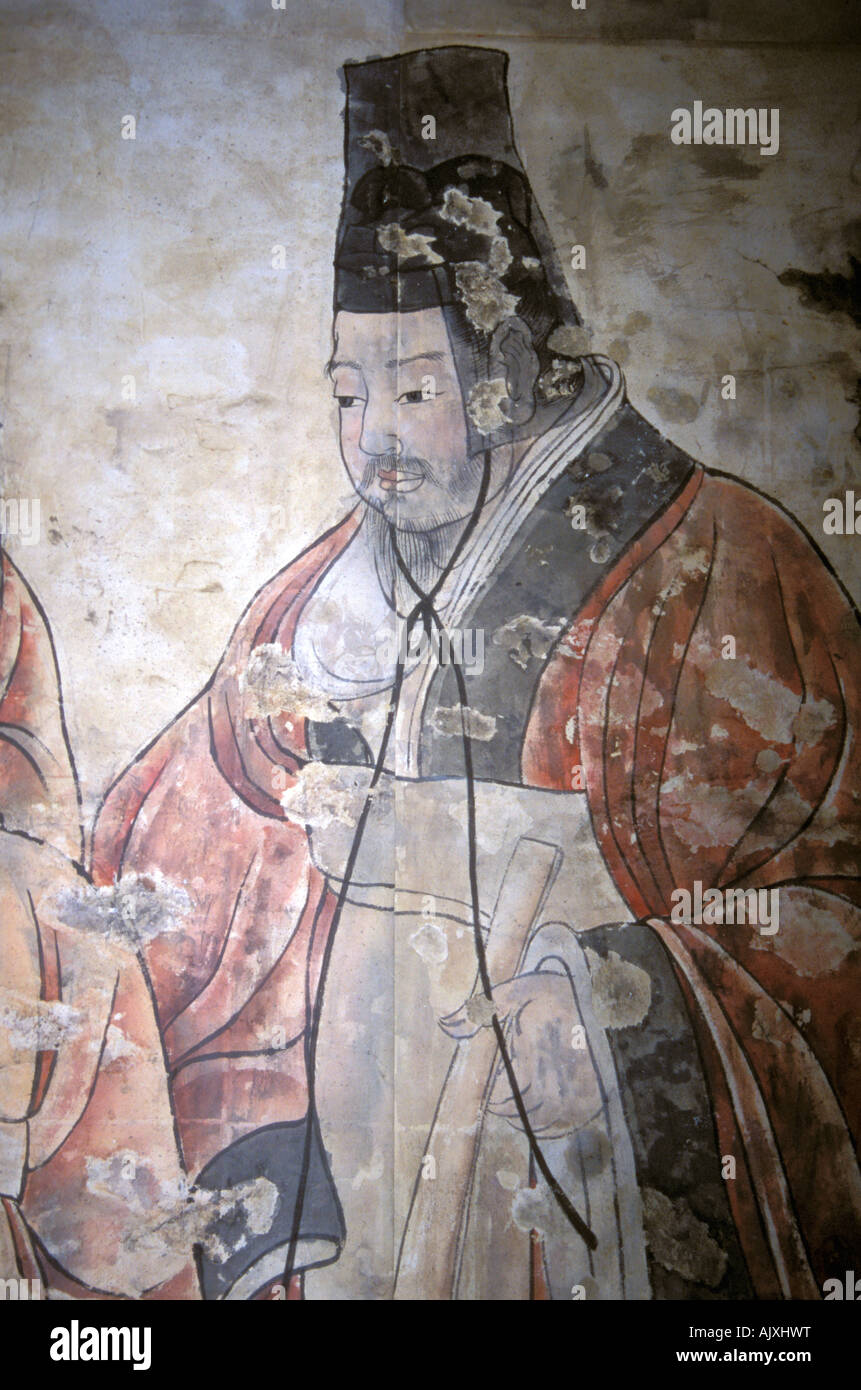 Asia, China, Xian. Ban Po Museum, Tang dynasty art collection - painting of Chinese man in traditional dress of era. Stock Photohttps://www.alamy.com/image-license-details/?v=1https://www.alamy.com/stock-photo-asia-china-xian-ban-po-museum-tang-dynasty-art-collection-painting-14826755.html
Asia, China, Xian. Ban Po Museum, Tang dynasty art collection - painting of Chinese man in traditional dress of era. Stock Photohttps://www.alamy.com/image-license-details/?v=1https://www.alamy.com/stock-photo-asia-china-xian-ban-po-museum-tang-dynasty-art-collection-painting-14826755.htmlRFAJXHWT–Asia, China, Xian. Ban Po Museum, Tang dynasty art collection - painting of Chinese man in traditional dress of era.
 7th century Tang dynasty painting of envoys from the Three Kingdoms of Korea: Baekje, Goguryeo, and Silla, by Yan Liben Stock Photohttps://www.alamy.com/image-license-details/?v=1https://www.alamy.com/7th-century-tang-dynasty-painting-of-envoys-from-the-three-kingdoms-of-korea-baekje-goguryeo-and-silla-by-yan-liben-image573255780.html
7th century Tang dynasty painting of envoys from the Three Kingdoms of Korea: Baekje, Goguryeo, and Silla, by Yan Liben Stock Photohttps://www.alamy.com/image-license-details/?v=1https://www.alamy.com/7th-century-tang-dynasty-painting-of-envoys-from-the-three-kingdoms-of-korea-baekje-goguryeo-and-silla-by-yan-liben-image573255780.htmlRM2T8J1GM–7th century Tang dynasty painting of envoys from the Three Kingdoms of Korea: Baekje, Goguryeo, and Silla, by Yan Liben
 Lady Su Hui and Her Verse Puzzle. Artist: In the style of Qiu Ying (Chinese, ca. 1495-1552). Culture: China. Dimensions: Image: 10 1/16 in. x 10 ft. 2 3/4 in. (25.6 x 311.8 cm). Date: 16th century. This scene appears in a later copy of a Tang-dynasty painting illustrating the story of a literary legend, Lady Su Hui, who was supposed to have lived in the late fourth century. The dating of the original painting is supported by the types of instruments depicted in it. Both the harp (konghou) and the pipa played with a plectrum disappeared after the Tang. Front row, left to right: qin, pipa, pip Stock Photohttps://www.alamy.com/image-license-details/?v=1https://www.alamy.com/lady-su-hui-and-her-verse-puzzle-artist-in-the-style-of-qiu-ying-chinese-ca-1495-1552-culture-china-dimensions-image-10-116-in-x-10-ft-2-34-in-256-x-3118-cm-date-16th-century-this-scene-appears-in-a-later-copy-of-a-tang-dynasty-painting-illustrating-the-story-of-a-literary-legend-lady-su-hui-who-was-supposed-to-have-lived-in-the-late-fourth-century-the-dating-of-the-original-painting-is-supported-by-the-types-of-instruments-depicted-in-it-both-the-harp-konghou-and-the-pipa-played-with-a-plectrum-disappeared-after-the-tang-front-row-left-to-right-qin-pipa-pip-image213104870.html
Lady Su Hui and Her Verse Puzzle. Artist: In the style of Qiu Ying (Chinese, ca. 1495-1552). Culture: China. Dimensions: Image: 10 1/16 in. x 10 ft. 2 3/4 in. (25.6 x 311.8 cm). Date: 16th century. This scene appears in a later copy of a Tang-dynasty painting illustrating the story of a literary legend, Lady Su Hui, who was supposed to have lived in the late fourth century. The dating of the original painting is supported by the types of instruments depicted in it. Both the harp (konghou) and the pipa played with a plectrum disappeared after the Tang. Front row, left to right: qin, pipa, pip Stock Photohttps://www.alamy.com/image-license-details/?v=1https://www.alamy.com/lady-su-hui-and-her-verse-puzzle-artist-in-the-style-of-qiu-ying-chinese-ca-1495-1552-culture-china-dimensions-image-10-116-in-x-10-ft-2-34-in-256-x-3118-cm-date-16th-century-this-scene-appears-in-a-later-copy-of-a-tang-dynasty-painting-illustrating-the-story-of-a-literary-legend-lady-su-hui-who-was-supposed-to-have-lived-in-the-late-fourth-century-the-dating-of-the-original-painting-is-supported-by-the-types-of-instruments-depicted-in-it-both-the-harp-konghou-and-the-pipa-played-with-a-plectrum-disappeared-after-the-tang-front-row-left-to-right-qin-pipa-pip-image213104870.htmlRMPAKNC6–Lady Su Hui and Her Verse Puzzle. Artist: In the style of Qiu Ying (Chinese, ca. 1495-1552). Culture: China. Dimensions: Image: 10 1/16 in. x 10 ft. 2 3/4 in. (25.6 x 311.8 cm). Date: 16th century. This scene appears in a later copy of a Tang-dynasty painting illustrating the story of a literary legend, Lady Su Hui, who was supposed to have lived in the late fourth century. The dating of the original painting is supported by the types of instruments depicted in it. Both the harp (konghou) and the pipa played with a plectrum disappeared after the Tang. Front row, left to right: qin, pipa, pip
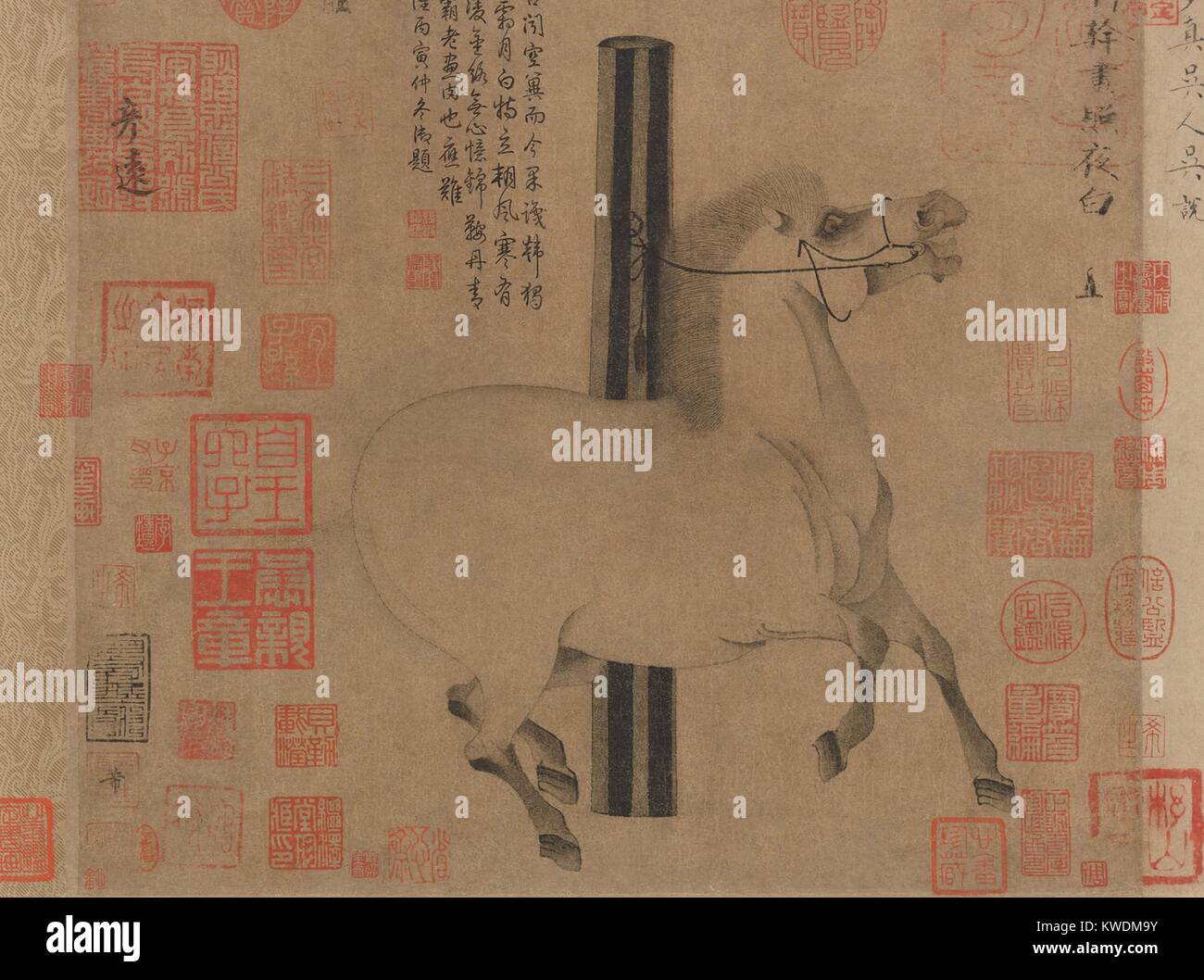 NIGHT SHINING WHITE, by Han Gan, 743-756, Chinese, Tang dynasty, painting, ink on paper. The animated horse of 8th century Emperor Xuanzong is portrayed with flaring nostrils and raised hoofs. This is the most famous work by Han Gan, the leading horse painter of his time. The seals and inscriptions added by later owners are a custom of Chinese connoisseurship (BSLOC 2017 16 6) Stock Photohttps://www.alamy.com/image-license-details/?v=1https://www.alamy.com/stock-photo-night-shining-white-by-han-gan-743-756-chinese-tang-dynasty-painting-170561047.html
NIGHT SHINING WHITE, by Han Gan, 743-756, Chinese, Tang dynasty, painting, ink on paper. The animated horse of 8th century Emperor Xuanzong is portrayed with flaring nostrils and raised hoofs. This is the most famous work by Han Gan, the leading horse painter of his time. The seals and inscriptions added by later owners are a custom of Chinese connoisseurship (BSLOC 2017 16 6) Stock Photohttps://www.alamy.com/image-license-details/?v=1https://www.alamy.com/stock-photo-night-shining-white-by-han-gan-743-756-chinese-tang-dynasty-painting-170561047.htmlRMKWDM9Y–NIGHT SHINING WHITE, by Han Gan, 743-756, Chinese, Tang dynasty, painting, ink on paper. The animated horse of 8th century Emperor Xuanzong is portrayed with flaring nostrils and raised hoofs. This is the most famous work by Han Gan, the leading horse painter of his time. The seals and inscriptions added by later owners are a custom of Chinese connoisseurship (BSLOC 2017 16 6)
 Tang Dynasty figurine of a horse. glazed white with traces of vermilion and ink painting. It stands upright on a rectangular platform. The horse is strong and has short legs and a large head in proportion. The head is straight, the eyes are open, the eyes are looking forward, the mouth is open and hissing, the sideburns are drooping to the left, the tail is upturned, and the limbs are stable. The eyes are drawn with vermilion and ink, and the lines of the muscles on the horse's face are very realistic. Stock Photohttps://www.alamy.com/image-license-details/?v=1https://www.alamy.com/tang-dynasty-figurine-of-a-horse-glazed-white-with-traces-of-vermilion-and-ink-painting-it-stands-upright-on-a-rectangular-platform-the-horse-is-strong-and-has-short-legs-and-a-large-head-in-proportion-the-head-is-straight-the-eyes-are-open-the-eyes-are-looking-forward-the-mouth-is-open-and-hissing-the-sideburns-are-drooping-to-the-left-the-tail-is-upturned-and-the-limbs-are-stable-the-eyes-are-drawn-with-vermilion-and-ink-and-the-lines-of-the-muscles-on-the-horses-face-are-very-realistic-image481969658.html
Tang Dynasty figurine of a horse. glazed white with traces of vermilion and ink painting. It stands upright on a rectangular platform. The horse is strong and has short legs and a large head in proportion. The head is straight, the eyes are open, the eyes are looking forward, the mouth is open and hissing, the sideburns are drooping to the left, the tail is upturned, and the limbs are stable. The eyes are drawn with vermilion and ink, and the lines of the muscles on the horse's face are very realistic. Stock Photohttps://www.alamy.com/image-license-details/?v=1https://www.alamy.com/tang-dynasty-figurine-of-a-horse-glazed-white-with-traces-of-vermilion-and-ink-painting-it-stands-upright-on-a-rectangular-platform-the-horse-is-strong-and-has-short-legs-and-a-large-head-in-proportion-the-head-is-straight-the-eyes-are-open-the-eyes-are-looking-forward-the-mouth-is-open-and-hissing-the-sideburns-are-drooping-to-the-left-the-tail-is-upturned-and-the-limbs-are-stable-the-eyes-are-drawn-with-vermilion-and-ink-and-the-lines-of-the-muscles-on-the-horses-face-are-very-realistic-image481969658.htmlRM2K03H62–Tang Dynasty figurine of a horse. glazed white with traces of vermilion and ink painting. It stands upright on a rectangular platform. The horse is strong and has short legs and a large head in proportion. The head is straight, the eyes are open, the eyes are looking forward, the mouth is open and hissing, the sideburns are drooping to the left, the tail is upturned, and the limbs are stable. The eyes are drawn with vermilion and ink, and the lines of the muscles on the horse's face are very realistic.
 Murals picturing soldiers on horseback on the wall of the Qianling Mausoleum, a Tang Dynasty (618–907) tomb site located in Qian County, Shaanxi provi Stock Photohttps://www.alamy.com/image-license-details/?v=1https://www.alamy.com/murals-picturing-soldiers-on-horseback-on-the-wall-of-the-qianling-mausoleum-a-tang-dynasty-618907-tomb-site-located-in-qian-county-shaanxi-provi-image344181144.html
Murals picturing soldiers on horseback on the wall of the Qianling Mausoleum, a Tang Dynasty (618–907) tomb site located in Qian County, Shaanxi provi Stock Photohttps://www.alamy.com/image-license-details/?v=1https://www.alamy.com/murals-picturing-soldiers-on-horseback-on-the-wall-of-the-qianling-mausoleum-a-tang-dynasty-618907-tomb-site-located-in-qian-county-shaanxi-provi-image344181144.htmlRM2AYXPFM–Murals picturing soldiers on horseback on the wall of the Qianling Mausoleum, a Tang Dynasty (618–907) tomb site located in Qian County, Shaanxi provi
 Buddha fresco painting Tang Dynasty 8 Century AD Xinjiang China sanctuary Duldur aqur Qumtura Stock Photohttps://www.alamy.com/image-license-details/?v=1https://www.alamy.com/stock-photo-buddha-fresco-painting-tang-dynasty-8-century-ad-xinjiang-china-sanctuary-43420410.html
Buddha fresco painting Tang Dynasty 8 Century AD Xinjiang China sanctuary Duldur aqur Qumtura Stock Photohttps://www.alamy.com/image-license-details/?v=1https://www.alamy.com/stock-photo-buddha-fresco-painting-tang-dynasty-8-century-ad-xinjiang-china-sanctuary-43420410.htmlRMCEHY4X–Buddha fresco painting Tang Dynasty 8 Century AD Xinjiang China sanctuary Duldur aqur Qumtura
 geography / travel, China, Datong, province Shanxi, Yungang caves, fifth / sixth century AD, cave no. 6, Stock Photohttps://www.alamy.com/image-license-details/?v=1https://www.alamy.com/stock-photo-geography-travel-china-datong-province-shanxi-yungang-caves-fifth-11694898.html
geography / travel, China, Datong, province Shanxi, Yungang caves, fifth / sixth century AD, cave no. 6, Stock Photohttps://www.alamy.com/image-license-details/?v=1https://www.alamy.com/stock-photo-geography-travel-china-datong-province-shanxi-yungang-caves-fifth-11694898.htmlRMA71MWR–geography / travel, China, Datong, province Shanxi, Yungang caves, fifth / sixth century AD, cave no. 6,
 replica of the Dunhuang Murals Stock Photohttps://www.alamy.com/image-license-details/?v=1https://www.alamy.com/stock-photo-replica-of-the-dunhuang-murals-137477732.html
replica of the Dunhuang Murals Stock Photohttps://www.alamy.com/image-license-details/?v=1https://www.alamy.com/stock-photo-replica-of-the-dunhuang-murals-137477732.htmlRFHYJJ70–replica of the Dunhuang Murals
 A Fair Hermit In Mount Lo-Fou. Attributed to To-in (Tang Yin). Tang Yin (Chinese: 唐寅; pinyin: Táng Yín; Cantonese Yale: Tong Yan; 1470–1524), courtes Stock Photohttps://www.alamy.com/image-license-details/?v=1https://www.alamy.com/a-fair-hermit-in-mount-lo-fou-attributed-to-to-in-tang-yin-tang-yin-chinese-pinyin-tng-yn-cantonese-yale-tong-yan-14701524-courtes-image457381517.html
A Fair Hermit In Mount Lo-Fou. Attributed to To-in (Tang Yin). Tang Yin (Chinese: 唐寅; pinyin: Táng Yín; Cantonese Yale: Tong Yan; 1470–1524), courtes Stock Photohttps://www.alamy.com/image-license-details/?v=1https://www.alamy.com/a-fair-hermit-in-mount-lo-fou-attributed-to-to-in-tang-yin-tang-yin-chinese-pinyin-tng-yn-cantonese-yale-tong-yan-14701524-courtes-image457381517.htmlRM2HG3EP5–A Fair Hermit In Mount Lo-Fou. Attributed to To-in (Tang Yin). Tang Yin (Chinese: 唐寅; pinyin: Táng Yín; Cantonese Yale: Tong Yan; 1470–1524), courtes
 Scenes from the life of the Chinese Emperor Xuanzong of Tang (685-762), and his Consort Yang Guifei (719-756), painting by Kano Mitsunobu, 1580-1608 Stock Photohttps://www.alamy.com/image-license-details/?v=1https://www.alamy.com/scenes-from-the-life-of-the-chineseemperor-xuanzong-of-tang-685-762-and-his-consort-yang-guifei-719-756-painting-by-kano-mitsunobu-1580-1608-image425453218.html
Scenes from the life of the Chinese Emperor Xuanzong of Tang (685-762), and his Consort Yang Guifei (719-756), painting by Kano Mitsunobu, 1580-1608 Stock Photohttps://www.alamy.com/image-license-details/?v=1https://www.alamy.com/scenes-from-the-life-of-the-chineseemperor-xuanzong-of-tang-685-762-and-his-consort-yang-guifei-719-756-painting-by-kano-mitsunobu-1580-1608-image425453218.htmlRM2FM51WP–Scenes from the life of the Chinese Emperor Xuanzong of Tang (685-762), and his Consort Yang Guifei (719-756), painting by Kano Mitsunobu, 1580-1608
 China: 'Court Ladies Wearing Flowered Headdresses'. Detail of handscroll painting by Zhou Fang (c. 730-800), late 8th century. Consort Yang Yuhuan (719-756), often known as Yang Guifei (Guifei being the highest rank for imperial consorts), known briefly by the Taoist nun name Taizhen, is famous as one of the Four Beauties of ancient China. She was the beloved consort of Emperor Xuanzong of Tang during his later years. During the Anshi Rebellion, as Emperor Xuanzong was fleeing from the capital Chang'an, she was murdered because his guards blamed her cousin Yang Guozhong for the rebellion. Stock Photohttps://www.alamy.com/image-license-details/?v=1https://www.alamy.com/china-court-ladies-wearing-flowered-headdresses-detail-of-handscroll-painting-by-zhou-fang-c-730-800-late-8th-century-consort-yang-yuhuan-719-756-often-known-as-yang-guifei-guifei-being-the-highest-rank-for-imperial-consorts-known-briefly-by-the-taoist-nun-name-taizhen-is-famous-as-one-of-the-four-beauties-of-ancient-china-she-was-the-beloved-consort-of-emperor-xuanzong-of-tang-during-his-later-years-during-the-anshi-rebellion-as-emperor-xuanzong-was-fleeing-from-the-capital-changan-she-was-murdered-because-his-guards-blamed-her-cousin-yang-guozhong-for-the-rebellion-image344232023.html
China: 'Court Ladies Wearing Flowered Headdresses'. Detail of handscroll painting by Zhou Fang (c. 730-800), late 8th century. Consort Yang Yuhuan (719-756), often known as Yang Guifei (Guifei being the highest rank for imperial consorts), known briefly by the Taoist nun name Taizhen, is famous as one of the Four Beauties of ancient China. She was the beloved consort of Emperor Xuanzong of Tang during his later years. During the Anshi Rebellion, as Emperor Xuanzong was fleeing from the capital Chang'an, she was murdered because his guards blamed her cousin Yang Guozhong for the rebellion. Stock Photohttps://www.alamy.com/image-license-details/?v=1https://www.alamy.com/china-court-ladies-wearing-flowered-headdresses-detail-of-handscroll-painting-by-zhou-fang-c-730-800-late-8th-century-consort-yang-yuhuan-719-756-often-known-as-yang-guifei-guifei-being-the-highest-rank-for-imperial-consorts-known-briefly-by-the-taoist-nun-name-taizhen-is-famous-as-one-of-the-four-beauties-of-ancient-china-she-was-the-beloved-consort-of-emperor-xuanzong-of-tang-during-his-later-years-during-the-anshi-rebellion-as-emperor-xuanzong-was-fleeing-from-the-capital-changan-she-was-murdered-because-his-guards-blamed-her-cousin-yang-guozhong-for-the-rebellion-image344232023.htmlRM2B013CR–China: 'Court Ladies Wearing Flowered Headdresses'. Detail of handscroll painting by Zhou Fang (c. 730-800), late 8th century. Consort Yang Yuhuan (719-756), often known as Yang Guifei (Guifei being the highest rank for imperial consorts), known briefly by the Taoist nun name Taizhen, is famous as one of the Four Beauties of ancient China. She was the beloved consort of Emperor Xuanzong of Tang during his later years. During the Anshi Rebellion, as Emperor Xuanzong was fleeing from the capital Chang'an, she was murdered because his guards blamed her cousin Yang Guozhong for the rebellion.
 . 'Beauty Playing Go', a painting by an unknown Chinese artist of the Tang Dynasty period; the painting shows a woman playing Go. 7th-10th Century, Tang Dynasty. Unknown 78 Beauty playing Go (Tang Dynasty) Stock Photohttps://www.alamy.com/image-license-details/?v=1https://www.alamy.com/beauty-playing-go-a-painting-by-an-unknown-chinese-artist-of-the-tang-dynasty-period-the-painting-shows-a-woman-playing-go-7th-10th-century-tang-dynasty-unknown-78-beauty-playing-go-tang-dynasty-image188194536.html
. 'Beauty Playing Go', a painting by an unknown Chinese artist of the Tang Dynasty period; the painting shows a woman playing Go. 7th-10th Century, Tang Dynasty. Unknown 78 Beauty playing Go (Tang Dynasty) Stock Photohttps://www.alamy.com/image-license-details/?v=1https://www.alamy.com/beauty-playing-go-a-painting-by-an-unknown-chinese-artist-of-the-tang-dynasty-period-the-painting-shows-a-woman-playing-go-7th-10th-century-tang-dynasty-unknown-78-beauty-playing-go-tang-dynasty-image188194536.htmlRMMX501C–. 'Beauty Playing Go', a painting by an unknown Chinese artist of the Tang Dynasty period; the painting shows a woman playing Go. 7th-10th Century, Tang Dynasty. Unknown 78 Beauty playing Go (Tang Dynasty)
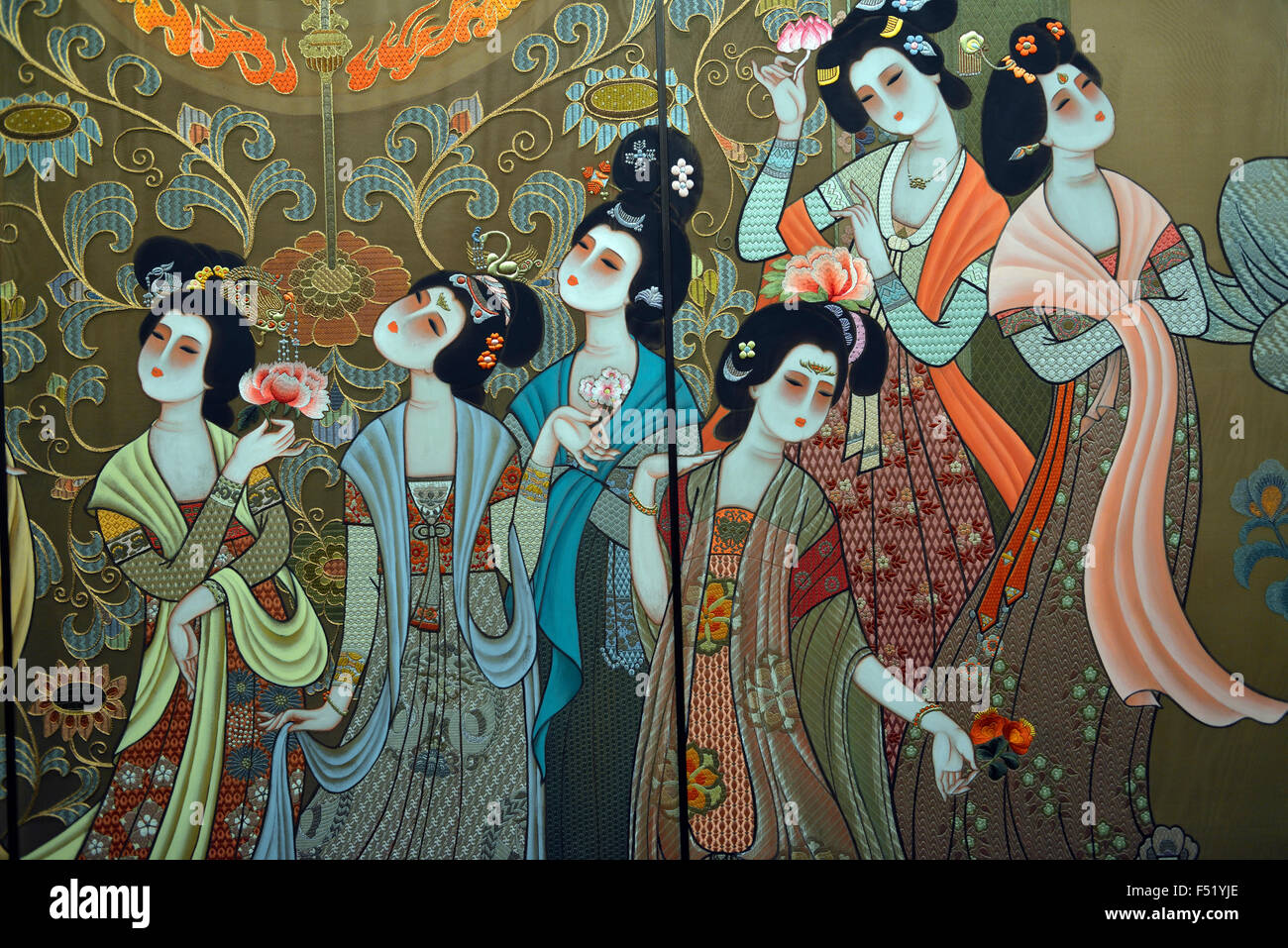 Part of Embroidered painting mural 'Tang Music and Dance' by Fang Eqin in 1987. Shanxi museum in Xian. Stock Photohttps://www.alamy.com/image-license-details/?v=1https://www.alamy.com/stock-photo-part-of-embroidered-painting-mural-tang-music-and-dance-by-fang-eqin-89168758.html
Part of Embroidered painting mural 'Tang Music and Dance' by Fang Eqin in 1987. Shanxi museum in Xian. Stock Photohttps://www.alamy.com/image-license-details/?v=1https://www.alamy.com/stock-photo-part-of-embroidered-painting-mural-tang-music-and-dance-by-fang-eqin-89168758.htmlRMF51YJE–Part of Embroidered painting mural 'Tang Music and Dance' by Fang Eqin in 1987. Shanxi museum in Xian.
 . In this close-up detail of a landscape painting, the young Sakyamuni cuts off his hair while attendants watch, ink and color on silk, from Dunhuang, Gansu province, China, dated to the Tang Dynasty (618–907 AD) . Tang Dynasty (618–907 AD). Chinese artist 539 Sakyamuni cuts his hair, detail, Tang Dynasty Stock Photohttps://www.alamy.com/image-license-details/?v=1https://www.alamy.com/in-this-close-up-detail-of-a-landscape-painting-the-young-sakyamuni-cuts-off-his-hair-while-attendants-watch-ink-and-color-on-silk-from-dunhuang-gansu-province-china-dated-to-the-tang-dynasty-618907-ad-tang-dynasty-618907-ad-chinese-artist-539-sakyamuni-cuts-his-hair-detail-tang-dynasty-image188358809.html
. In this close-up detail of a landscape painting, the young Sakyamuni cuts off his hair while attendants watch, ink and color on silk, from Dunhuang, Gansu province, China, dated to the Tang Dynasty (618–907 AD) . Tang Dynasty (618–907 AD). Chinese artist 539 Sakyamuni cuts his hair, detail, Tang Dynasty Stock Photohttps://www.alamy.com/image-license-details/?v=1https://www.alamy.com/in-this-close-up-detail-of-a-landscape-painting-the-young-sakyamuni-cuts-off-his-hair-while-attendants-watch-ink-and-color-on-silk-from-dunhuang-gansu-province-china-dated-to-the-tang-dynasty-618907-ad-tang-dynasty-618907-ad-chinese-artist-539-sakyamuni-cuts-his-hair-detail-tang-dynasty-image188358809.htmlRMMXCDG9–. In this close-up detail of a landscape painting, the young Sakyamuni cuts off his hair while attendants watch, ink and color on silk, from Dunhuang, Gansu province, China, dated to the Tang Dynasty (618–907 AD) . Tang Dynasty (618–907 AD). Chinese artist 539 Sakyamuni cuts his hair, detail, Tang Dynasty
 China: Portrait of the scholar Fu Sheng. Handscroll painting by painter Wang Wei (699-759), c. 720-760 CE. Wang Wei (also known as Wang Youcheng, 699-759), was a Tang Dynasty Chinese poet, musician, painter, and statesman. He was one of the most famous men of arts and letters of his time. His paintings survive only in later copies by other artists, although nevertheless very influential in terms of Tang Dynasty painting and subsequent Chinese painting. Many of his poems are preserved, and twenty-nine were included in the highly influential 18th century anthology 'Three Hundred Tang Poems'. Stock Photohttps://www.alamy.com/image-license-details/?v=1https://www.alamy.com/china-portrait-of-the-scholar-fu-sheng-handscroll-painting-by-painter-wang-wei-699-759-c-720-760-ce-wang-wei-also-known-as-wang-youcheng-699-759-was-a-tang-dynasty-chinese-poet-musician-painter-and-statesman-he-was-one-of-the-most-famous-men-of-arts-and-letters-of-his-time-his-paintings-survive-only-in-later-copies-by-other-artists-although-nevertheless-very-influential-in-terms-of-tang-dynasty-painting-and-subsequent-chinese-painting-many-of-his-poems-are-preserved-and-twenty-nine-were-included-in-the-highly-influential-18th-century-anthology-three-hundred-tang-poems-image344233664.html
China: Portrait of the scholar Fu Sheng. Handscroll painting by painter Wang Wei (699-759), c. 720-760 CE. Wang Wei (also known as Wang Youcheng, 699-759), was a Tang Dynasty Chinese poet, musician, painter, and statesman. He was one of the most famous men of arts and letters of his time. His paintings survive only in later copies by other artists, although nevertheless very influential in terms of Tang Dynasty painting and subsequent Chinese painting. Many of his poems are preserved, and twenty-nine were included in the highly influential 18th century anthology 'Three Hundred Tang Poems'. Stock Photohttps://www.alamy.com/image-license-details/?v=1https://www.alamy.com/china-portrait-of-the-scholar-fu-sheng-handscroll-painting-by-painter-wang-wei-699-759-c-720-760-ce-wang-wei-also-known-as-wang-youcheng-699-759-was-a-tang-dynasty-chinese-poet-musician-painter-and-statesman-he-was-one-of-the-most-famous-men-of-arts-and-letters-of-his-time-his-paintings-survive-only-in-later-copies-by-other-artists-although-nevertheless-very-influential-in-terms-of-tang-dynasty-painting-and-subsequent-chinese-painting-many-of-his-poems-are-preserved-and-twenty-nine-were-included-in-the-highly-influential-18th-century-anthology-three-hundred-tang-poems-image344233664.htmlRM2B015FC–China: Portrait of the scholar Fu Sheng. Handscroll painting by painter Wang Wei (699-759), c. 720-760 CE. Wang Wei (also known as Wang Youcheng, 699-759), was a Tang Dynasty Chinese poet, musician, painter, and statesman. He was one of the most famous men of arts and letters of his time. His paintings survive only in later copies by other artists, although nevertheless very influential in terms of Tang Dynasty painting and subsequent Chinese painting. Many of his poems are preserved, and twenty-nine were included in the highly influential 18th century anthology 'Three Hundred Tang Poems'.
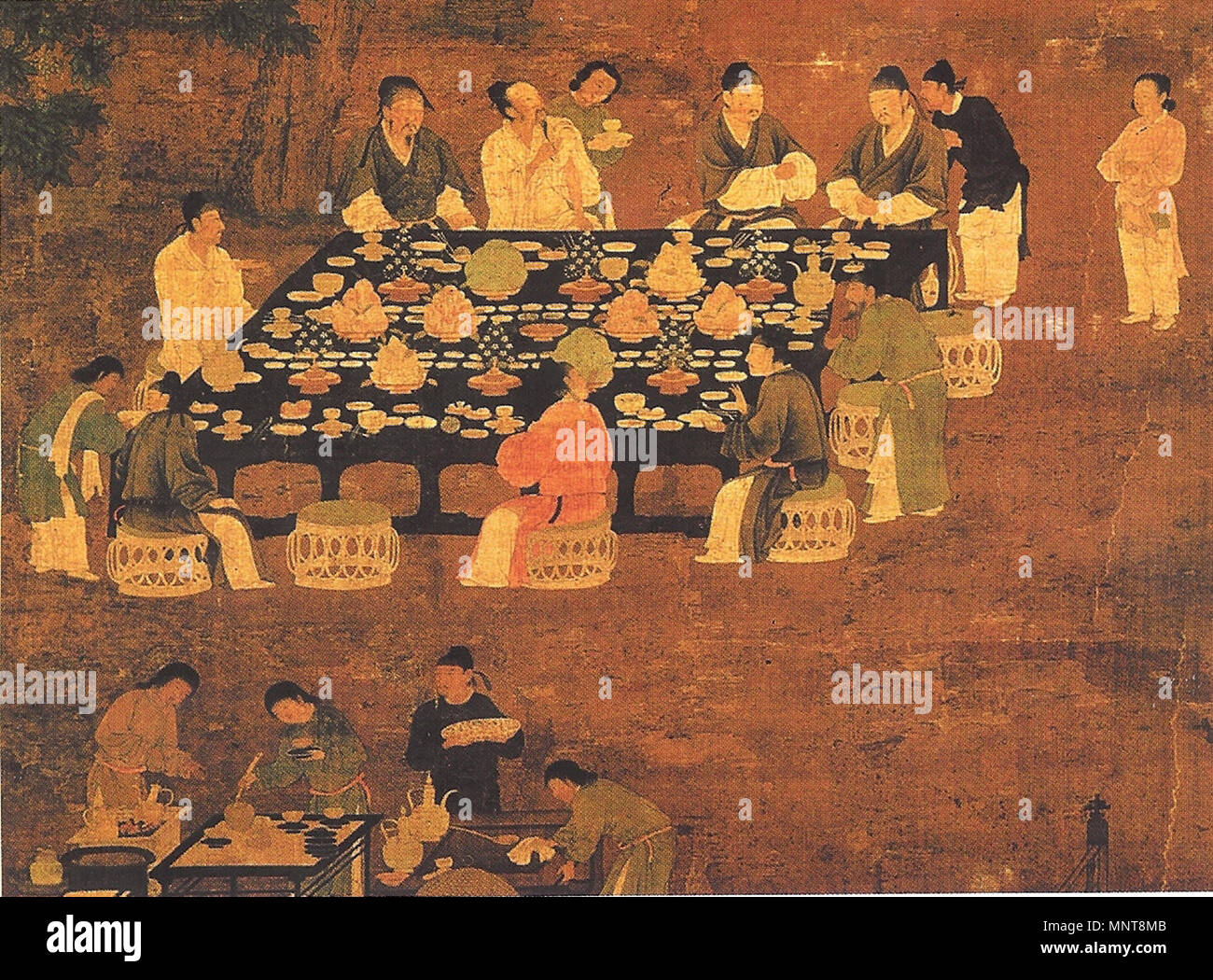 . An Elegant Party (detail), an outdoor painting of a small Chinese banquet hosted by the emperor for scholar-officials from the Song Dynasty (960-1279). Although painted in the Song period, it is most likely a reproduction of an earlier Tang Dynasty (618-907) work of art. The painting is attributed to Emperor Huizong of Song (r. 1100–1125 AD). 6 August 2007. PericlesofAthens 1131 Song Dynasty Elegant Party Stock Photohttps://www.alamy.com/image-license-details/?v=1https://www.alamy.com/an-elegant-party-detail-an-outdoor-painting-of-a-small-chinese-banquet-hosted-by-the-emperor-for-scholar-officials-from-the-song-dynasty-960-1279-although-painted-in-the-song-period-it-is-most-likely-a-reproduction-of-an-earlier-tang-dynasty-618-907-work-of-art-the-painting-is-attributed-to-emperor-huizong-of-song-r-11001125-ad-6-august-2007-periclesofathens-1131-song-dynasty-elegant-party-image185545147.html
. An Elegant Party (detail), an outdoor painting of a small Chinese banquet hosted by the emperor for scholar-officials from the Song Dynasty (960-1279). Although painted in the Song period, it is most likely a reproduction of an earlier Tang Dynasty (618-907) work of art. The painting is attributed to Emperor Huizong of Song (r. 1100–1125 AD). 6 August 2007. PericlesofAthens 1131 Song Dynasty Elegant Party Stock Photohttps://www.alamy.com/image-license-details/?v=1https://www.alamy.com/an-elegant-party-detail-an-outdoor-painting-of-a-small-chinese-banquet-hosted-by-the-emperor-for-scholar-officials-from-the-song-dynasty-960-1279-although-painted-in-the-song-period-it-is-most-likely-a-reproduction-of-an-earlier-tang-dynasty-618-907-work-of-art-the-painting-is-attributed-to-emperor-huizong-of-song-r-11001125-ad-6-august-2007-periclesofathens-1131-song-dynasty-elegant-party-image185545147.htmlRMMNT8MB–. An Elegant Party (detail), an outdoor painting of a small Chinese banquet hosted by the emperor for scholar-officials from the Song Dynasty (960-1279). Although painted in the Song period, it is most likely a reproduction of an earlier Tang Dynasty (618-907) work of art. The painting is attributed to Emperor Huizong of Song (r. 1100–1125 AD). 6 August 2007. PericlesofAthens 1131 Song Dynasty Elegant Party
 南宋 傳李唐 晉文公復國圖 卷, Duke Wen of Jin Recovering His State, Attributed to Li Tang, mid-12th century Stock Photohttps://www.alamy.com/image-license-details/?v=1https://www.alamy.com/stock-image-duke-wen-of-jin-recovering-his-state-attributed-to-li-tang-mid-12th-162407631.html
南宋 傳李唐 晉文公復國圖 卷, Duke Wen of Jin Recovering His State, Attributed to Li Tang, mid-12th century Stock Photohttps://www.alamy.com/image-license-details/?v=1https://www.alamy.com/stock-image-duke-wen-of-jin-recovering-his-state-attributed-to-li-tang-mid-12th-162407631.htmlRMKC68GF–南宋 傳李唐 晉文公復國圖 卷, Duke Wen of Jin Recovering His State, Attributed to Li Tang, mid-12th century
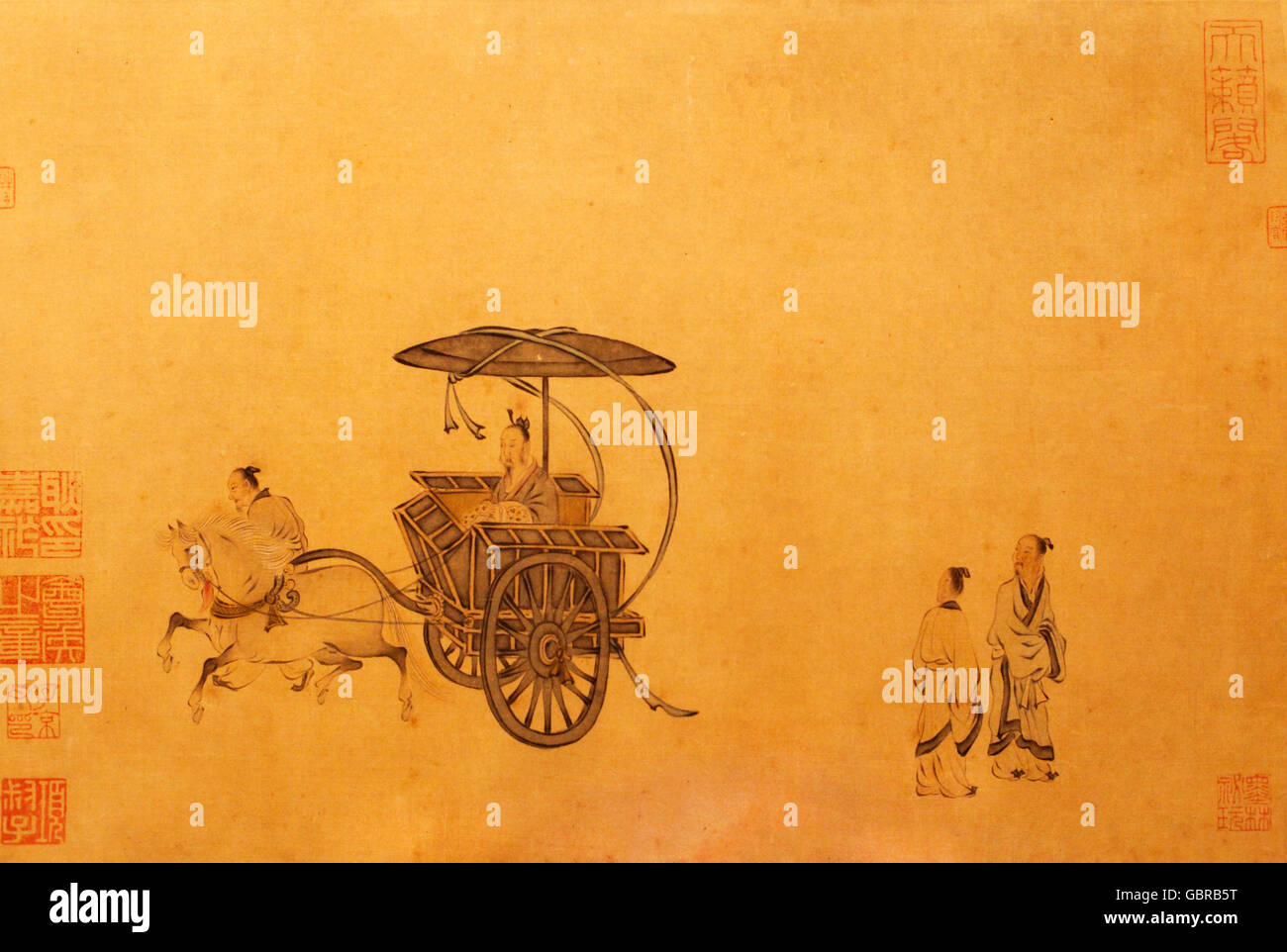 Tang Fengtu Stock Photohttps://www.alamy.com/image-license-details/?v=1https://www.alamy.com/stock-photo-tang-fengtu-110537108.html
Tang Fengtu Stock Photohttps://www.alamy.com/image-license-details/?v=1https://www.alamy.com/stock-photo-tang-fengtu-110537108.htmlRFGBRB5T–Tang Fengtu
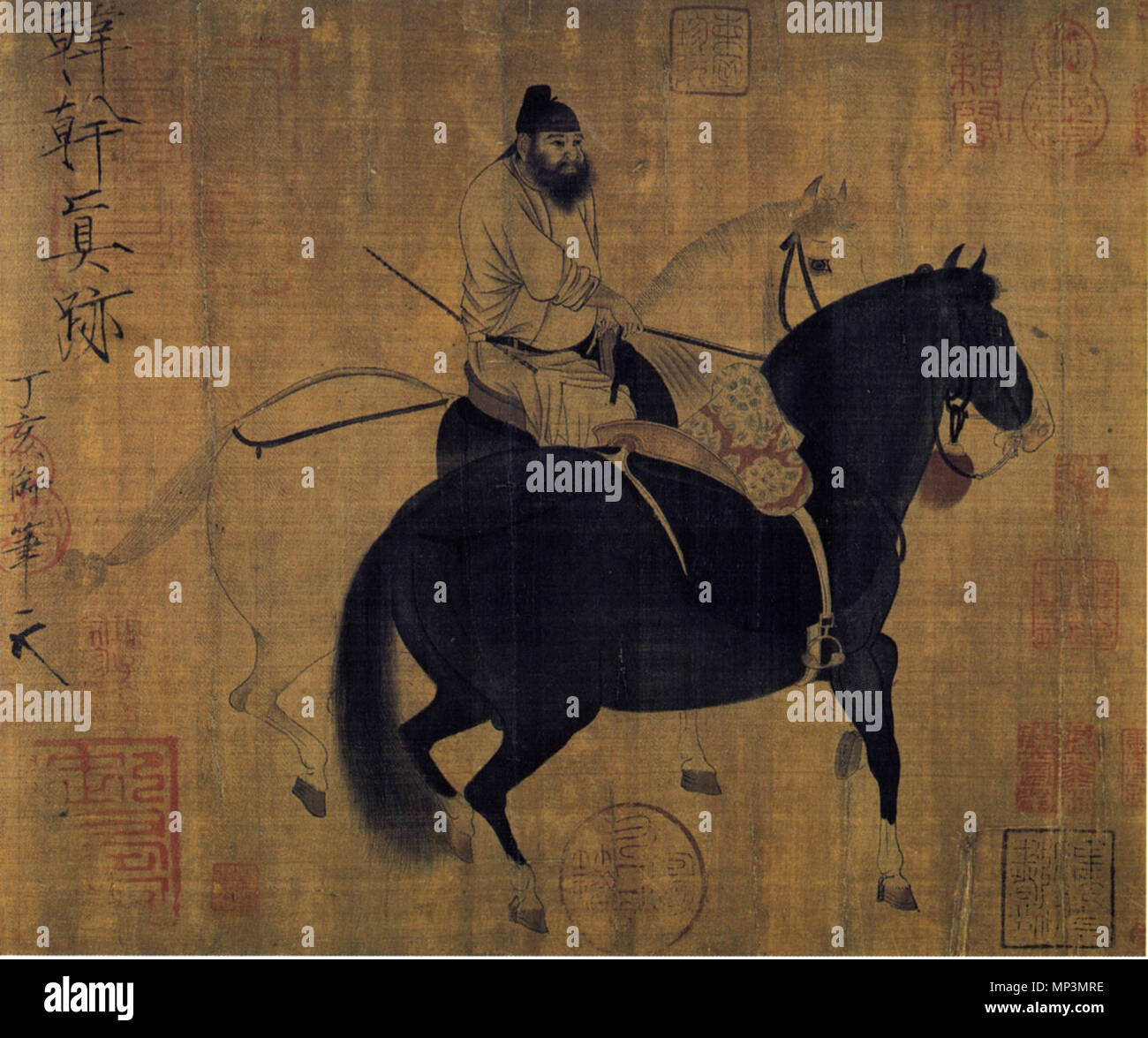 中文: 牧馬圖 English: Herding horses . English: Digitally retouched photograph of a Tang dynasty painting of two prized horses and one rider. Français : Palefrenier menant deux chevaux, encre et couleurs légères sur soie, 27,5 x 34,1 cm, feuille d'album, inscription de l'empereur Song Huizong datée 1107, sceaux de Huizong et d'empereurs ultérieurs. Musée national du Palais, Taipei. Русский: Хан Гань. Всадник. Гугун, Тайбэй . 8th century. 955 Palefrenier menant deux chevaux par Han Gan Stock Photohttps://www.alamy.com/image-license-details/?v=1https://www.alamy.com/english-herding-horses-english-digitally-retouched-photograph-of-a-tang-dynasty-painting-of-two-prized-horses-and-one-rider-franais-palefrenier-menant-deux-chevaux-encre-et-couleurs-lgres-sur-soie-275-x-341-cm-feuille-dalbum-inscription-de-lempereur-song-huizong-date-1107-sceaux-de-huizong-et-dempereurs-ultrieurs-muse-national-du-palais-taipei-8th-century-955-palefrenier-menant-deux-chevaux-par-han-gan-image185708306.html
中文: 牧馬圖 English: Herding horses . English: Digitally retouched photograph of a Tang dynasty painting of two prized horses and one rider. Français : Palefrenier menant deux chevaux, encre et couleurs légères sur soie, 27,5 x 34,1 cm, feuille d'album, inscription de l'empereur Song Huizong datée 1107, sceaux de Huizong et d'empereurs ultérieurs. Musée national du Palais, Taipei. Русский: Хан Гань. Всадник. Гугун, Тайбэй . 8th century. 955 Palefrenier menant deux chevaux par Han Gan Stock Photohttps://www.alamy.com/image-license-details/?v=1https://www.alamy.com/english-herding-horses-english-digitally-retouched-photograph-of-a-tang-dynasty-painting-of-two-prized-horses-and-one-rider-franais-palefrenier-menant-deux-chevaux-encre-et-couleurs-lgres-sur-soie-275-x-341-cm-feuille-dalbum-inscription-de-lempereur-song-huizong-date-1107-sceaux-de-huizong-et-dempereurs-ultrieurs-muse-national-du-palais-taipei-8th-century-955-palefrenier-menant-deux-chevaux-par-han-gan-image185708306.htmlRMMP3MRE–中文: 牧馬圖 English: Herding horses . English: Digitally retouched photograph of a Tang dynasty painting of two prized horses and one rider. Français : Palefrenier menant deux chevaux, encre et couleurs légères sur soie, 27,5 x 34,1 cm, feuille d'album, inscription de l'empereur Song Huizong datée 1107, sceaux de Huizong et d'empereurs ultérieurs. Musée national du Palais, Taipei. Русский: Хан Гань. Всадник. Гугун, Тайбэй . 8th century. 955 Palefrenier menant deux chevaux par Han Gan
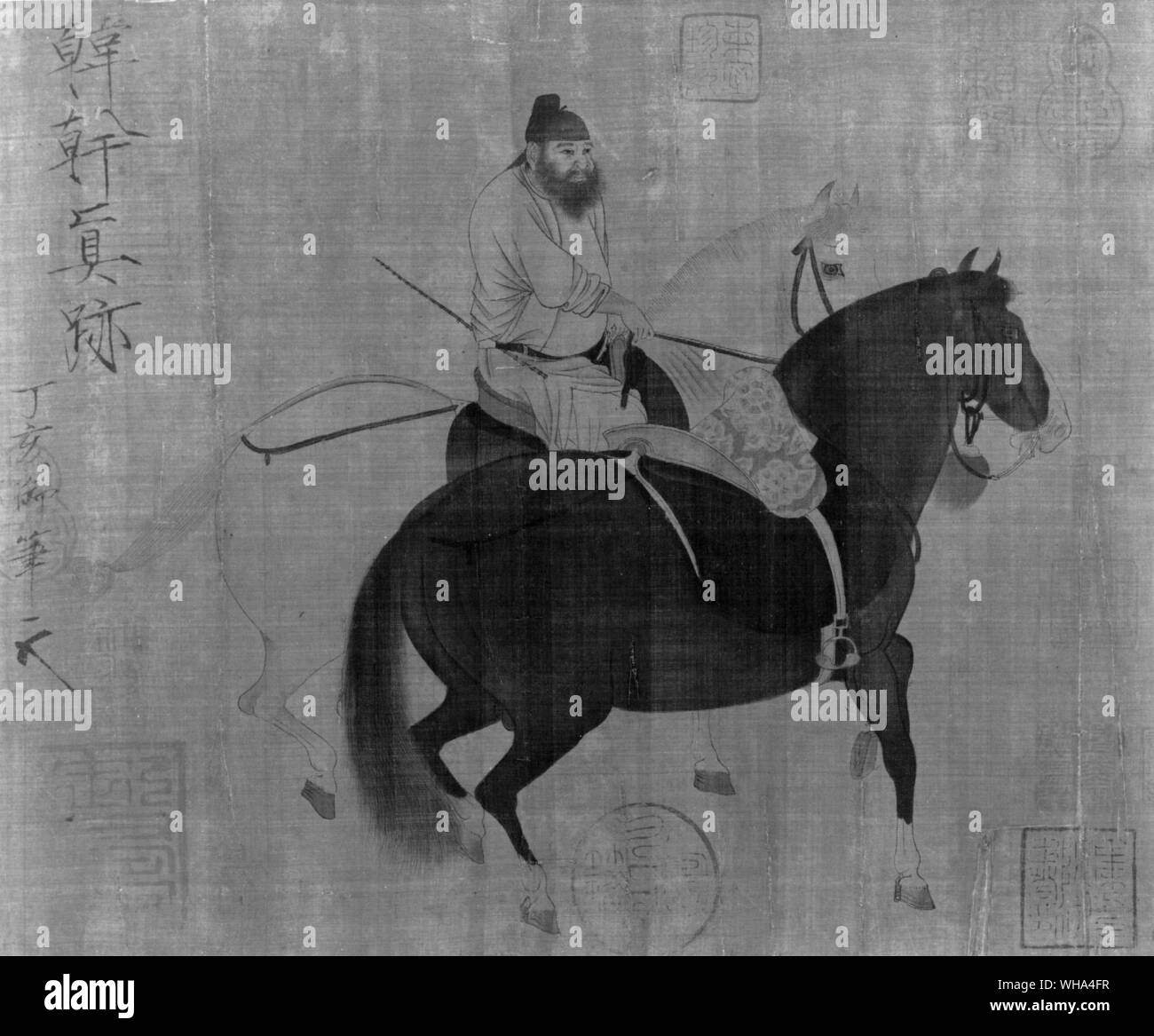 Han Kan. Tang painter 618-906. Han-Kan lived in Chang-an, the capital of the Tang dynasty (618 -907). He painted Buddhist and Taoist wall paintings but became mostly famous for his great compositions of horse paintings which represented the knightly spirit of his time. He is considered one of the greatest classical Chinese master artists of animal painting. Stock Photohttps://www.alamy.com/image-license-details/?v=1https://www.alamy.com/han-kan-tang-painter-618-906-han-kan-lived-in-chang-an-the-capital-of-the-tang-dynasty-618-907-he-painted-buddhist-and-taoist-wall-paintings-but-became-mostly-famous-for-his-great-compositions-of-horse-paintings-which-represented-the-knightly-spirit-of-his-time-he-is-considered-one-of-the-greatest-classical-chinese-master-artists-of-animal-painting-image268827771.html
Han Kan. Tang painter 618-906. Han-Kan lived in Chang-an, the capital of the Tang dynasty (618 -907). He painted Buddhist and Taoist wall paintings but became mostly famous for his great compositions of horse paintings which represented the knightly spirit of his time. He is considered one of the greatest classical Chinese master artists of animal painting. Stock Photohttps://www.alamy.com/image-license-details/?v=1https://www.alamy.com/han-kan-tang-painter-618-906-han-kan-lived-in-chang-an-the-capital-of-the-tang-dynasty-618-907-he-painted-buddhist-and-taoist-wall-paintings-but-became-mostly-famous-for-his-great-compositions-of-horse-paintings-which-represented-the-knightly-spirit-of-his-time-he-is-considered-one-of-the-greatest-classical-chinese-master-artists-of-animal-painting-image268827771.htmlRMWHA4FR–Han Kan. Tang painter 618-906. Han-Kan lived in Chang-an, the capital of the Tang dynasty (618 -907). He painted Buddhist and Taoist wall paintings but became mostly famous for his great compositions of horse paintings which represented the knightly spirit of his time. He is considered one of the greatest classical Chinese master artists of animal painting.
 A man wearing Shufa Guan in a Tang dynasty painting. Stock Photohttps://www.alamy.com/image-license-details/?v=1https://www.alamy.com/a-man-wearing-shufa-guan-in-a-tang-dynasty-painting-image592947177.html
A man wearing Shufa Guan in a Tang dynasty painting. Stock Photohttps://www.alamy.com/image-license-details/?v=1https://www.alamy.com/a-man-wearing-shufa-guan-in-a-tang-dynasty-painting-image592947177.htmlRM2WCK24W–A man wearing Shufa Guan in a Tang dynasty painting.
 Lady Su Hui and Her Verse Puzzle 16th century In the style of Qiu Ying Chinese This scene appears in a later copy of a Tang-dynasty painting illustrating the story of a literary legend, Lady Su Hui, who was supposed to have lived in the late fourth century. The dating of the original painting is supported by the types of instruments depicted in it. Both the harp (konghou) and the pipa played with a plectrum disappeared after the Tang.Front row, left to right: qin, pipa, pipa (played without plectrum), paibanBack row, left to right: dizi, xiao, sheng, konghou. Lady Su Hui and Her Verse Puzzle Stock Photohttps://www.alamy.com/image-license-details/?v=1https://www.alamy.com/lady-su-hui-and-her-verse-puzzle-16th-century-in-the-style-of-qiu-ying-chinese-this-scene-appears-in-a-later-copy-of-a-tang-dynasty-painting-illustrating-the-story-of-a-literary-legend-lady-su-hui-who-was-supposed-to-have-lived-in-the-late-fourth-century-the-dating-of-the-original-painting-is-supported-by-the-types-of-instruments-depicted-in-it-both-the-harp-konghou-and-the-pipa-played-with-a-plectrum-disappeared-after-the-tangfront-row-left-to-right-qin-pipa-pipa-played-without-plectrum-paibanback-row-left-to-right-dizi-xiao-sheng-konghou-lady-su-hui-and-her-verse-puzzle-image458288253.html
Lady Su Hui and Her Verse Puzzle 16th century In the style of Qiu Ying Chinese This scene appears in a later copy of a Tang-dynasty painting illustrating the story of a literary legend, Lady Su Hui, who was supposed to have lived in the late fourth century. The dating of the original painting is supported by the types of instruments depicted in it. Both the harp (konghou) and the pipa played with a plectrum disappeared after the Tang.Front row, left to right: qin, pipa, pipa (played without plectrum), paibanBack row, left to right: dizi, xiao, sheng, konghou. Lady Su Hui and Her Verse Puzzle Stock Photohttps://www.alamy.com/image-license-details/?v=1https://www.alamy.com/lady-su-hui-and-her-verse-puzzle-16th-century-in-the-style-of-qiu-ying-chinese-this-scene-appears-in-a-later-copy-of-a-tang-dynasty-painting-illustrating-the-story-of-a-literary-legend-lady-su-hui-who-was-supposed-to-have-lived-in-the-late-fourth-century-the-dating-of-the-original-painting-is-supported-by-the-types-of-instruments-depicted-in-it-both-the-harp-konghou-and-the-pipa-played-with-a-plectrum-disappeared-after-the-tangfront-row-left-to-right-qin-pipa-pipa-played-without-plectrum-paibanback-row-left-to-right-dizi-xiao-sheng-konghou-lady-su-hui-and-her-verse-puzzle-image458288253.htmlRM2HHGR9H–Lady Su Hui and Her Verse Puzzle 16th century In the style of Qiu Ying Chinese This scene appears in a later copy of a Tang-dynasty painting illustrating the story of a literary legend, Lady Su Hui, who was supposed to have lived in the late fourth century. The dating of the original painting is supported by the types of instruments depicted in it. Both the harp (konghou) and the pipa played with a plectrum disappeared after the Tang.Front row, left to right: qin, pipa, pipa (played without plectrum), paibanBack row, left to right: dizi, xiao, sheng, konghou. Lady Su Hui and Her Verse Puzzle
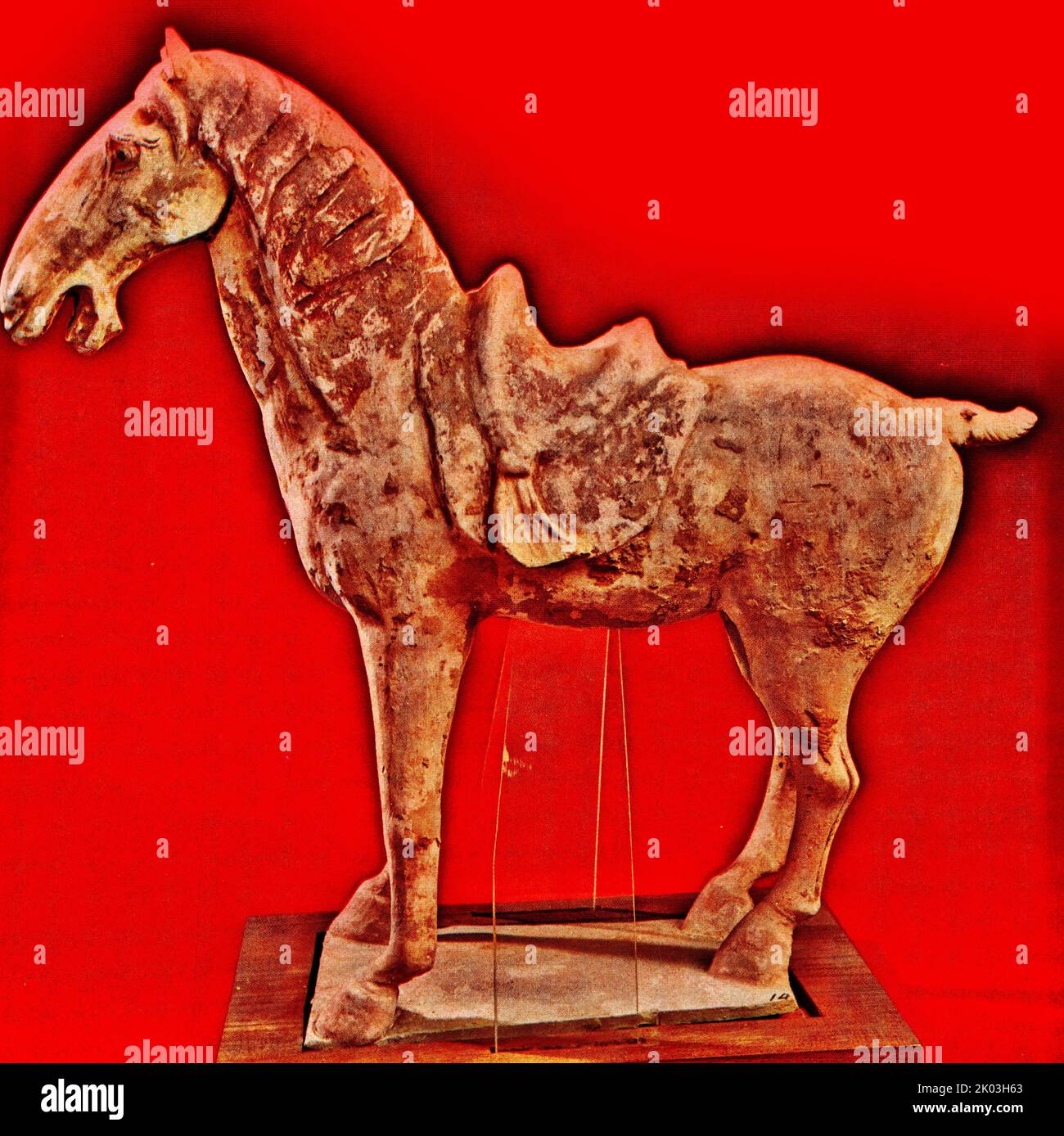 Tang Dynasty figurine of a horse. glazed white with traces of vermilion and ink painting. It stands upright on a rectangular platform. The horse is strong and has short legs and a large head in proportion. The head is straight, the eyes are open, the eyes are looking forward, the mouth is open and hissing, the sideburns are drooping to the left, the tail is upturned, and the limbs are stable. The eyes are drawn with vermilion and ink, and the lines of the muscles on the horse's face are very realistic. Stock Photohttps://www.alamy.com/image-license-details/?v=1https://www.alamy.com/tang-dynasty-figurine-of-a-horse-glazed-white-with-traces-of-vermilion-and-ink-painting-it-stands-upright-on-a-rectangular-platform-the-horse-is-strong-and-has-short-legs-and-a-large-head-in-proportion-the-head-is-straight-the-eyes-are-open-the-eyes-are-looking-forward-the-mouth-is-open-and-hissing-the-sideburns-are-drooping-to-the-left-the-tail-is-upturned-and-the-limbs-are-stable-the-eyes-are-drawn-with-vermilion-and-ink-and-the-lines-of-the-muscles-on-the-horses-face-are-very-realistic-image481969659.html
Tang Dynasty figurine of a horse. glazed white with traces of vermilion and ink painting. It stands upright on a rectangular platform. The horse is strong and has short legs and a large head in proportion. The head is straight, the eyes are open, the eyes are looking forward, the mouth is open and hissing, the sideburns are drooping to the left, the tail is upturned, and the limbs are stable. The eyes are drawn with vermilion and ink, and the lines of the muscles on the horse's face are very realistic. Stock Photohttps://www.alamy.com/image-license-details/?v=1https://www.alamy.com/tang-dynasty-figurine-of-a-horse-glazed-white-with-traces-of-vermilion-and-ink-painting-it-stands-upright-on-a-rectangular-platform-the-horse-is-strong-and-has-short-legs-and-a-large-head-in-proportion-the-head-is-straight-the-eyes-are-open-the-eyes-are-looking-forward-the-mouth-is-open-and-hissing-the-sideburns-are-drooping-to-the-left-the-tail-is-upturned-and-the-limbs-are-stable-the-eyes-are-drawn-with-vermilion-and-ink-and-the-lines-of-the-muscles-on-the-horses-face-are-very-realistic-image481969659.htmlRM2K03H63–Tang Dynasty figurine of a horse. glazed white with traces of vermilion and ink painting. It stands upright on a rectangular platform. The horse is strong and has short legs and a large head in proportion. The head is straight, the eyes are open, the eyes are looking forward, the mouth is open and hissing, the sideburns are drooping to the left, the tail is upturned, and the limbs are stable. The eyes are drawn with vermilion and ink, and the lines of the muscles on the horse's face are very realistic.
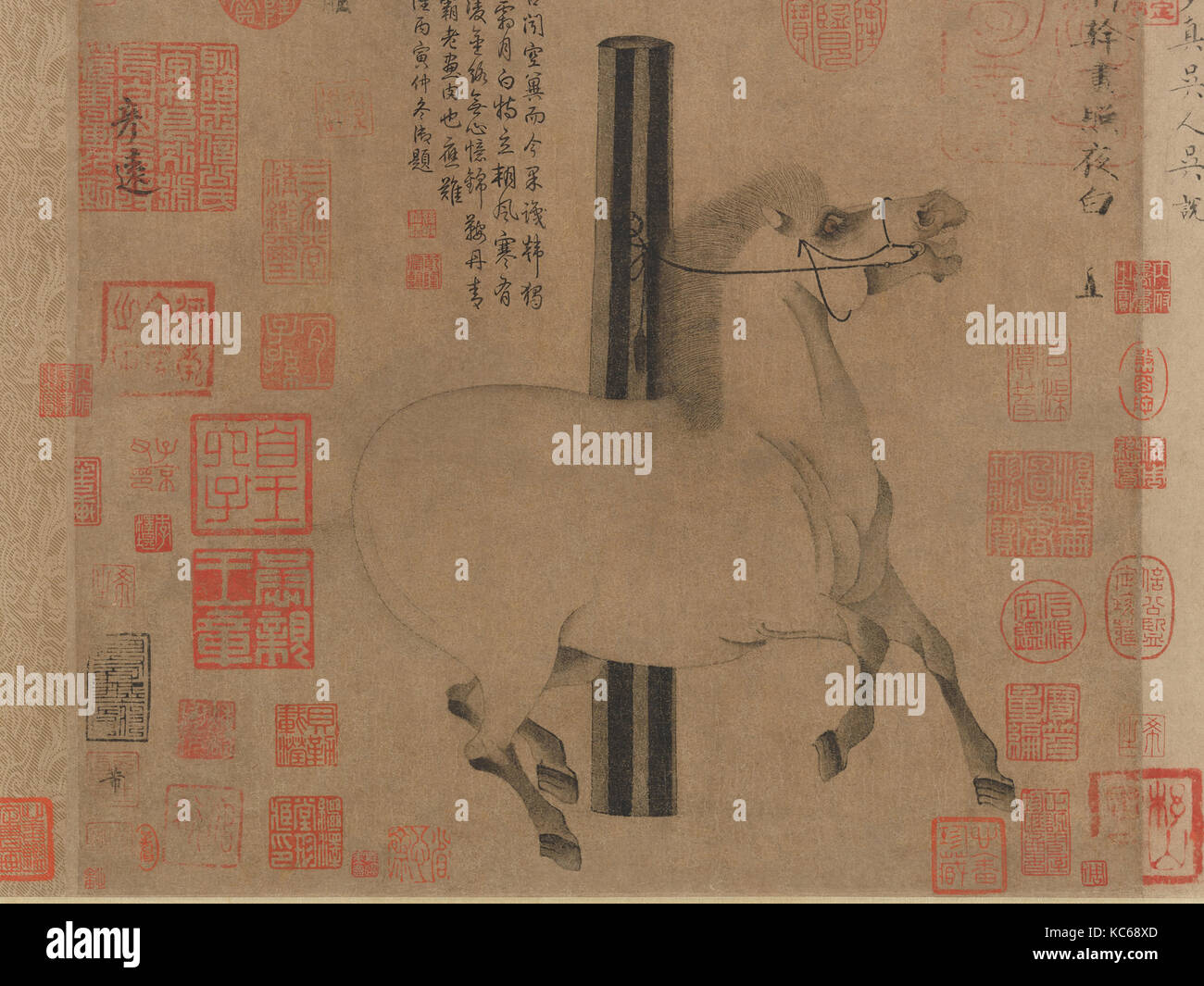 Night-Shining White, 唐 韓幹 照夜白圖 卷, Tang dynasty (618–907), ca. 750, China, Handscroll; ink on paper, Image: 12 1/8 x 13 3/8 in. ( Stock Photohttps://www.alamy.com/image-license-details/?v=1https://www.alamy.com/stock-image-night-shining-white-tang-dynasty-618907-ca-750-china-handscroll-ink-162407909.html
Night-Shining White, 唐 韓幹 照夜白圖 卷, Tang dynasty (618–907), ca. 750, China, Handscroll; ink on paper, Image: 12 1/8 x 13 3/8 in. ( Stock Photohttps://www.alamy.com/image-license-details/?v=1https://www.alamy.com/stock-image-night-shining-white-tang-dynasty-618907-ca-750-china-handscroll-ink-162407909.htmlRMKC68XD–Night-Shining White, 唐 韓幹 照夜白圖 卷, Tang dynasty (618–907), ca. 750, China, Handscroll; ink on paper, Image: 12 1/8 x 13 3/8 in. (
 Buddha fresco painting Tang Dynasty 8 Century AD Xinjiang China sanctuary Duldur aqur Qumtura Stock Photohttps://www.alamy.com/image-license-details/?v=1https://www.alamy.com/stock-photo-buddha-fresco-painting-tang-dynasty-8-century-ad-xinjiang-china-sanctuary-43420404.html
Buddha fresco painting Tang Dynasty 8 Century AD Xinjiang China sanctuary Duldur aqur Qumtura Stock Photohttps://www.alamy.com/image-license-details/?v=1https://www.alamy.com/stock-photo-buddha-fresco-painting-tang-dynasty-8-century-ad-xinjiang-china-sanctuary-43420404.htmlRMCEHY4M–Buddha fresco painting Tang Dynasty 8 Century AD Xinjiang China sanctuary Duldur aqur Qumtura
 Civil Dignitary, 618-906, 39 x 10 x 10 1/4 in. (99.1 x 25.4 x 26 cm), Earthenware with traces of pigment, China, 7th-10th century, Ceramic tomb figures were especially distinguished during the Tang dynasty. Polychrome painting of fine quality was applied to lifelike earthenware sculpture raising these wares to a new level of excellence. The serious, dignified demeanor of a civil official is captured perfectly in this large, well-modeled figure. Elegant in his tall court hat and long robe with flowing sleeves, this dignitary has a realistically modeled face and clasps his hands respectfully Stock Photohttps://www.alamy.com/image-license-details/?v=1https://www.alamy.com/civil-dignitary-618-906-39-x-10-x-10-14-in-991-x-254-x-26-cm-earthenware-with-traces-of-pigment-china-7th-10th-century-ceramic-tomb-figures-were-especially-distinguished-during-the-tang-dynasty-polychrome-painting-of-fine-quality-was-applied-to-lifelike-earthenware-sculpture-raising-these-wares-to-a-new-level-of-excellence-the-serious-dignified-demeanor-of-a-civil-official-is-captured-perfectly-in-this-large-well-modeled-figure-elegant-in-his-tall-court-hat-and-long-robe-with-flowing-sleeves-this-dignitary-has-a-realistically-modeled-face-and-clasps-his-hands-respectfully-image573501846.html
Civil Dignitary, 618-906, 39 x 10 x 10 1/4 in. (99.1 x 25.4 x 26 cm), Earthenware with traces of pigment, China, 7th-10th century, Ceramic tomb figures were especially distinguished during the Tang dynasty. Polychrome painting of fine quality was applied to lifelike earthenware sculpture raising these wares to a new level of excellence. The serious, dignified demeanor of a civil official is captured perfectly in this large, well-modeled figure. Elegant in his tall court hat and long robe with flowing sleeves, this dignitary has a realistically modeled face and clasps his hands respectfully Stock Photohttps://www.alamy.com/image-license-details/?v=1https://www.alamy.com/civil-dignitary-618-906-39-x-10-x-10-14-in-991-x-254-x-26-cm-earthenware-with-traces-of-pigment-china-7th-10th-century-ceramic-tomb-figures-were-especially-distinguished-during-the-tang-dynasty-polychrome-painting-of-fine-quality-was-applied-to-lifelike-earthenware-sculpture-raising-these-wares-to-a-new-level-of-excellence-the-serious-dignified-demeanor-of-a-civil-official-is-captured-perfectly-in-this-large-well-modeled-figure-elegant-in-his-tall-court-hat-and-long-robe-with-flowing-sleeves-this-dignitary-has-a-realistically-modeled-face-and-clasps-his-hands-respectfully-image573501846.htmlRM2T917CP–Civil Dignitary, 618-906, 39 x 10 x 10 1/4 in. (99.1 x 25.4 x 26 cm), Earthenware with traces of pigment, China, 7th-10th century, Ceramic tomb figures were especially distinguished during the Tang dynasty. Polychrome painting of fine quality was applied to lifelike earthenware sculpture raising these wares to a new level of excellence. The serious, dignified demeanor of a civil official is captured perfectly in this large, well-modeled figure. Elegant in his tall court hat and long robe with flowing sleeves, this dignitary has a realistically modeled face and clasps his hands respectfully
 Phoenix-headed Ewer 8th Century NORTH CENTRAL CHINA Tang dynasty (618-907 C.E.) Earthenware, three-colour lead glaze (sancai), moulded decoration Stock Photohttps://www.alamy.com/image-license-details/?v=1https://www.alamy.com/phoenix-headed-ewer-8th-century-north-central-china-tang-dynasty-618-907-ce-earthenware-three-colour-lead-glaze-sancai-moulded-decoration-image399010076.html
Phoenix-headed Ewer 8th Century NORTH CENTRAL CHINA Tang dynasty (618-907 C.E.) Earthenware, three-colour lead glaze (sancai), moulded decoration Stock Photohttps://www.alamy.com/image-license-details/?v=1https://www.alamy.com/phoenix-headed-ewer-8th-century-north-central-china-tang-dynasty-618-907-ce-earthenware-three-colour-lead-glaze-sancai-moulded-decoration-image399010076.htmlRM2E54DBT–Phoenix-headed Ewer 8th Century NORTH CENTRAL CHINA Tang dynasty (618-907 C.E.) Earthenware, three-colour lead glaze (sancai), moulded decoration
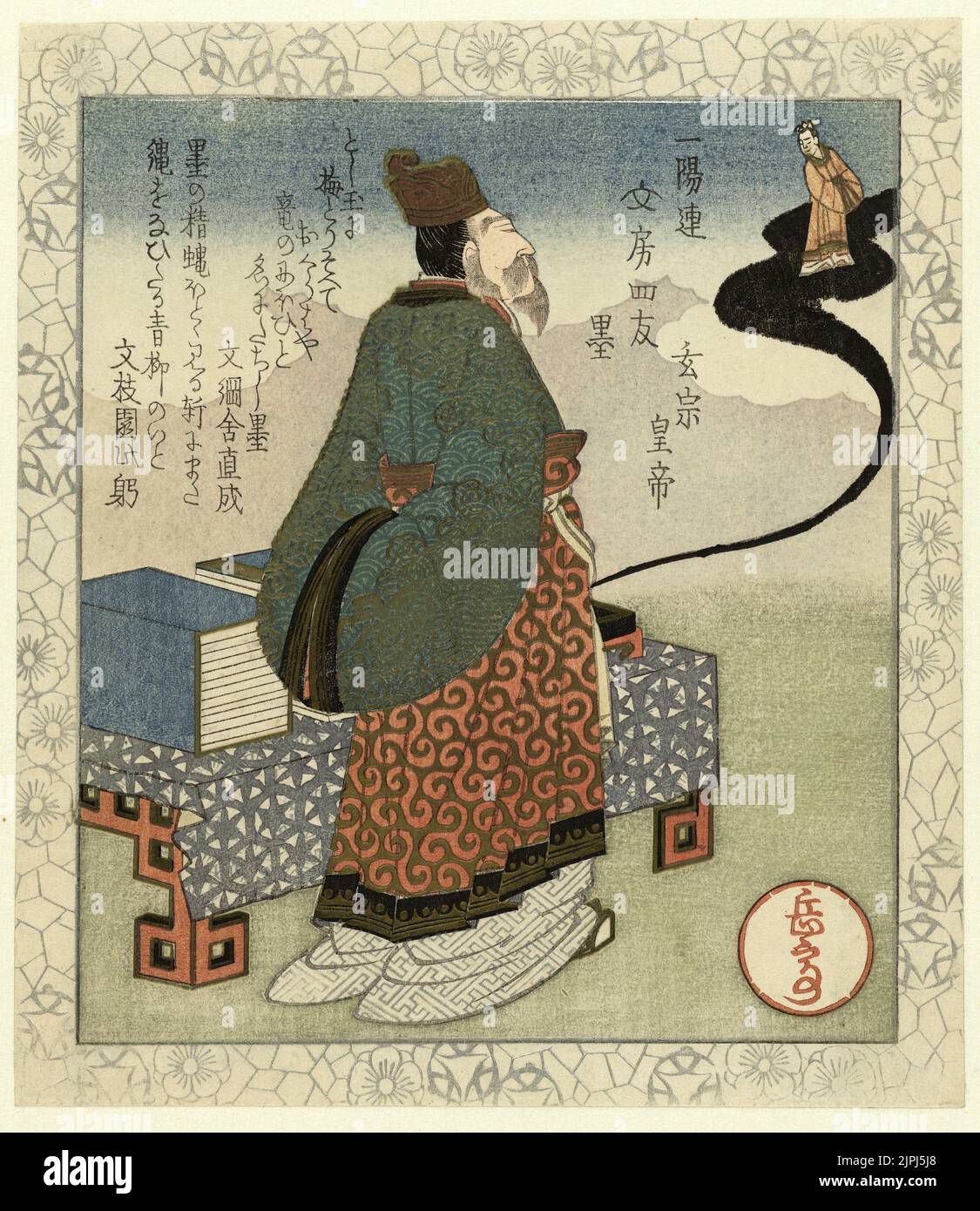 Emperor Xuanzong Watches a Woman Emerge from the Ink. Circa 1827. by Yashima Gakutei Stock Photohttps://www.alamy.com/image-license-details/?v=1https://www.alamy.com/emperor-xuanzong-watches-a-woman-emerge-from-the-ink-circa-1827-by-yashima-gakutei-image478601936.html
Emperor Xuanzong Watches a Woman Emerge from the Ink. Circa 1827. by Yashima Gakutei Stock Photohttps://www.alamy.com/image-license-details/?v=1https://www.alamy.com/emperor-xuanzong-watches-a-woman-emerge-from-the-ink-circa-1827-by-yashima-gakutei-image478601936.htmlRM2JPJ5J8–Emperor Xuanzong Watches a Woman Emerge from the Ink. Circa 1827. by Yashima Gakutei
 Scenes from the life of the Chinese Emperor Xuanzong of Tang (685-762), and his Concubine Yang Guifei (719-756), painting by Kano Mitsunobu, 1580-1608 Stock Photohttps://www.alamy.com/image-license-details/?v=1https://www.alamy.com/scenes-from-the-life-of-the-chineseemperor-xuanzong-of-tang-685-762-and-his-concubine-yang-guifei-719-756-painting-by-kano-mitsunobu-1580-1608-image425453227.html
Scenes from the life of the Chinese Emperor Xuanzong of Tang (685-762), and his Concubine Yang Guifei (719-756), painting by Kano Mitsunobu, 1580-1608 Stock Photohttps://www.alamy.com/image-license-details/?v=1https://www.alamy.com/scenes-from-the-life-of-the-chineseemperor-xuanzong-of-tang-685-762-and-his-concubine-yang-guifei-719-756-painting-by-kano-mitsunobu-1580-1608-image425453227.htmlRM2FM51X3–Scenes from the life of the Chinese Emperor Xuanzong of Tang (685-762), and his Concubine Yang Guifei (719-756), painting by Kano Mitsunobu, 1580-1608
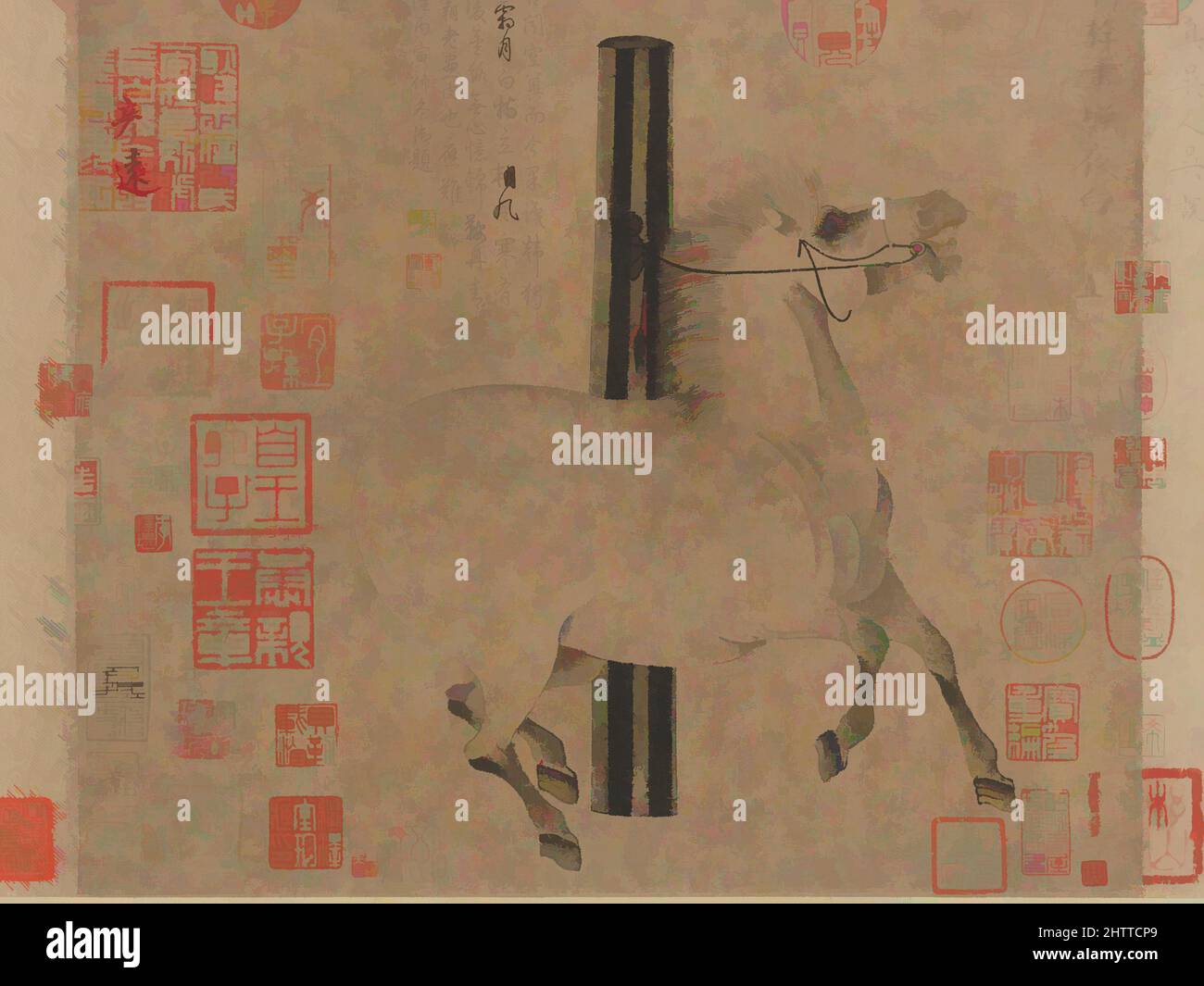 Art inspired by Night-Shining White, 唐 韓幹 照夜白圖 卷, Tang dynasty (618–907), ca. 750, China, Handscroll; ink on paper, Image: 12 1/8 x 13 3/8 in. (30.8 x 34 cm), Paintings, Han Gan (Chinese, active ca. 742–756), A leading horse painter of the Tang dynasty, Han Gan was known for capturing, Classic works modernized by Artotop with a splash of modernity. Shapes, color and value, eye-catching visual impact on art. Emotions through freedom of artworks in a contemporary way. A timeless message pursuing a wildly creative new direction. Artists turning to the digital medium and creating the Artotop NFT Stock Photohttps://www.alamy.com/image-license-details/?v=1https://www.alamy.com/art-inspired-by-night-shining-white-tang-dynasty-618907-ca-750-china-handscroll-ink-on-paper-image-12-18-x-13-38-in-308-x-34-cm-paintings-han-gan-chinese-active-ca-742756-a-leading-horse-painter-of-the-tang-dynasty-han-gan-was-known-for-capturing-classic-works-modernized-by-artotop-with-a-splash-of-modernity-shapes-color-and-value-eye-catching-visual-impact-on-art-emotions-through-freedom-of-artworks-in-a-contemporary-way-a-timeless-message-pursuing-a-wildly-creative-new-direction-artists-turning-to-the-digital-medium-and-creating-the-artotop-nft-image462758193.html
Art inspired by Night-Shining White, 唐 韓幹 照夜白圖 卷, Tang dynasty (618–907), ca. 750, China, Handscroll; ink on paper, Image: 12 1/8 x 13 3/8 in. (30.8 x 34 cm), Paintings, Han Gan (Chinese, active ca. 742–756), A leading horse painter of the Tang dynasty, Han Gan was known for capturing, Classic works modernized by Artotop with a splash of modernity. Shapes, color and value, eye-catching visual impact on art. Emotions through freedom of artworks in a contemporary way. A timeless message pursuing a wildly creative new direction. Artists turning to the digital medium and creating the Artotop NFT Stock Photohttps://www.alamy.com/image-license-details/?v=1https://www.alamy.com/art-inspired-by-night-shining-white-tang-dynasty-618907-ca-750-china-handscroll-ink-on-paper-image-12-18-x-13-38-in-308-x-34-cm-paintings-han-gan-chinese-active-ca-742756-a-leading-horse-painter-of-the-tang-dynasty-han-gan-was-known-for-capturing-classic-works-modernized-by-artotop-with-a-splash-of-modernity-shapes-color-and-value-eye-catching-visual-impact-on-art-emotions-through-freedom-of-artworks-in-a-contemporary-way-a-timeless-message-pursuing-a-wildly-creative-new-direction-artists-turning-to-the-digital-medium-and-creating-the-artotop-nft-image462758193.htmlRF2HTTCP9–Art inspired by Night-Shining White, 唐 韓幹 照夜白圖 卷, Tang dynasty (618–907), ca. 750, China, Handscroll; ink on paper, Image: 12 1/8 x 13 3/8 in. (30.8 x 34 cm), Paintings, Han Gan (Chinese, active ca. 742–756), A leading horse painter of the Tang dynasty, Han Gan was known for capturing, Classic works modernized by Artotop with a splash of modernity. Shapes, color and value, eye-catching visual impact on art. Emotions through freedom of artworks in a contemporary way. A timeless message pursuing a wildly creative new direction. Artists turning to the digital medium and creating the Artotop NFT
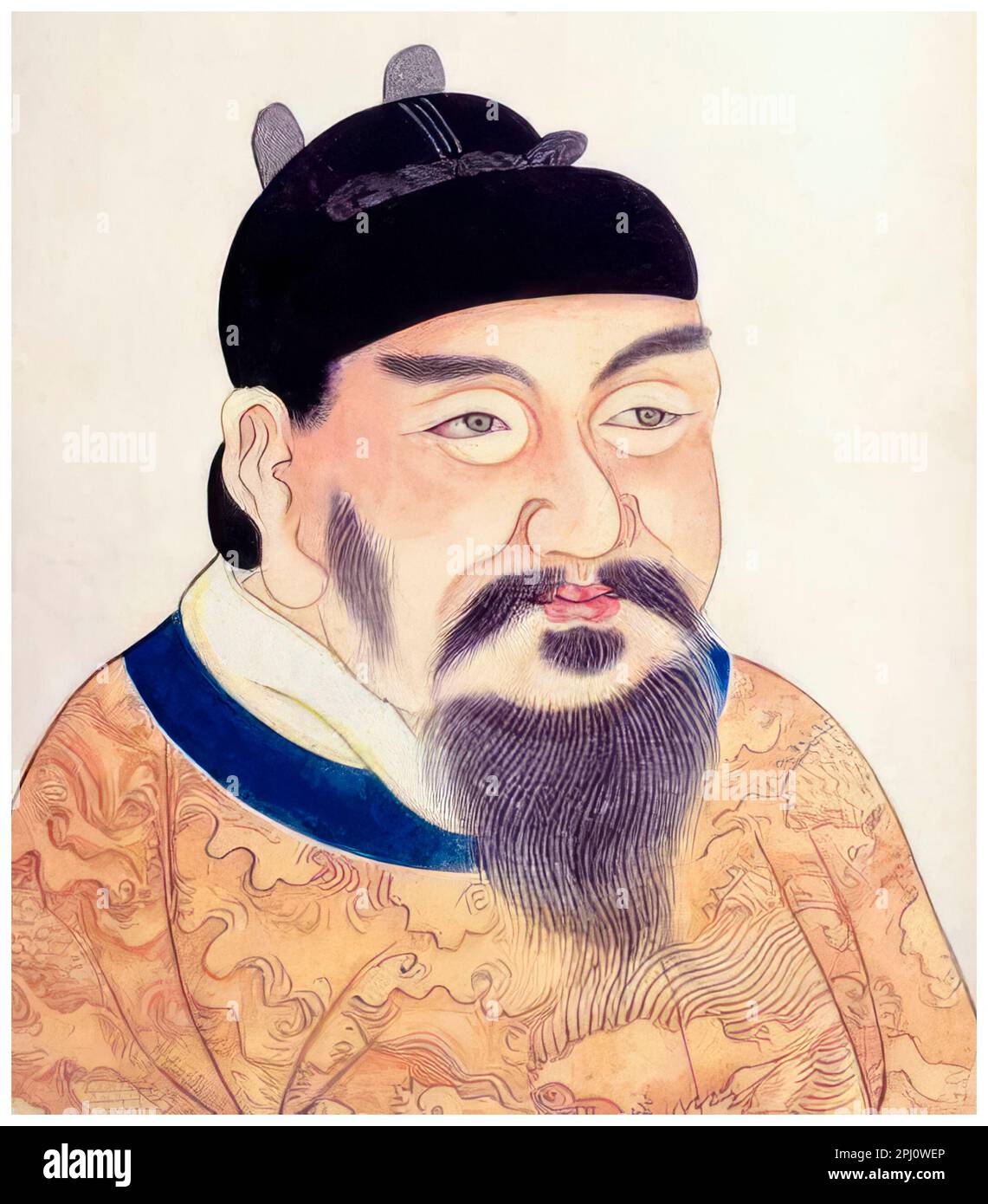 Emperor Gaozong of Tang (628-683), Third Chinese Emperor of the Tang Dynasty, portrait painting before 1799 Stock Photohttps://www.alamy.com/image-license-details/?v=1https://www.alamy.com/emperor-gaozong-of-tang-628-683-third-chinese-emperor-of-the-tang-dynasty-portrait-painting-before-1799-image544605230.html
Emperor Gaozong of Tang (628-683), Third Chinese Emperor of the Tang Dynasty, portrait painting before 1799 Stock Photohttps://www.alamy.com/image-license-details/?v=1https://www.alamy.com/emperor-gaozong-of-tang-628-683-third-chinese-emperor-of-the-tang-dynasty-portrait-painting-before-1799-image544605230.htmlRM2PJ0WEP–Emperor Gaozong of Tang (628-683), Third Chinese Emperor of the Tang Dynasty, portrait painting before 1799
 Wall painting from a Tang Tomb at Nanliwang village, Chang’an, Xi’an. Shanxi Museum in Xi'an, China. Stock Photohttps://www.alamy.com/image-license-details/?v=1https://www.alamy.com/stock-photo-wall-painting-from-a-tang-tomb-at-nanliwang-village-changan-xian-shanxi-89172279.html
Wall painting from a Tang Tomb at Nanliwang village, Chang’an, Xi’an. Shanxi Museum in Xi'an, China. Stock Photohttps://www.alamy.com/image-license-details/?v=1https://www.alamy.com/stock-photo-wall-painting-from-a-tang-tomb-at-nanliwang-village-changan-xian-shanxi-89172279.htmlRMF52447–Wall painting from a Tang Tomb at Nanliwang village, Chang’an, Xi’an. Shanxi Museum in Xi'an, China.
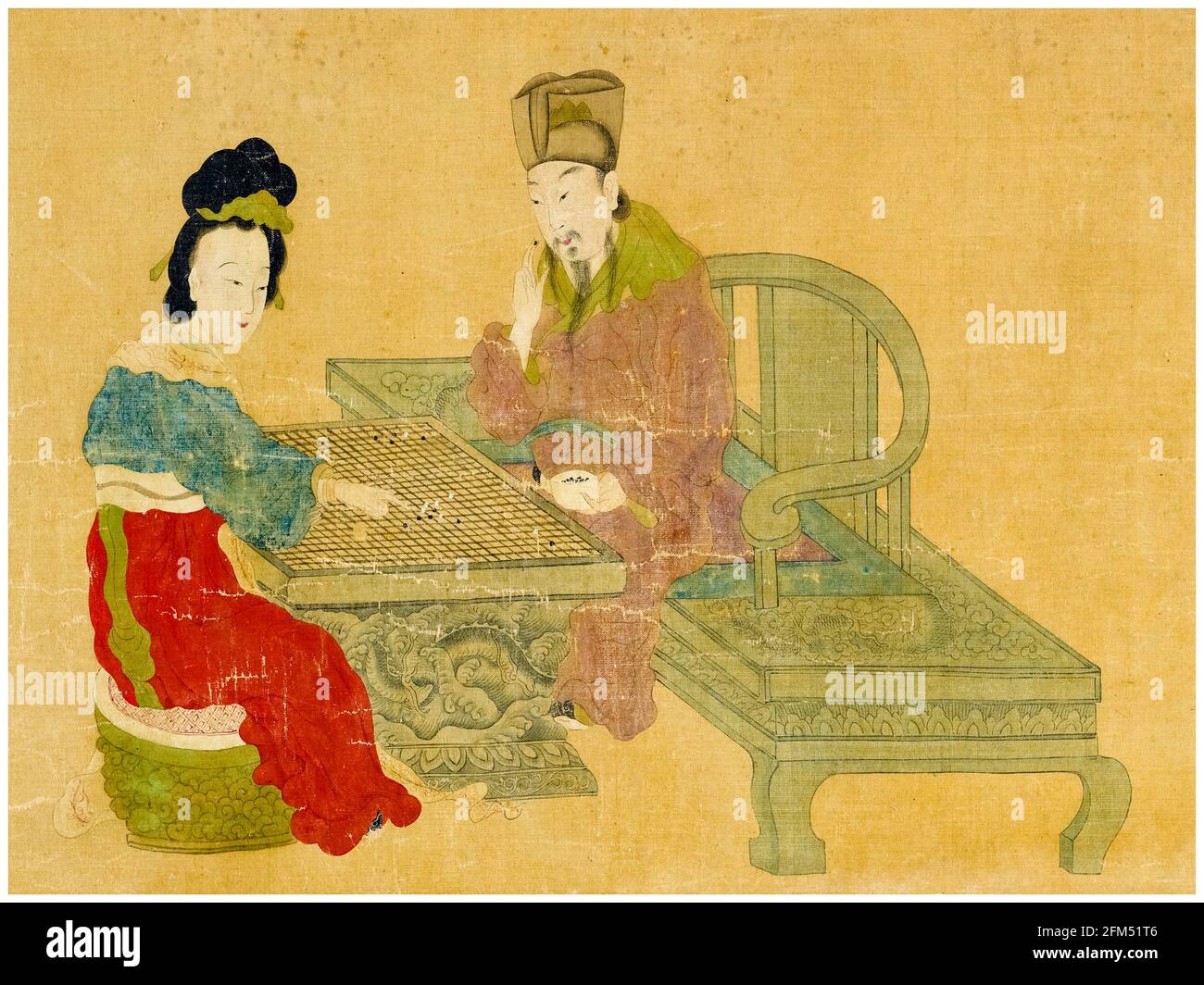 Emperor Xuanzong of Tang (685-762) and Consort Yang Guifei (719-756) playing Weiqi, painting 1600-1699 Stock Photohttps://www.alamy.com/image-license-details/?v=1https://www.alamy.com/emperor-xuanzong-of-tang-685-762-and-consort-yang-guifei-719-756-playing-weiqi-painting-1600-1699-image425453174.html
Emperor Xuanzong of Tang (685-762) and Consort Yang Guifei (719-756) playing Weiqi, painting 1600-1699 Stock Photohttps://www.alamy.com/image-license-details/?v=1https://www.alamy.com/emperor-xuanzong-of-tang-685-762-and-consort-yang-guifei-719-756-playing-weiqi-painting-1600-1699-image425453174.htmlRM2FM51T6–Emperor Xuanzong of Tang (685-762) and Consort Yang Guifei (719-756) playing Weiqi, painting 1600-1699
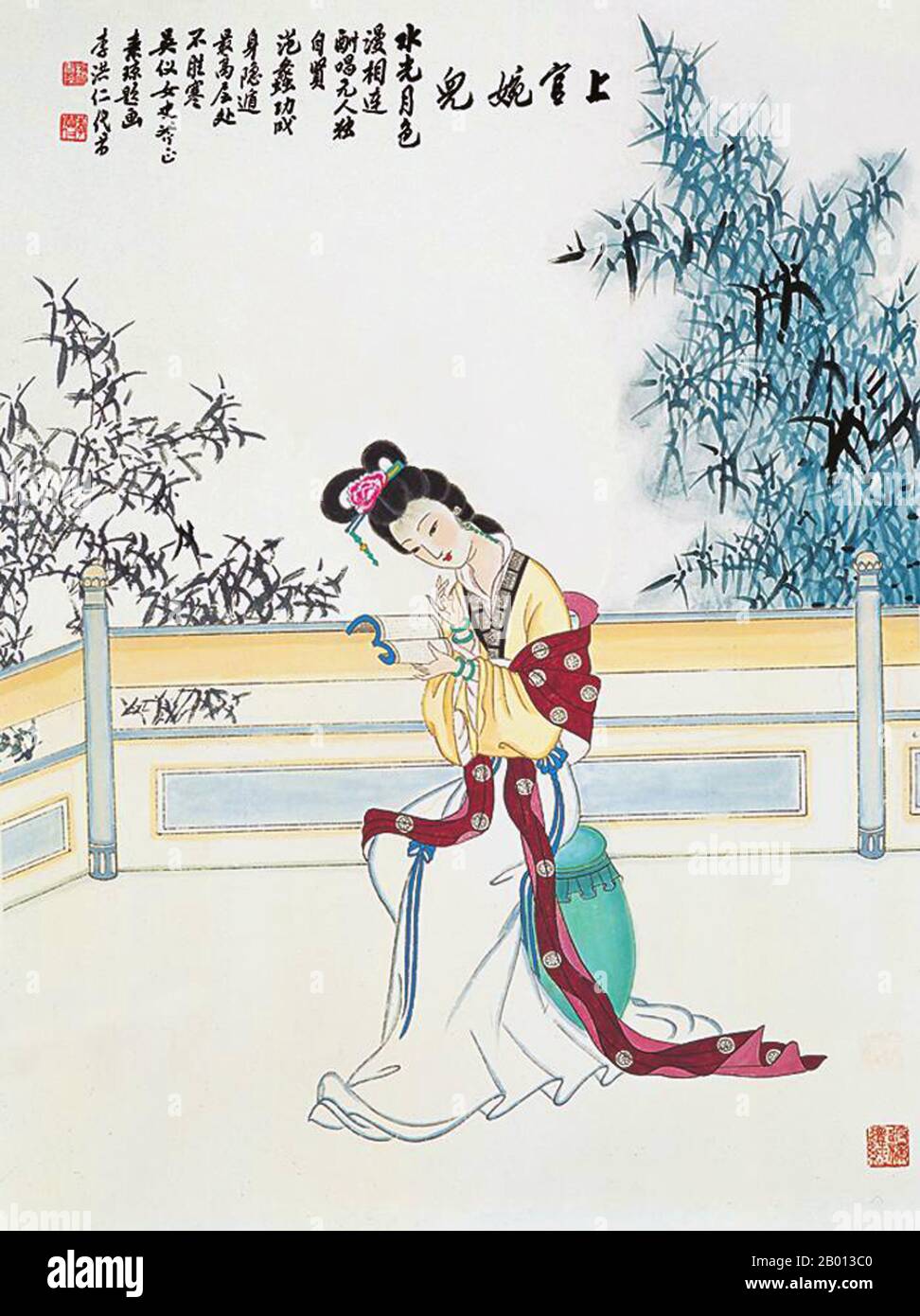 China: Shangguan Wan'er (664–710), imperial consort of Emperor Zhongzong of Tang (705-710). Handscroll painting, c. 18th century. Shangguan Wan'er (664–21 July 710), imperial consort rank Zhaorong, posthumous name Wenhui, was the granddaughter of Shangguan Yi (formally Duke of Chu) and was one of the most famous women in Chinese history for her talent. She was a poet, writer and politician of the Tang Dynasty, as well as an imperial consort (concubine) of Emperor Zhongzong. Stock Photohttps://www.alamy.com/image-license-details/?v=1https://www.alamy.com/china-shangguan-waner-664710-imperial-consort-of-emperor-zhongzong-of-tang-705-710-handscroll-painting-c-18th-century-shangguan-waner-66421-july-710-imperial-consort-rank-zhaorong-posthumous-name-wenhui-was-the-granddaughter-of-shangguan-yi-formally-duke-of-chu-and-was-one-of-the-most-famous-women-in-chinese-history-for-her-talent-she-was-a-poet-writer-and-politician-of-the-tang-dynasty-as-well-as-an-imperial-consort-concubine-of-emperor-zhongzong-image344232000.html
China: Shangguan Wan'er (664–710), imperial consort of Emperor Zhongzong of Tang (705-710). Handscroll painting, c. 18th century. Shangguan Wan'er (664–21 July 710), imperial consort rank Zhaorong, posthumous name Wenhui, was the granddaughter of Shangguan Yi (formally Duke of Chu) and was one of the most famous women in Chinese history for her talent. She was a poet, writer and politician of the Tang Dynasty, as well as an imperial consort (concubine) of Emperor Zhongzong. Stock Photohttps://www.alamy.com/image-license-details/?v=1https://www.alamy.com/china-shangguan-waner-664710-imperial-consort-of-emperor-zhongzong-of-tang-705-710-handscroll-painting-c-18th-century-shangguan-waner-66421-july-710-imperial-consort-rank-zhaorong-posthumous-name-wenhui-was-the-granddaughter-of-shangguan-yi-formally-duke-of-chu-and-was-one-of-the-most-famous-women-in-chinese-history-for-her-talent-she-was-a-poet-writer-and-politician-of-the-tang-dynasty-as-well-as-an-imperial-consort-concubine-of-emperor-zhongzong-image344232000.htmlRM2B013C0–China: Shangguan Wan'er (664–710), imperial consort of Emperor Zhongzong of Tang (705-710). Handscroll painting, c. 18th century. Shangguan Wan'er (664–21 July 710), imperial consort rank Zhaorong, posthumous name Wenhui, was the granddaughter of Shangguan Yi (formally Duke of Chu) and was one of the most famous women in Chinese history for her talent. She was a poet, writer and politician of the Tang Dynasty, as well as an imperial consort (concubine) of Emperor Zhongzong.
 Chinese porcelain: Polychrome glazed pottery statue of Heavenly Guardian. Tang Dynasty (618-907 A.D.). Shanghai Museum, China. Stock Photohttps://www.alamy.com/image-license-details/?v=1https://www.alamy.com/chinese-porcelain-polychrome-glazed-pottery-statue-of-heavenly-guardian-tang-dynasty-618-907-ad-shanghai-museum-china-image331686899.html
Chinese porcelain: Polychrome glazed pottery statue of Heavenly Guardian. Tang Dynasty (618-907 A.D.). Shanghai Museum, China. Stock Photohttps://www.alamy.com/image-license-details/?v=1https://www.alamy.com/chinese-porcelain-polychrome-glazed-pottery-statue-of-heavenly-guardian-tang-dynasty-618-907-ad-shanghai-museum-china-image331686899.htmlRF2A7HJ0K–Chinese porcelain: Polychrome glazed pottery statue of Heavenly Guardian. Tang Dynasty (618-907 A.D.). Shanghai Museum, China.
 Jade Belt Plaques, Tang dynasty. Metropolitan Museum of New York, Manhattan, New York City Stock Photohttps://www.alamy.com/image-license-details/?v=1https://www.alamy.com/stock-photo-jade-belt-plaques-tang-dynasty-metropolitan-museum-of-new-york-manhattan-57214400.html
Jade Belt Plaques, Tang dynasty. Metropolitan Museum of New York, Manhattan, New York City Stock Photohttps://www.alamy.com/image-license-details/?v=1https://www.alamy.com/stock-photo-jade-belt-plaques-tang-dynasty-metropolitan-museum-of-new-york-manhattan-57214400.htmlRMD929FC–Jade Belt Plaques, Tang dynasty. Metropolitan Museum of New York, Manhattan, New York City
 Tang Fengtu Stock Photohttps://www.alamy.com/image-license-details/?v=1https://www.alamy.com/stock-photo-tang-fengtu-110537360.html
Tang Fengtu Stock Photohttps://www.alamy.com/image-license-details/?v=1https://www.alamy.com/stock-photo-tang-fengtu-110537360.htmlRFGBRBET–Tang Fengtu
 Confucius Tang Dynasty Stock Photohttps://www.alamy.com/image-license-details/?v=1https://www.alamy.com/stock-photo-confucius-tang-dynasty-132451865.html
Confucius Tang Dynasty Stock Photohttps://www.alamy.com/image-license-details/?v=1https://www.alamy.com/stock-photo-confucius-tang-dynasty-132451865.htmlRMHKDKKN–Confucius Tang Dynasty
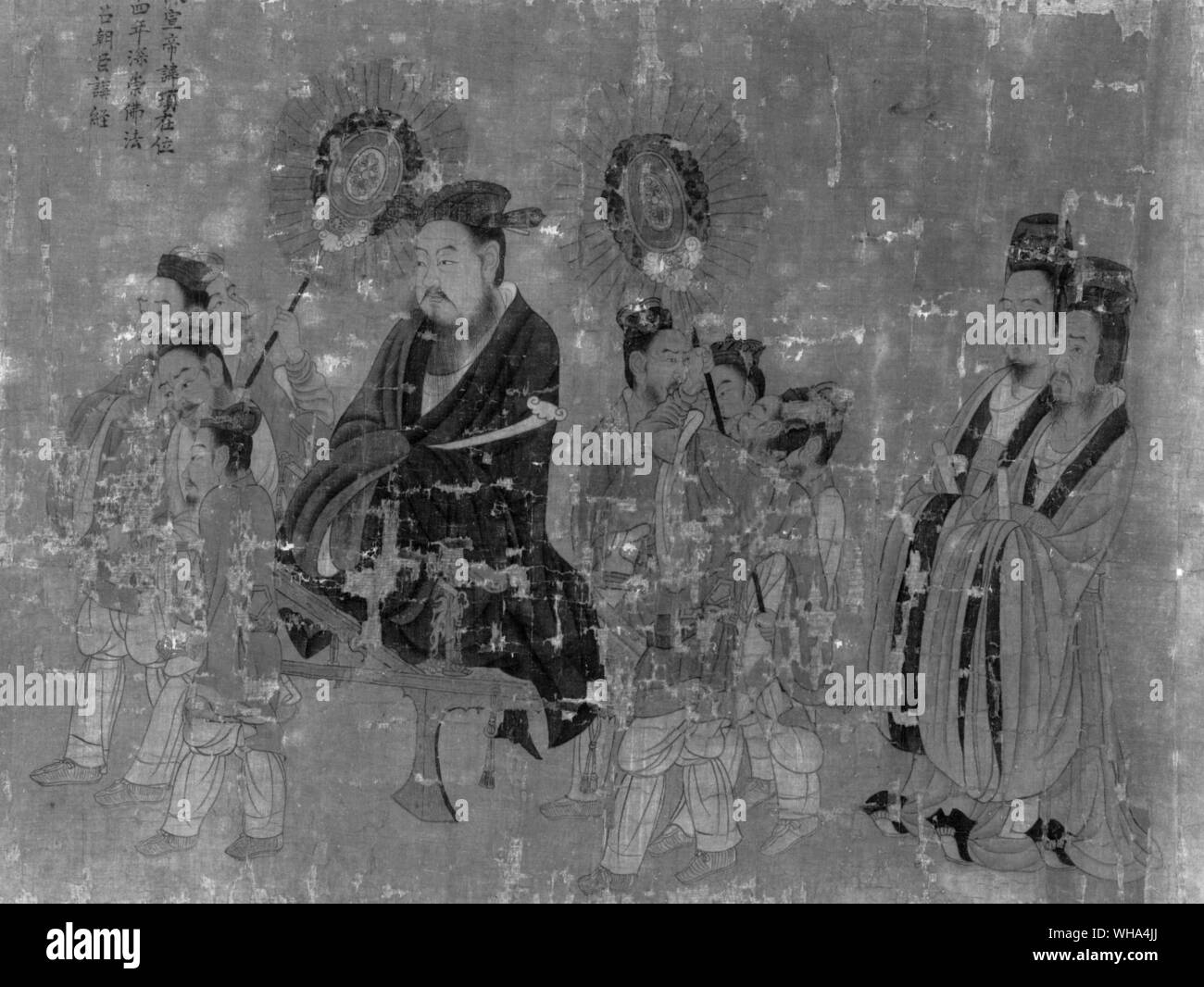 Yen Li Pen. Emperor Husan (Hsuan ?) Ti of Ch'en dynasty.. Yen Li-pen , d. 673, Chinese painter, foremost master of the T'ang dynasty. He became the most celebrated court painter of the 7th cent. and held several high public offices. Although probably none of his original works survives today, records tell us that he was most renowned for his paintings of Buddhist and Taoist themes and also as the painter of historical personages and events. The superb scroll painting Portraits of Thirteen Emperors in the Museum of Fine Arts, Boston, has been attributed to him but may be a copy. It represents Stock Photohttps://www.alamy.com/image-license-details/?v=1https://www.alamy.com/yen-li-pen-emperor-husan-hsuan-ti-of-chen-dynasty-yen-li-pen-d-673-chinese-painter-foremost-master-of-the-tang-dynasty-he-became-the-most-celebrated-court-painter-of-the-7th-cent-and-held-several-high-public-offices-although-probably-none-of-his-original-works-survives-today-records-tell-us-that-he-was-most-renowned-for-his-paintings-of-buddhist-and-taoist-themes-and-also-as-the-painter-of-historical-personages-and-events-the-superb-scroll-painting-portraits-of-thirteen-emperors-in-the-museum-of-fine-arts-boston-has-been-attributed-to-him-but-may-be-a-copy-it-represents-image268827850.html
Yen Li Pen. Emperor Husan (Hsuan ?) Ti of Ch'en dynasty.. Yen Li-pen , d. 673, Chinese painter, foremost master of the T'ang dynasty. He became the most celebrated court painter of the 7th cent. and held several high public offices. Although probably none of his original works survives today, records tell us that he was most renowned for his paintings of Buddhist and Taoist themes and also as the painter of historical personages and events. The superb scroll painting Portraits of Thirteen Emperors in the Museum of Fine Arts, Boston, has been attributed to him but may be a copy. It represents Stock Photohttps://www.alamy.com/image-license-details/?v=1https://www.alamy.com/yen-li-pen-emperor-husan-hsuan-ti-of-chen-dynasty-yen-li-pen-d-673-chinese-painter-foremost-master-of-the-tang-dynasty-he-became-the-most-celebrated-court-painter-of-the-7th-cent-and-held-several-high-public-offices-although-probably-none-of-his-original-works-survives-today-records-tell-us-that-he-was-most-renowned-for-his-paintings-of-buddhist-and-taoist-themes-and-also-as-the-painter-of-historical-personages-and-events-the-superb-scroll-painting-portraits-of-thirteen-emperors-in-the-museum-of-fine-arts-boston-has-been-attributed-to-him-but-may-be-a-copy-it-represents-image268827850.htmlRMWHA4JJ–Yen Li Pen. Emperor Husan (Hsuan ?) Ti of Ch'en dynasty.. Yen Li-pen , d. 673, Chinese painter, foremost master of the T'ang dynasty. He became the most celebrated court painter of the 7th cent. and held several high public offices. Although probably none of his original works survives today, records tell us that he was most renowned for his paintings of Buddhist and Taoist themes and also as the painter of historical personages and events. The superb scroll painting Portraits of Thirteen Emperors in the Museum of Fine Arts, Boston, has been attributed to him but may be a copy. It represents
 WASHINGTON DC, United States — The Arts of Six Dynasties and Tang in China Gallery at the Arthur M. Sackler Gallery in Washington DC. This exhibit showcases a rich collection of Chinese art and furniture from the Six Dynasties period (220-589 CE) and the Tang Dynasty (618-907 CE), offering visitors a glimpse into the artistic and cultural achievements of ancient China. Stock Photohttps://www.alamy.com/image-license-details/?v=1https://www.alamy.com/washington-dc-united-states-the-arts-of-six-dynasties-and-tang-in-china-gallery-at-the-arthur-m-sackler-gallery-in-washington-dc-this-exhibit-showcases-a-rich-collection-of-chinese-art-and-furniture-from-the-six-dynasties-period-220-589-ce-and-the-tang-dynasty-618-907-ce-offering-visitors-a-glimpse-into-the-artistic-and-cultural-achievements-of-ancient-china-image622400336.html
WASHINGTON DC, United States — The Arts of Six Dynasties and Tang in China Gallery at the Arthur M. Sackler Gallery in Washington DC. This exhibit showcases a rich collection of Chinese art and furniture from the Six Dynasties period (220-589 CE) and the Tang Dynasty (618-907 CE), offering visitors a glimpse into the artistic and cultural achievements of ancient China. Stock Photohttps://www.alamy.com/image-license-details/?v=1https://www.alamy.com/washington-dc-united-states-the-arts-of-six-dynasties-and-tang-in-china-gallery-at-the-arthur-m-sackler-gallery-in-washington-dc-this-exhibit-showcases-a-rich-collection-of-chinese-art-and-furniture-from-the-six-dynasties-period-220-589-ce-and-the-tang-dynasty-618-907-ce-offering-visitors-a-glimpse-into-the-artistic-and-cultural-achievements-of-ancient-china-image622400336.htmlRM2Y4GNYC–WASHINGTON DC, United States — The Arts of Six Dynasties and Tang in China Gallery at the Arthur M. Sackler Gallery in Washington DC. This exhibit showcases a rich collection of Chinese art and furniture from the Six Dynasties period (220-589 CE) and the Tang Dynasty (618-907 CE), offering visitors a glimpse into the artistic and cultural achievements of ancient China.
 Divinities of the Planets and Constellations. Artist: Attributed to Qiu Ying (Chinese, ca. 1495-1552). Culture: China. Dimensions: Image: 7 9/16 x 158 1/4 in. (19.2 x 402 cm) Overall with mounting: 9 3/4 x 376 15/16 in. (24.8 x 957.4 cm). Date: 16th century. The subject and imagery of this painting are derived from a composition attributed to the Tang dynasty (618-907) artist Liang Lingzan that is now in the collection of the Osaka Municipal Museum of Art. The painting depicts the deities of the Five Planets, which correspond to the five primary elements--wood (Jupiter), fire (Mars), earth ( Stock Photohttps://www.alamy.com/image-license-details/?v=1https://www.alamy.com/divinities-of-the-planets-and-constellations-artist-attributed-to-qiu-ying-chinese-ca-1495-1552-culture-china-dimensions-image-7-916-x-158-14-in-192-x-402-cm-overall-with-mounting-9-34-x-376-1516-in-248-x-9574-cm-date-16th-century-the-subject-and-imagery-of-this-painting-are-derived-from-a-composition-attributed-to-the-tang-dynasty-618-907-artist-liang-lingzan-that-is-now-in-the-collection-of-the-osaka-municipal-museum-of-art-the-painting-depicts-the-deities-of-the-five-planets-which-correspond-to-the-five-primary-elements-wood-jupiter-fire-mars-earth-image212882915.html
Divinities of the Planets and Constellations. Artist: Attributed to Qiu Ying (Chinese, ca. 1495-1552). Culture: China. Dimensions: Image: 7 9/16 x 158 1/4 in. (19.2 x 402 cm) Overall with mounting: 9 3/4 x 376 15/16 in. (24.8 x 957.4 cm). Date: 16th century. The subject and imagery of this painting are derived from a composition attributed to the Tang dynasty (618-907) artist Liang Lingzan that is now in the collection of the Osaka Municipal Museum of Art. The painting depicts the deities of the Five Planets, which correspond to the five primary elements--wood (Jupiter), fire (Mars), earth ( Stock Photohttps://www.alamy.com/image-license-details/?v=1https://www.alamy.com/divinities-of-the-planets-and-constellations-artist-attributed-to-qiu-ying-chinese-ca-1495-1552-culture-china-dimensions-image-7-916-x-158-14-in-192-x-402-cm-overall-with-mounting-9-34-x-376-1516-in-248-x-9574-cm-date-16th-century-the-subject-and-imagery-of-this-painting-are-derived-from-a-composition-attributed-to-the-tang-dynasty-618-907-artist-liang-lingzan-that-is-now-in-the-collection-of-the-osaka-municipal-museum-of-art-the-painting-depicts-the-deities-of-the-five-planets-which-correspond-to-the-five-primary-elements-wood-jupiter-fire-mars-earth-image212882915.htmlRMPA9J97–Divinities of the Planets and Constellations. Artist: Attributed to Qiu Ying (Chinese, ca. 1495-1552). Culture: China. Dimensions: Image: 7 9/16 x 158 1/4 in. (19.2 x 402 cm) Overall with mounting: 9 3/4 x 376 15/16 in. (24.8 x 957.4 cm). Date: 16th century. The subject and imagery of this painting are derived from a composition attributed to the Tang dynasty (618-907) artist Liang Lingzan that is now in the collection of the Osaka Municipal Museum of Art. The painting depicts the deities of the Five Planets, which correspond to the five primary elements--wood (Jupiter), fire (Mars), earth (
 . 'Beauty Playing Go', a painting by an unknown Chinese artist of the Tang Dynasty period; the painting shows a woman playing Go. 7th-10th Century, Tang Dynasty. Unknown 77 Beauty playing Go (Tang Dynasty) Stock Photohttps://www.alamy.com/image-license-details/?v=1https://www.alamy.com/beauty-playing-go-a-painting-by-an-unknown-chinese-artist-of-the-tang-dynasty-period-the-painting-shows-a-woman-playing-go-7th-10th-century-tang-dynasty-unknown-77-beauty-playing-go-tang-dynasty-image187673388.html
. 'Beauty Playing Go', a painting by an unknown Chinese artist of the Tang Dynasty period; the painting shows a woman playing Go. 7th-10th Century, Tang Dynasty. Unknown 77 Beauty playing Go (Tang Dynasty) Stock Photohttps://www.alamy.com/image-license-details/?v=1https://www.alamy.com/beauty-playing-go-a-painting-by-an-unknown-chinese-artist-of-the-tang-dynasty-period-the-painting-shows-a-woman-playing-go-7th-10th-century-tang-dynasty-unknown-77-beauty-playing-go-tang-dynasty-image187673388.htmlRMMW9790–. 'Beauty Playing Go', a painting by an unknown Chinese artist of the Tang Dynasty period; the painting shows a woman playing Go. 7th-10th Century, Tang Dynasty. Unknown 77 Beauty playing Go (Tang Dynasty)
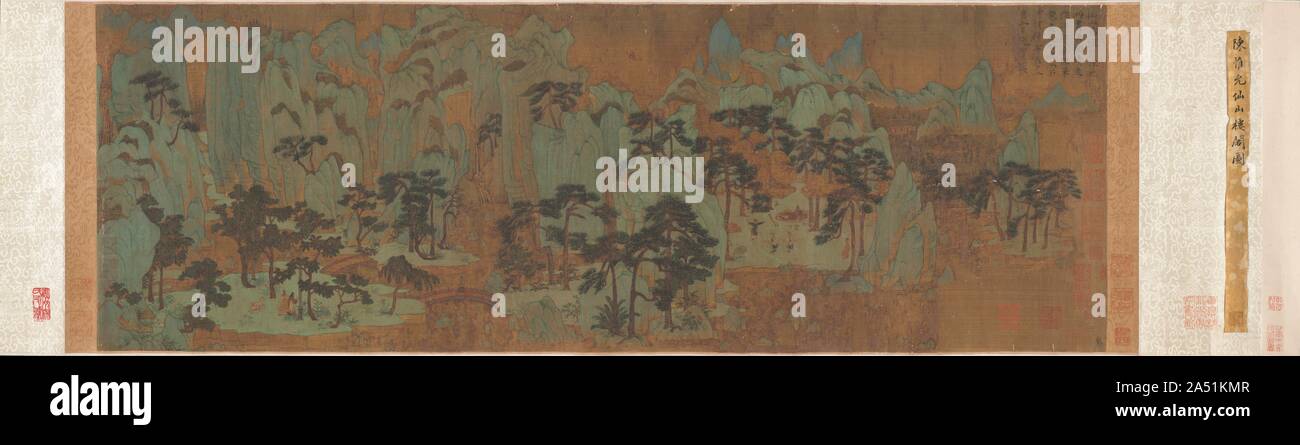 Mountains of the Immortals, 1279-1368. This extraordinary painting reveals the intense desire by Yuan artists to capture and renew the flavor of past generations. The fantastic landscape is painted in the "blue and green" style associated with the Tang dynasty (618-907), a period of superb cultural achievement in China. Athough the intense mineral pigments have faded with the passage of time, the artist's vision of an imaginary land remains intact for the modern viewer. Stock Photohttps://www.alamy.com/image-license-details/?v=1https://www.alamy.com/mountains-of-the-immortals-1279-1368-this-extraordinary-painting-reveals-the-intense-desire-by-yuan-artists-to-capture-and-renew-the-flavor-of-past-generations-the-fantastic-landscape-is-painted-in-the-quotblue-and-greenquot-style-associated-with-the-tang-dynasty-618-907-a-period-of-superb-cultural-achievement-in-china-athough-the-intense-mineral-pigments-have-faded-with-the-passage-of-time-the-artists-vision-of-an-imaginary-land-remains-intact-for-the-modern-viewer-image330107703.html
Mountains of the Immortals, 1279-1368. This extraordinary painting reveals the intense desire by Yuan artists to capture and renew the flavor of past generations. The fantastic landscape is painted in the "blue and green" style associated with the Tang dynasty (618-907), a period of superb cultural achievement in China. Athough the intense mineral pigments have faded with the passage of time, the artist's vision of an imaginary land remains intact for the modern viewer. Stock Photohttps://www.alamy.com/image-license-details/?v=1https://www.alamy.com/mountains-of-the-immortals-1279-1368-this-extraordinary-painting-reveals-the-intense-desire-by-yuan-artists-to-capture-and-renew-the-flavor-of-past-generations-the-fantastic-landscape-is-painted-in-the-quotblue-and-greenquot-style-associated-with-the-tang-dynasty-618-907-a-period-of-superb-cultural-achievement-in-china-athough-the-intense-mineral-pigments-have-faded-with-the-passage-of-time-the-artists-vision-of-an-imaginary-land-remains-intact-for-the-modern-viewer-image330107703.htmlRM2A51KMR–Mountains of the Immortals, 1279-1368. This extraordinary painting reveals the intense desire by Yuan artists to capture and renew the flavor of past generations. The fantastic landscape is painted in the "blue and green" style associated with the Tang dynasty (618-907), a period of superb cultural achievement in China. Athough the intense mineral pigments have faded with the passage of time, the artist's vision of an imaginary land remains intact for the modern viewer.
 Portrait of Emperor Taizong of Tang (598 – 649), the second emperor of the Tang dynasty of China Stock Photohttps://www.alamy.com/image-license-details/?v=1https://www.alamy.com/portrait-of-emperor-taizong-of-tang-598-649-the-second-emperor-of-the-tang-dynasty-of-china-image462614474.html
Portrait of Emperor Taizong of Tang (598 – 649), the second emperor of the Tang dynasty of China Stock Photohttps://www.alamy.com/image-license-details/?v=1https://www.alamy.com/portrait-of-emperor-taizong-of-tang-598-649-the-second-emperor-of-the-tang-dynasty-of-china-image462614474.htmlRM2HTHWDE–Portrait of Emperor Taizong of Tang (598 – 649), the second emperor of the Tang dynasty of China
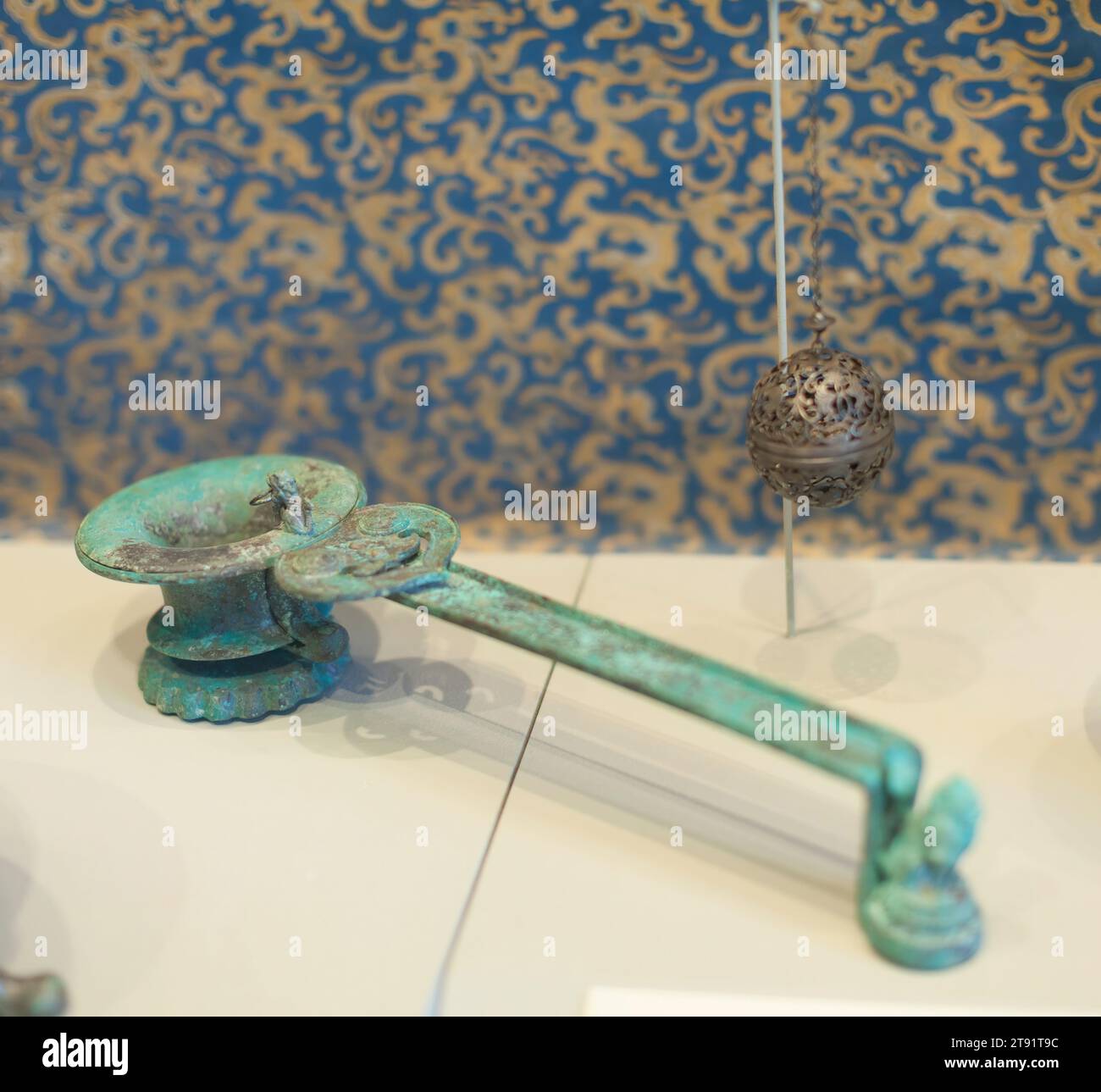 Buddhist Long-handled Censer, 8th century, 4 1/4 x 16 x 4 9/16 in. (10.8 x 40.64 x 11.59 cm), Bronze, China, 8th century, Hand censers of this unique form were used in Buddhist rituals during the Tang dynasty. The cup-shaped censer is fitted with a removable liner cast with a small Buddhist lion on the rim holding a loose ring in its mouth. The top of the handle is decorated with a flat, openwork petal-shaped ornament applied with two large bosses, and the handle terminus is surmounted by another protective Buddhist lion seated on a lotus-petal decorated base. Stock Photohttps://www.alamy.com/image-license-details/?v=1https://www.alamy.com/buddhist-long-handled-censer-8th-century-4-14-x-16-x-4-916-in-108-x-4064-x-1159-cm-bronze-china-8th-century-hand-censers-of-this-unique-form-were-used-in-buddhist-rituals-during-the-tang-dynasty-the-cup-shaped-censer-is-fitted-with-a-removable-liner-cast-with-a-small-buddhist-lion-on-the-rim-holding-a-loose-ring-in-its-mouth-the-top-of-the-handle-is-decorated-with-a-flat-openwork-petal-shaped-ornament-applied-with-two-large-bosses-and-the-handle-terminus-is-surmounted-by-another-protective-buddhist-lion-seated-on-a-lotus-petal-decorated-base-image573515080.html
Buddhist Long-handled Censer, 8th century, 4 1/4 x 16 x 4 9/16 in. (10.8 x 40.64 x 11.59 cm), Bronze, China, 8th century, Hand censers of this unique form were used in Buddhist rituals during the Tang dynasty. The cup-shaped censer is fitted with a removable liner cast with a small Buddhist lion on the rim holding a loose ring in its mouth. The top of the handle is decorated with a flat, openwork petal-shaped ornament applied with two large bosses, and the handle terminus is surmounted by another protective Buddhist lion seated on a lotus-petal decorated base. Stock Photohttps://www.alamy.com/image-license-details/?v=1https://www.alamy.com/buddhist-long-handled-censer-8th-century-4-14-x-16-x-4-916-in-108-x-4064-x-1159-cm-bronze-china-8th-century-hand-censers-of-this-unique-form-were-used-in-buddhist-rituals-during-the-tang-dynasty-the-cup-shaped-censer-is-fitted-with-a-removable-liner-cast-with-a-small-buddhist-lion-on-the-rim-holding-a-loose-ring-in-its-mouth-the-top-of-the-handle-is-decorated-with-a-flat-openwork-petal-shaped-ornament-applied-with-two-large-bosses-and-the-handle-terminus-is-surmounted-by-another-protective-buddhist-lion-seated-on-a-lotus-petal-decorated-base-image573515080.htmlRM2T91T9C–Buddhist Long-handled Censer, 8th century, 4 1/4 x 16 x 4 9/16 in. (10.8 x 40.64 x 11.59 cm), Bronze, China, 8th century, Hand censers of this unique form were used in Buddhist rituals during the Tang dynasty. The cup-shaped censer is fitted with a removable liner cast with a small Buddhist lion on the rim holding a loose ring in its mouth. The top of the handle is decorated with a flat, openwork petal-shaped ornament applied with two large bosses, and the handle terminus is surmounted by another protective Buddhist lion seated on a lotus-petal decorated base.
 Funerary Model: Bullock Cart 8th Century . CENTRAL CHINA Tang dynasty (618-907 C.E.) The Tang dynasty or Tang Empire, was an imperial dynasty of China that ruled from 618 to 907 Stock Photohttps://www.alamy.com/image-license-details/?v=1https://www.alamy.com/funerary-model-bullock-cart-8th-century-central-china-tang-dynasty-618-907-ce-the-tang-dynasty-or-tang-empire-was-an-imperial-dynasty-of-china-that-ruled-from-618-to-907-image399010134.html
Funerary Model: Bullock Cart 8th Century . CENTRAL CHINA Tang dynasty (618-907 C.E.) The Tang dynasty or Tang Empire, was an imperial dynasty of China that ruled from 618 to 907 Stock Photohttps://www.alamy.com/image-license-details/?v=1https://www.alamy.com/funerary-model-bullock-cart-8th-century-central-china-tang-dynasty-618-907-ce-the-tang-dynasty-or-tang-empire-was-an-imperial-dynasty-of-china-that-ruled-from-618-to-907-image399010134.htmlRM2E54DDX–Funerary Model: Bullock Cart 8th Century . CENTRAL CHINA Tang dynasty (618-907 C.E.) The Tang dynasty or Tang Empire, was an imperial dynasty of China that ruled from 618 to 907
 Gazing at a Waterfall, Ming dynasty (1368–1644), China, Folding fan mounted as an album leaf; ink and color on gold-flecked Stock Photohttps://www.alamy.com/image-license-details/?v=1https://www.alamy.com/stock-image-gazing-at-a-waterfall-ming-dynasty-13681644-china-folding-fan-mounted-162407885.html
Gazing at a Waterfall, Ming dynasty (1368–1644), China, Folding fan mounted as an album leaf; ink and color on gold-flecked Stock Photohttps://www.alamy.com/image-license-details/?v=1https://www.alamy.com/stock-image-gazing-at-a-waterfall-ming-dynasty-13681644-china-folding-fan-mounted-162407885.htmlRMKC68WH–Gazing at a Waterfall, Ming dynasty (1368–1644), China, Folding fan mounted as an album leaf; ink and color on gold-flecked
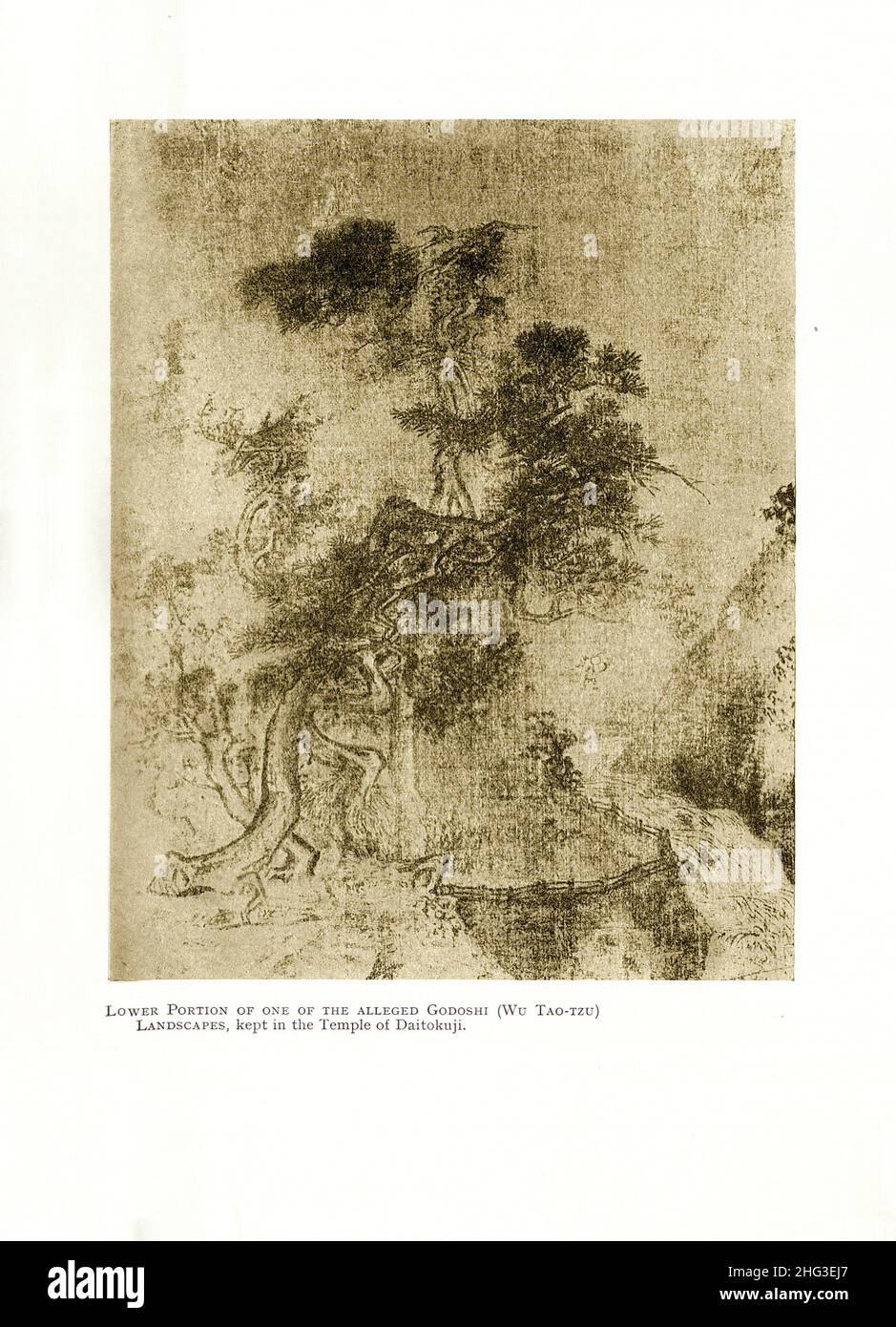 Art of China, Nothern Song. Lower portion of one of the alleged Godoshi (Wu Tao-Tzu). Vintage landscapes, kept in the Temple of Daitoku-ji (temple of Stock Photohttps://www.alamy.com/image-license-details/?v=1https://www.alamy.com/art-of-china-nothern-song-lower-portion-of-one-of-the-alleged-godoshi-wu-tao-tzu-vintage-landscapes-kept-in-the-temple-of-daitoku-ji-temple-of-image457381407.html
Art of China, Nothern Song. Lower portion of one of the alleged Godoshi (Wu Tao-Tzu). Vintage landscapes, kept in the Temple of Daitoku-ji (temple of Stock Photohttps://www.alamy.com/image-license-details/?v=1https://www.alamy.com/art-of-china-nothern-song-lower-portion-of-one-of-the-alleged-godoshi-wu-tao-tzu-vintage-landscapes-kept-in-the-temple-of-daitoku-ji-temple-of-image457381407.htmlRM2HG3EJ7–Art of China, Nothern Song. Lower portion of one of the alleged Godoshi (Wu Tao-Tzu). Vintage landscapes, kept in the Temple of Daitoku-ji (temple of
 Art inspired by 明早期 黑漆嵌螺鈿學士圖八方盤, Tray with Eighteen Scholars of the Tang, Ming dynasty (1368–1644), 15th century, China, Black lacquer with mother-of-pearl inlay, H. 1 5/8 in. (4.1 cm); Diam. 11 3/8 in. (28.9 cm); Diam. of foot 9 5/8 in. (24.4 cm), Lacquer, In the foreground, three, Classic works modernized by Artotop with a splash of modernity. Shapes, color and value, eye-catching visual impact on art. Emotions through freedom of artworks in a contemporary way. A timeless message pursuing a wildly creative new direction. Artists turning to the digital medium and creating the Artotop NFT Stock Photohttps://www.alamy.com/image-license-details/?v=1https://www.alamy.com/art-inspired-by-tray-with-eighteen-scholars-of-the-tang-ming-dynasty-13681644-15th-century-china-black-lacquer-with-mother-of-pearl-inlay-h-1-58-in-41-cm-diam-11-38-in-289-cm-diam-of-foot-9-58-in-244-cm-lacquer-in-the-foreground-three-classic-works-modernized-by-artotop-with-a-splash-of-modernity-shapes-color-and-value-eye-catching-visual-impact-on-art-emotions-through-freedom-of-artworks-in-a-contemporary-way-a-timeless-message-pursuing-a-wildly-creative-new-direction-artists-turning-to-the-digital-medium-and-creating-the-artotop-nft-image462908855.html
Art inspired by 明早期 黑漆嵌螺鈿學士圖八方盤, Tray with Eighteen Scholars of the Tang, Ming dynasty (1368–1644), 15th century, China, Black lacquer with mother-of-pearl inlay, H. 1 5/8 in. (4.1 cm); Diam. 11 3/8 in. (28.9 cm); Diam. of foot 9 5/8 in. (24.4 cm), Lacquer, In the foreground, three, Classic works modernized by Artotop with a splash of modernity. Shapes, color and value, eye-catching visual impact on art. Emotions through freedom of artworks in a contemporary way. A timeless message pursuing a wildly creative new direction. Artists turning to the digital medium and creating the Artotop NFT Stock Photohttps://www.alamy.com/image-license-details/?v=1https://www.alamy.com/art-inspired-by-tray-with-eighteen-scholars-of-the-tang-ming-dynasty-13681644-15th-century-china-black-lacquer-with-mother-of-pearl-inlay-h-1-58-in-41-cm-diam-11-38-in-289-cm-diam-of-foot-9-58-in-244-cm-lacquer-in-the-foreground-three-classic-works-modernized-by-artotop-with-a-splash-of-modernity-shapes-color-and-value-eye-catching-visual-impact-on-art-emotions-through-freedom-of-artworks-in-a-contemporary-way-a-timeless-message-pursuing-a-wildly-creative-new-direction-artists-turning-to-the-digital-medium-and-creating-the-artotop-nft-image462908855.htmlRF2HW38Y3–Art inspired by 明早期 黑漆嵌螺鈿學士圖八方盤, Tray with Eighteen Scholars of the Tang, Ming dynasty (1368–1644), 15th century, China, Black lacquer with mother-of-pearl inlay, H. 1 5/8 in. (4.1 cm); Diam. 11 3/8 in. (28.9 cm); Diam. of foot 9 5/8 in. (24.4 cm), Lacquer, In the foreground, three, Classic works modernized by Artotop with a splash of modernity. Shapes, color and value, eye-catching visual impact on art. Emotions through freedom of artworks in a contemporary way. A timeless message pursuing a wildly creative new direction. Artists turning to the digital medium and creating the Artotop NFT
 Drawing depicting Chinese monk Hai Tong and follower. Found near the Lingyun Temple behind the Giant Buddha of Leshan, Sichuan province, China. Stock Photohttps://www.alamy.com/image-license-details/?v=1https://www.alamy.com/stock-image-drawing-depicting-chinese-monk-hai-tong-and-follower-found-near-the-166445020.html
Drawing depicting Chinese monk Hai Tong and follower. Found near the Lingyun Temple behind the Giant Buddha of Leshan, Sichuan province, China. Stock Photohttps://www.alamy.com/image-license-details/?v=1https://www.alamy.com/stock-image-drawing-depicting-chinese-monk-hai-tong-and-follower-found-near-the-166445020.htmlRFKJP690–Drawing depicting Chinese monk Hai Tong and follower. Found near the Lingyun Temple behind the Giant Buddha of Leshan, Sichuan province, China.
 Art inspired by Gazing at a Waterfall, Ming dynasty (1368–1644), China, Folding fan mounted as an album leaf; ink and color on gold-flecked paper, 20 3/4 x 9 3/4 in. (52.7 x 24.8 cm), Paintings, Tang Yin (Chinese, 1470–1524), The scholar in this fan painting, apparently lost in the, Classic works modernized by Artotop with a splash of modernity. Shapes, color and value, eye-catching visual impact on art. Emotions through freedom of artworks in a contemporary way. A timeless message pursuing a wildly creative new direction. Artists turning to the digital medium and creating the Artotop NFT Stock Photohttps://www.alamy.com/image-license-details/?v=1https://www.alamy.com/art-inspired-by-gazing-at-a-waterfall-ming-dynasty-13681644-china-folding-fan-mounted-as-an-album-leaf-ink-and-color-on-gold-flecked-paper-20-34-x-9-34-in-527-x-248-cm-paintings-tang-yin-chinese-14701524-the-scholar-in-this-fan-painting-apparently-lost-in-the-classic-works-modernized-by-artotop-with-a-splash-of-modernity-shapes-color-and-value-eye-catching-visual-impact-on-art-emotions-through-freedom-of-artworks-in-a-contemporary-way-a-timeless-message-pursuing-a-wildly-creative-new-direction-artists-turning-to-the-digital-medium-and-creating-the-artotop-nft-image462761921.html
Art inspired by Gazing at a Waterfall, Ming dynasty (1368–1644), China, Folding fan mounted as an album leaf; ink and color on gold-flecked paper, 20 3/4 x 9 3/4 in. (52.7 x 24.8 cm), Paintings, Tang Yin (Chinese, 1470–1524), The scholar in this fan painting, apparently lost in the, Classic works modernized by Artotop with a splash of modernity. Shapes, color and value, eye-catching visual impact on art. Emotions through freedom of artworks in a contemporary way. A timeless message pursuing a wildly creative new direction. Artists turning to the digital medium and creating the Artotop NFT Stock Photohttps://www.alamy.com/image-license-details/?v=1https://www.alamy.com/art-inspired-by-gazing-at-a-waterfall-ming-dynasty-13681644-china-folding-fan-mounted-as-an-album-leaf-ink-and-color-on-gold-flecked-paper-20-34-x-9-34-in-527-x-248-cm-paintings-tang-yin-chinese-14701524-the-scholar-in-this-fan-painting-apparently-lost-in-the-classic-works-modernized-by-artotop-with-a-splash-of-modernity-shapes-color-and-value-eye-catching-visual-impact-on-art-emotions-through-freedom-of-artworks-in-a-contemporary-way-a-timeless-message-pursuing-a-wildly-creative-new-direction-artists-turning-to-the-digital-medium-and-creating-the-artotop-nft-image462761921.htmlRF2HTTHFD–Art inspired by Gazing at a Waterfall, Ming dynasty (1368–1644), China, Folding fan mounted as an album leaf; ink and color on gold-flecked paper, 20 3/4 x 9 3/4 in. (52.7 x 24.8 cm), Paintings, Tang Yin (Chinese, 1470–1524), The scholar in this fan painting, apparently lost in the, Classic works modernized by Artotop with a splash of modernity. Shapes, color and value, eye-catching visual impact on art. Emotions through freedom of artworks in a contemporary way. A timeless message pursuing a wildly creative new direction. Artists turning to the digital medium and creating the Artotop NFT
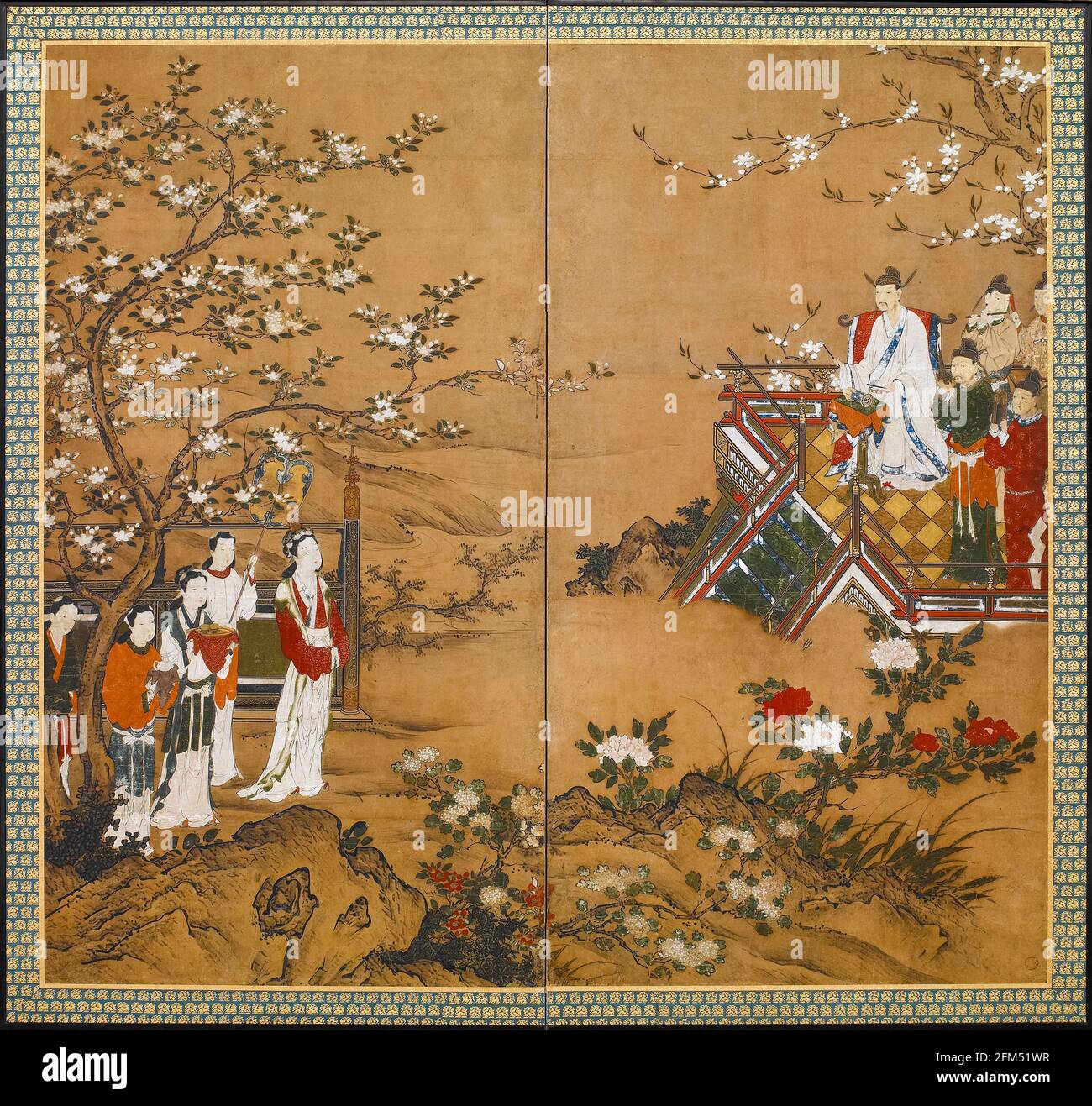 Chinese Emperor Xuanzong of Tang (685-762) and his Concubine Yang Guifei (719-756), painting by Kano School, 1600-1650 Stock Photohttps://www.alamy.com/image-license-details/?v=1https://www.alamy.com/chineseemperor-xuanzong-of-tang-685-762-and-his-concubine-yang-guifei-719-756-painting-by-kano-school-1600-1650-image425453219.html
Chinese Emperor Xuanzong of Tang (685-762) and his Concubine Yang Guifei (719-756), painting by Kano School, 1600-1650 Stock Photohttps://www.alamy.com/image-license-details/?v=1https://www.alamy.com/chineseemperor-xuanzong-of-tang-685-762-and-his-concubine-yang-guifei-719-756-painting-by-kano-school-1600-1650-image425453219.htmlRM2FM51WR–Chinese Emperor Xuanzong of Tang (685-762) and his Concubine Yang Guifei (719-756), painting by Kano School, 1600-1650
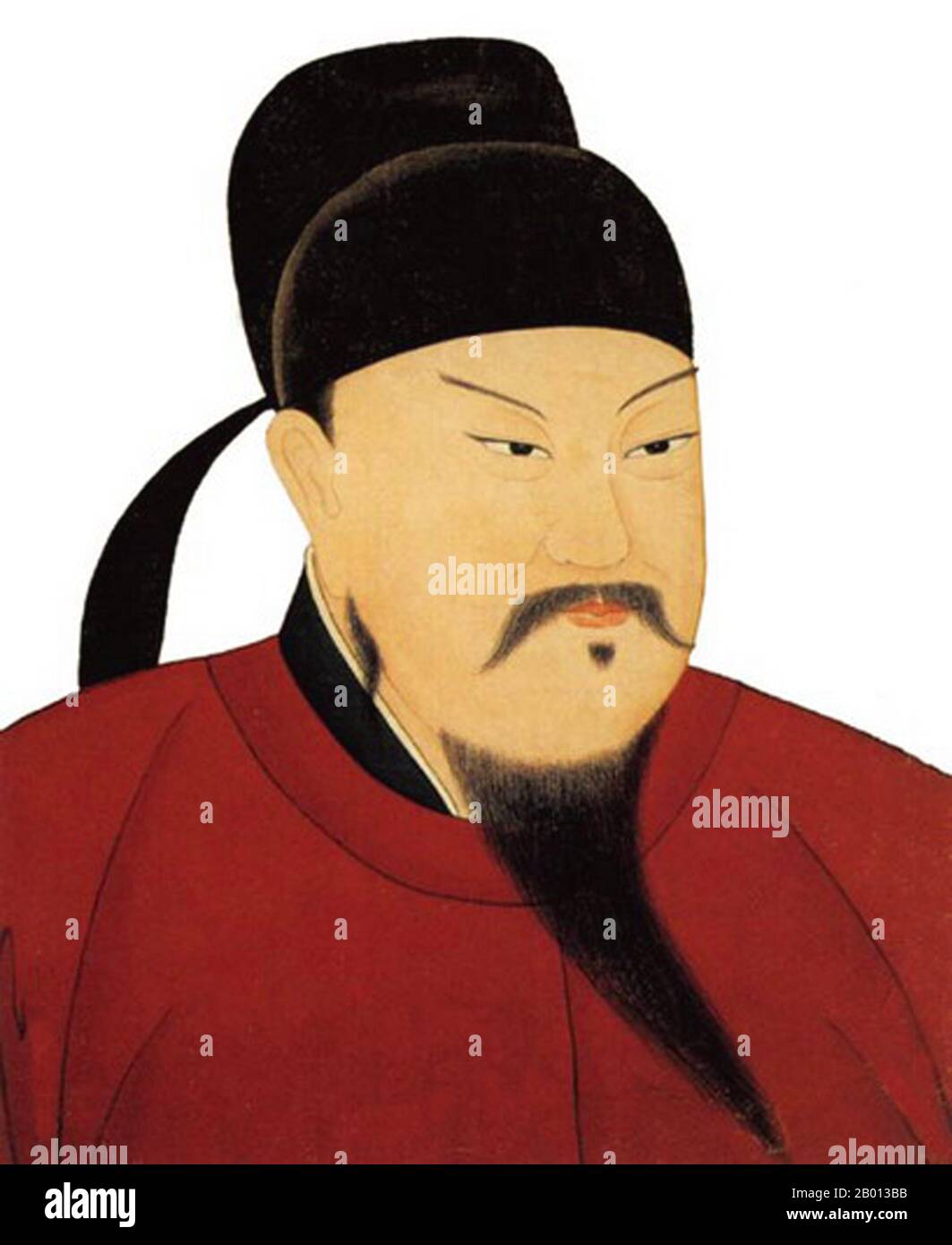 China: Emperor Taizong (Tang Lishimin, January 23, 599 – July 10, 649), 2nd ruler of the Tang Dynasty (r. 626-649). Hanging scroll painting, Tang Dynasty. Emperor Taizong, personal name Li Shimin, was the second emperor of the Tang Dynasty of China. He is ceremonially regarded as a co-founder of the dynasty along with Emperor Gaozu. He is typically considered one of the greatest, if not the greatest, emperors in Chinese history. Throughout the rest of Chinese history, Emperor Taizong's reign was regarded as the exemplary model against which all other emperors were measured. Stock Photohttps://www.alamy.com/image-license-details/?v=1https://www.alamy.com/china-emperor-taizong-tang-lishimin-january-23-599-july-10-649-2nd-ruler-of-the-tang-dynasty-r-626-649-hanging-scroll-painting-tang-dynasty-emperor-taizong-personal-name-li-shimin-was-the-second-emperor-of-the-tang-dynasty-of-china-he-is-ceremonially-regarded-as-a-co-founder-of-the-dynasty-along-with-emperor-gaozu-he-is-typically-considered-one-of-the-greatest-if-not-the-greatest-emperors-in-chinese-history-throughout-the-rest-of-chinese-history-emperor-taizongs-reign-was-regarded-as-the-exemplary-model-against-which-all-other-emperors-were-measured-image344231983.html
China: Emperor Taizong (Tang Lishimin, January 23, 599 – July 10, 649), 2nd ruler of the Tang Dynasty (r. 626-649). Hanging scroll painting, Tang Dynasty. Emperor Taizong, personal name Li Shimin, was the second emperor of the Tang Dynasty of China. He is ceremonially regarded as a co-founder of the dynasty along with Emperor Gaozu. He is typically considered one of the greatest, if not the greatest, emperors in Chinese history. Throughout the rest of Chinese history, Emperor Taizong's reign was regarded as the exemplary model against which all other emperors were measured. Stock Photohttps://www.alamy.com/image-license-details/?v=1https://www.alamy.com/china-emperor-taizong-tang-lishimin-january-23-599-july-10-649-2nd-ruler-of-the-tang-dynasty-r-626-649-hanging-scroll-painting-tang-dynasty-emperor-taizong-personal-name-li-shimin-was-the-second-emperor-of-the-tang-dynasty-of-china-he-is-ceremonially-regarded-as-a-co-founder-of-the-dynasty-along-with-emperor-gaozu-he-is-typically-considered-one-of-the-greatest-if-not-the-greatest-emperors-in-chinese-history-throughout-the-rest-of-chinese-history-emperor-taizongs-reign-was-regarded-as-the-exemplary-model-against-which-all-other-emperors-were-measured-image344231983.htmlRM2B013BB–China: Emperor Taizong (Tang Lishimin, January 23, 599 – July 10, 649), 2nd ruler of the Tang Dynasty (r. 626-649). Hanging scroll painting, Tang Dynasty. Emperor Taizong, personal name Li Shimin, was the second emperor of the Tang Dynasty of China. He is ceremonially regarded as a co-founder of the dynasty along with Emperor Gaozu. He is typically considered one of the greatest, if not the greatest, emperors in Chinese history. Throughout the rest of Chinese history, Emperor Taizong's reign was regarded as the exemplary model against which all other emperors were measured.
 Wu Zetian (624-705), Chinese Empress of the Tang Dynasty (665-705), portrait painting, before 1799 Stock Photohttps://www.alamy.com/image-license-details/?v=1https://www.alamy.com/wu-zetian-624-705-chinese-empress-of-the-tang-dynasty-665-705-portrait-painting-before-1799-image544714154.html
Wu Zetian (624-705), Chinese Empress of the Tang Dynasty (665-705), portrait painting, before 1799 Stock Photohttps://www.alamy.com/image-license-details/?v=1https://www.alamy.com/wu-zetian-624-705-chinese-empress-of-the-tang-dynasty-665-705-portrait-painting-before-1799-image544714154.htmlRM2PJ5TCX–Wu Zetian (624-705), Chinese Empress of the Tang Dynasty (665-705), portrait painting, before 1799
 Chinese porcelain: Polychrome glazed pottery statue of Heavenly Guardian. Tang Dynasty (618-907 A.D.). Shanghai Museum, China. Stock Photohttps://www.alamy.com/image-license-details/?v=1https://www.alamy.com/chinese-porcelain-polychrome-glazed-pottery-statue-of-heavenly-guardian-tang-dynasty-618-907-ad-shanghai-museum-china-image331686915.html
Chinese porcelain: Polychrome glazed pottery statue of Heavenly Guardian. Tang Dynasty (618-907 A.D.). Shanghai Museum, China. Stock Photohttps://www.alamy.com/image-license-details/?v=1https://www.alamy.com/chinese-porcelain-polychrome-glazed-pottery-statue-of-heavenly-guardian-tang-dynasty-618-907-ad-shanghai-museum-china-image331686915.htmlRF2A7HJ17–Chinese porcelain: Polychrome glazed pottery statue of Heavenly Guardian. Tang Dynasty (618-907 A.D.). Shanghai Museum, China.
 Tang Fengtu Stock Photohttps://www.alamy.com/image-license-details/?v=1https://www.alamy.com/stock-photo-tang-fengtu-110537377.html
Tang Fengtu Stock Photohttps://www.alamy.com/image-license-details/?v=1https://www.alamy.com/stock-photo-tang-fengtu-110537377.htmlRFGBRBFD–Tang Fengtu
 Chinese porcelain: Tricolor-glazed pottery figurine of Buddhist god Tianwang. Tang Dynasty (618-907 AD). Wuhan Museum, China Stock Photohttps://www.alamy.com/image-license-details/?v=1https://www.alamy.com/chinese-porcelain-tricolor-glazed-pottery-figurine-of-buddhist-god-tianwang-tang-dynasty-618-907-ad-wuhan-museum-china-image337699123.html
Chinese porcelain: Tricolor-glazed pottery figurine of Buddhist god Tianwang. Tang Dynasty (618-907 AD). Wuhan Museum, China Stock Photohttps://www.alamy.com/image-license-details/?v=1https://www.alamy.com/chinese-porcelain-tricolor-glazed-pottery-figurine-of-buddhist-god-tianwang-tang-dynasty-618-907-ad-wuhan-museum-china-image337699123.htmlRF2AHBEJY–Chinese porcelain: Tricolor-glazed pottery figurine of Buddhist god Tianwang. Tang Dynasty (618-907 AD). Wuhan Museum, China
 A T'ang Dynasty Woman Stock Photohttps://www.alamy.com/image-license-details/?v=1https://www.alamy.com/stock-photo-a-tang-dynasty-woman-132619227.html
A T'ang Dynasty Woman Stock Photohttps://www.alamy.com/image-license-details/?v=1https://www.alamy.com/stock-photo-a-tang-dynasty-woman-132619227.htmlRMHKN94Y–A T'ang Dynasty Woman
 Chinese porcelain: Polychrome glazed pottery figurine of civil official. Tang Dynasty (618-907 A.D.). Shanghai Museum, China. Stock Photohttps://www.alamy.com/image-license-details/?v=1https://www.alamy.com/chinese-porcelain-polychrome-glazed-pottery-figurine-of-civil-official-tang-dynasty-618-907-ad-shanghai-museum-china-image331686880.html
Chinese porcelain: Polychrome glazed pottery figurine of civil official. Tang Dynasty (618-907 A.D.). Shanghai Museum, China. Stock Photohttps://www.alamy.com/image-license-details/?v=1https://www.alamy.com/chinese-porcelain-polychrome-glazed-pottery-figurine-of-civil-official-tang-dynasty-618-907-ad-shanghai-museum-china-image331686880.htmlRF2A7HJ00–Chinese porcelain: Polychrome glazed pottery figurine of civil official. Tang Dynasty (618-907 A.D.). Shanghai Museum, China.
 Female figure as Jupiter, T'ang dynasty Stock Photohttps://www.alamy.com/image-license-details/?v=1https://www.alamy.com/stock-photo-female-figure-as-jupiter-tang-dynasty-132688942.html
Female figure as Jupiter, T'ang dynasty Stock Photohttps://www.alamy.com/image-license-details/?v=1https://www.alamy.com/stock-photo-female-figure-as-jupiter-tang-dynasty-132688942.htmlRMHKTE2P–Female figure as Jupiter, T'ang dynasty
 . In this landscape painting, the young Sakyamuni cuts off his hair while attendants watch, ink and color on silk, from Dunhuang, Gansu province, China, dated to the Tang Dynasty (618–907 AD) . Tang Dynasty (618–907 AD). Chinese artist 538 Sakyamuni cuts his hair, Tang Dynasty Stock Photohttps://www.alamy.com/image-license-details/?v=1https://www.alamy.com/in-this-landscape-painting-the-young-sakyamuni-cuts-off-his-hair-while-attendants-watch-ink-and-color-on-silk-from-dunhuang-gansu-province-china-dated-to-the-tang-dynasty-618907-ad-tang-dynasty-618907-ad-chinese-artist-538-sakyamuni-cuts-his-hair-tang-dynasty-image187563911.html
. In this landscape painting, the young Sakyamuni cuts off his hair while attendants watch, ink and color on silk, from Dunhuang, Gansu province, China, dated to the Tang Dynasty (618–907 AD) . Tang Dynasty (618–907 AD). Chinese artist 538 Sakyamuni cuts his hair, Tang Dynasty Stock Photohttps://www.alamy.com/image-license-details/?v=1https://www.alamy.com/in-this-landscape-painting-the-young-sakyamuni-cuts-off-his-hair-while-attendants-watch-ink-and-color-on-silk-from-dunhuang-gansu-province-china-dated-to-the-tang-dynasty-618907-ad-tang-dynasty-618907-ad-chinese-artist-538-sakyamuni-cuts-his-hair-tang-dynasty-image187563911.htmlRMMW47K3–. In this landscape painting, the young Sakyamuni cuts off his hair while attendants watch, ink and color on silk, from Dunhuang, Gansu province, China, dated to the Tang Dynasty (618–907 AD) . Tang Dynasty (618–907 AD). Chinese artist 538 Sakyamuni cuts his hair, Tang Dynasty
 Female figure as Venus, T'ang dynasty Stock Photohttps://www.alamy.com/image-license-details/?v=1https://www.alamy.com/stock-photo-female-figure-as-venus-tang-dynasty-132688943.html
Female figure as Venus, T'ang dynasty Stock Photohttps://www.alamy.com/image-license-details/?v=1https://www.alamy.com/stock-photo-female-figure-as-venus-tang-dynasty-132688943.htmlRMHKTE2R–Female figure as Venus, T'ang dynasty
 Chinese Emperor, Xuanzong of Tang (685-762), flight to Shu, hanging scroll, circa 1150 Stock Photohttps://www.alamy.com/image-license-details/?v=1https://www.alamy.com/chineseemperor-xuanzong-of-tang-685-762-flight-to-shu-hanging-scroll-circa-1150-image425922802.html
Chinese Emperor, Xuanzong of Tang (685-762), flight to Shu, hanging scroll, circa 1150 Stock Photohttps://www.alamy.com/image-license-details/?v=1https://www.alamy.com/chineseemperor-xuanzong-of-tang-685-762-flight-to-shu-hanging-scroll-circa-1150-image425922802.htmlRM2FMXCTJ–Chinese Emperor, Xuanzong of Tang (685-762), flight to Shu, hanging scroll, circa 1150
 A T'ang Dynasty Woman 1 Stock Photohttps://www.alamy.com/image-license-details/?v=1https://www.alamy.com/stock-photo-a-tang-dynasty-woman-1-132619229.html
A T'ang Dynasty Woman 1 Stock Photohttps://www.alamy.com/image-license-details/?v=1https://www.alamy.com/stock-photo-a-tang-dynasty-woman-1-132619229.htmlRMHKN951–A T'ang Dynasty Woman 1
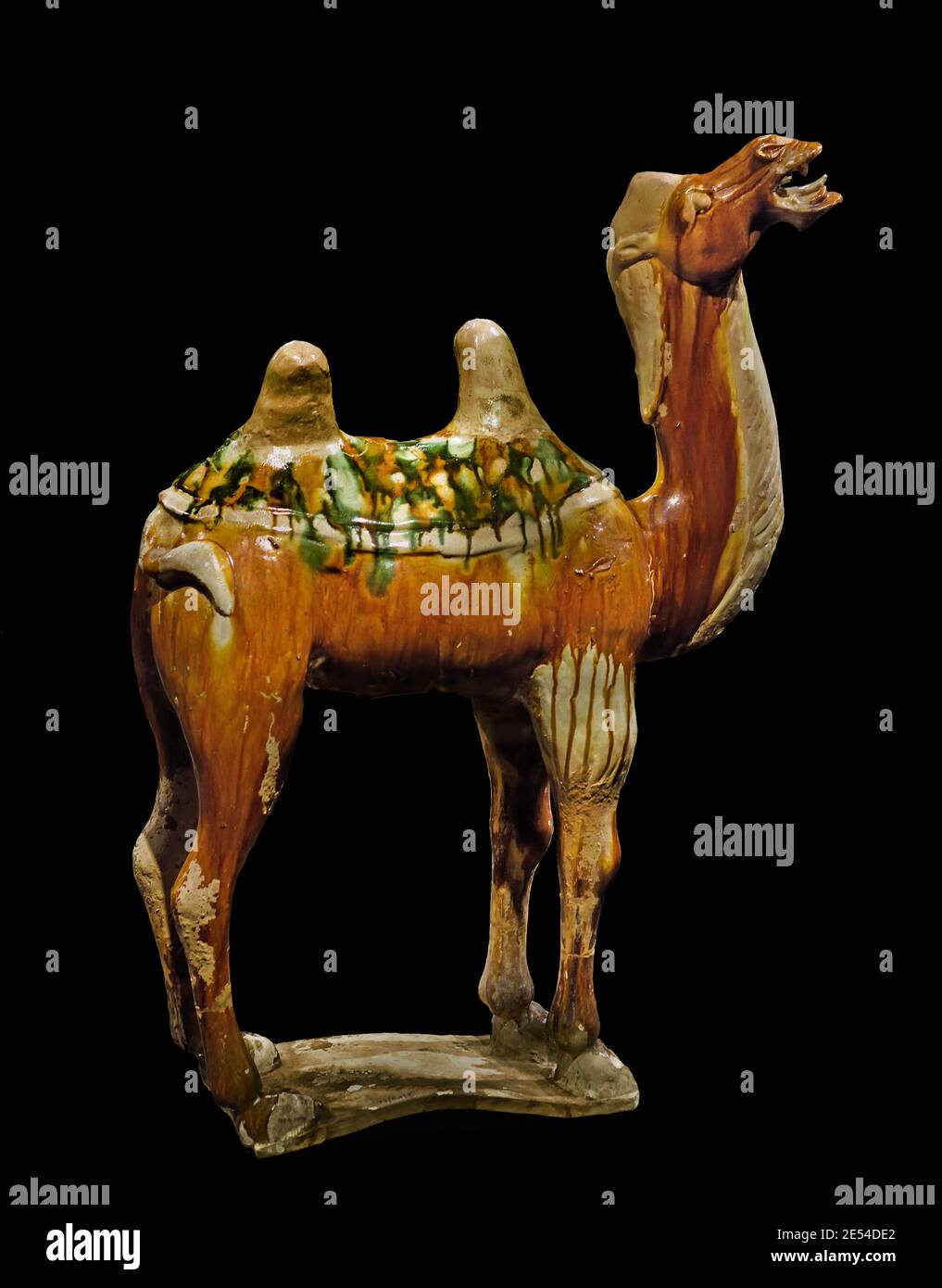 Camel from NORTH CENTRAL CHINA Era Tang dynasty (618-907 C.E.) Funerary Statuette: Bactrian Camel Date 8th Century Earthenware, three-colour glaze (sancai) The Tang dynasty or Tang Empire, was an imperial dynasty of China that ruled from 618 to 907 Stock Photohttps://www.alamy.com/image-license-details/?v=1https://www.alamy.com/camel-from-north-central-china-era-tang-dynasty-618-907-ce-funerary-statuette-bactrian-camel-date-8th-century-earthenware-three-colour-glaze-sancai-the-tang-dynasty-or-tang-empire-was-an-imperial-dynasty-of-china-that-ruled-from-618-to-907-image399010138.html
Camel from NORTH CENTRAL CHINA Era Tang dynasty (618-907 C.E.) Funerary Statuette: Bactrian Camel Date 8th Century Earthenware, three-colour glaze (sancai) The Tang dynasty or Tang Empire, was an imperial dynasty of China that ruled from 618 to 907 Stock Photohttps://www.alamy.com/image-license-details/?v=1https://www.alamy.com/camel-from-north-central-china-era-tang-dynasty-618-907-ce-funerary-statuette-bactrian-camel-date-8th-century-earthenware-three-colour-glaze-sancai-the-tang-dynasty-or-tang-empire-was-an-imperial-dynasty-of-china-that-ruled-from-618-to-907-image399010138.htmlRM2E54DE2–Camel from NORTH CENTRAL CHINA Era Tang dynasty (618-907 C.E.) Funerary Statuette: Bactrian Camel Date 8th Century Earthenware, three-colour glaze (sancai) The Tang dynasty or Tang Empire, was an imperial dynasty of China that ruled from 618 to 907
 Drunken Fisherman by a Reed Bank, Ming dynasty (1368–1644), China, Hanging scroll; ink on paper, Image: 28 7/16 x 14 9/16 in. (7 Stock Photohttps://www.alamy.com/image-license-details/?v=1https://www.alamy.com/stock-image-drunken-fisherman-by-a-reed-bank-ming-dynasty-13681644-china-hanging-162560476.html
Drunken Fisherman by a Reed Bank, Ming dynasty (1368–1644), China, Hanging scroll; ink on paper, Image: 28 7/16 x 14 9/16 in. (7 Stock Photohttps://www.alamy.com/image-license-details/?v=1https://www.alamy.com/stock-image-drunken-fisherman-by-a-reed-bank-ming-dynasty-13681644-china-hanging-162560476.htmlRMKCD7F8–Drunken Fisherman by a Reed Bank, Ming dynasty (1368–1644), China, Hanging scroll; ink on paper, Image: 28 7/16 x 14 9/16 in. (7
 Portrait of Emperor Taizong of Tang (598 – 649), the second emperor of the Tang dynasty of China Stock Photohttps://www.alamy.com/image-license-details/?v=1https://www.alamy.com/portrait-of-emperor-taizong-of-tang-598-649-the-second-emperor-of-the-tang-dynasty-of-china-image462614467.html
Portrait of Emperor Taizong of Tang (598 – 649), the second emperor of the Tang dynasty of China Stock Photohttps://www.alamy.com/image-license-details/?v=1https://www.alamy.com/portrait-of-emperor-taizong-of-tang-598-649-the-second-emperor-of-the-tang-dynasty-of-china-image462614467.htmlRM2HTHWD7–Portrait of Emperor Taizong of Tang (598 – 649), the second emperor of the Tang dynasty of China
 Li Bo (701-62) Chinese poet. Tang Dynasty, XVIIIth century. Chinese painting. Museum: BRITISH LIBRARY, LONDRES, UK. Stock Photohttps://www.alamy.com/image-license-details/?v=1https://www.alamy.com/li-bo-701-62-chinese-poet-tang-dynasty-xviiith-century-chinese-painting-museum-british-library-londres-uk-image630905511.html
Li Bo (701-62) Chinese poet. Tang Dynasty, XVIIIth century. Chinese painting. Museum: BRITISH LIBRARY, LONDRES, UK. Stock Photohttps://www.alamy.com/image-license-details/?v=1https://www.alamy.com/li-bo-701-62-chinese-poet-tang-dynasty-xviiith-century-chinese-painting-museum-british-library-londres-uk-image630905511.htmlRM2YJC6BK–Li Bo (701-62) Chinese poet. Tang Dynasty, XVIIIth century. Chinese painting. Museum: BRITISH LIBRARY, LONDRES, UK.
 Portraits of Periodical Offering of Tang, depicting foreign envoys with tribute bearers. Song dynasty by Yan Liben Stock Photohttps://www.alamy.com/image-license-details/?v=1https://www.alamy.com/portraits-of-periodical-offering-of-tang-depicting-foreign-envoys-with-tribute-bearers-song-dynasty-by-yan-liben-image573255797.html
Portraits of Periodical Offering of Tang, depicting foreign envoys with tribute bearers. Song dynasty by Yan Liben Stock Photohttps://www.alamy.com/image-license-details/?v=1https://www.alamy.com/portraits-of-periodical-offering-of-tang-depicting-foreign-envoys-with-tribute-bearers-song-dynasty-by-yan-liben-image573255797.htmlRM2T8J1H9–Portraits of Periodical Offering of Tang, depicting foreign envoys with tribute bearers. Song dynasty by Yan Liben
 Xi'an souvenirs at shop in Book Courtyard street including Tang dynasty tri-colored glaze figurines and traditional painting Stock Photohttps://www.alamy.com/image-license-details/?v=1https://www.alamy.com/stock-photo-xian-souvenirs-at-shop-in-book-courtyard-street-including-tang-dynasty-17123590.html
Xi'an souvenirs at shop in Book Courtyard street including Tang dynasty tri-colored glaze figurines and traditional painting Stock Photohttps://www.alamy.com/image-license-details/?v=1https://www.alamy.com/stock-photo-xian-souvenirs-at-shop-in-book-courtyard-street-including-tang-dynasty-17123590.htmlRMAYJNMR–Xi'an souvenirs at shop in Book Courtyard street including Tang dynasty tri-colored glaze figurines and traditional painting
 Art inspired by 明, 佚名, 蘇蕙璇璣圖, 卷, Lady Su Hui and Her Verse Puzzle, Ming dynasty (1368–1644), 16th century, China, Handscroll; ink and color on silk, Image: 10 1/16 in. x 10 ft. 2 3/4 in. (25.6 x 311.8 cm), Paintings, In the style of Qiu Ying (Chinese, ca. 1495–1552), This scene appears, Classic works modernized by Artotop with a splash of modernity. Shapes, color and value, eye-catching visual impact on art. Emotions through freedom of artworks in a contemporary way. A timeless message pursuing a wildly creative new direction. Artists turning to the digital medium and creating the Artotop NFT Stock Photohttps://www.alamy.com/image-license-details/?v=1https://www.alamy.com/art-inspired-by-lady-su-hui-and-her-verse-puzzle-ming-dynasty-13681644-16th-century-china-handscroll-ink-and-color-on-silk-image-10-116-in-x-10-ft-2-34-in-256-x-3118-cm-paintings-in-the-style-of-qiu-ying-chinese-ca-14951552-this-scene-appears-classic-works-modernized-by-artotop-with-a-splash-of-modernity-shapes-color-and-value-eye-catching-visual-impact-on-art-emotions-through-freedom-of-artworks-in-a-contemporary-way-a-timeless-message-pursuing-a-wildly-creative-new-direction-artists-turning-to-the-digital-medium-and-creating-the-artotop-nft-image462911992.html
Art inspired by 明, 佚名, 蘇蕙璇璣圖, 卷, Lady Su Hui and Her Verse Puzzle, Ming dynasty (1368–1644), 16th century, China, Handscroll; ink and color on silk, Image: 10 1/16 in. x 10 ft. 2 3/4 in. (25.6 x 311.8 cm), Paintings, In the style of Qiu Ying (Chinese, ca. 1495–1552), This scene appears, Classic works modernized by Artotop with a splash of modernity. Shapes, color and value, eye-catching visual impact on art. Emotions through freedom of artworks in a contemporary way. A timeless message pursuing a wildly creative new direction. Artists turning to the digital medium and creating the Artotop NFT Stock Photohttps://www.alamy.com/image-license-details/?v=1https://www.alamy.com/art-inspired-by-lady-su-hui-and-her-verse-puzzle-ming-dynasty-13681644-16th-century-china-handscroll-ink-and-color-on-silk-image-10-116-in-x-10-ft-2-34-in-256-x-3118-cm-paintings-in-the-style-of-qiu-ying-chinese-ca-14951552-this-scene-appears-classic-works-modernized-by-artotop-with-a-splash-of-modernity-shapes-color-and-value-eye-catching-visual-impact-on-art-emotions-through-freedom-of-artworks-in-a-contemporary-way-a-timeless-message-pursuing-a-wildly-creative-new-direction-artists-turning-to-the-digital-medium-and-creating-the-artotop-nft-image462911992.htmlRF2HW3CY4–Art inspired by 明, 佚名, 蘇蕙璇璣圖, 卷, Lady Su Hui and Her Verse Puzzle, Ming dynasty (1368–1644), 16th century, China, Handscroll; ink and color on silk, Image: 10 1/16 in. x 10 ft. 2 3/4 in. (25.6 x 311.8 cm), Paintings, In the style of Qiu Ying (Chinese, ca. 1495–1552), This scene appears, Classic works modernized by Artotop with a splash of modernity. Shapes, color and value, eye-catching visual impact on art. Emotions through freedom of artworks in a contemporary way. A timeless message pursuing a wildly creative new direction. Artists turning to the digital medium and creating the Artotop NFT
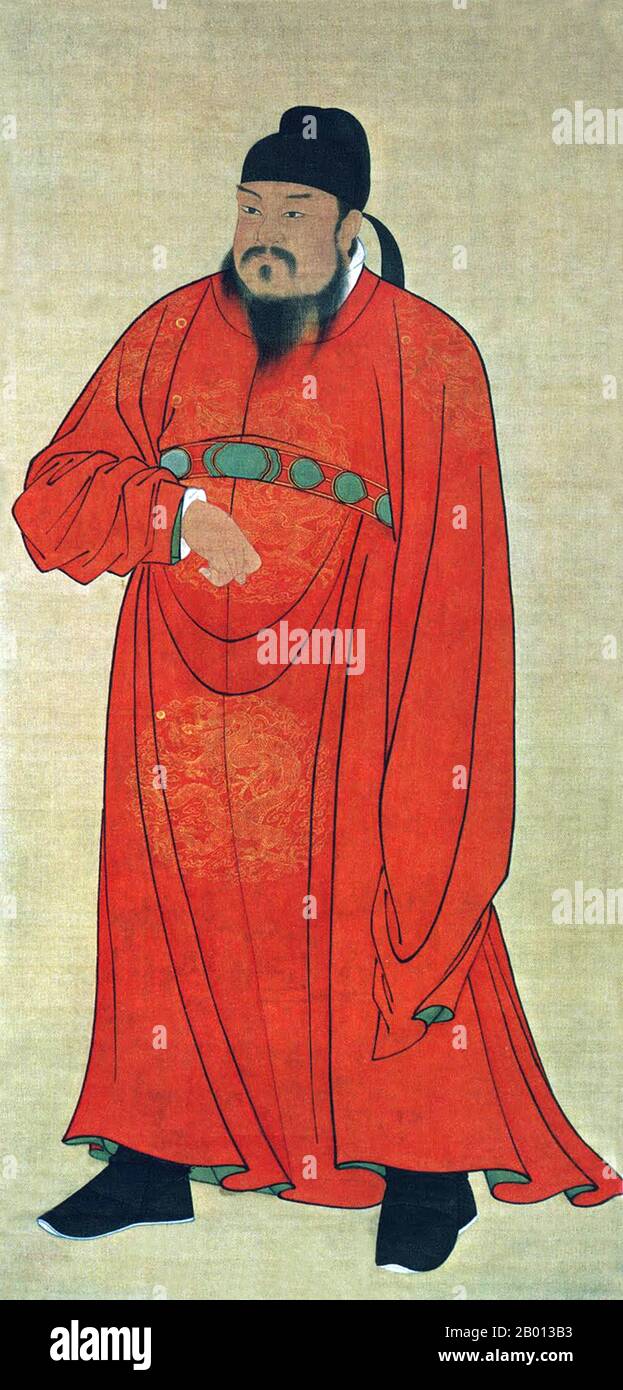 China: Emperor Gaozu (Tang Liyuan, 566 - 25 June 635), 1st ruler of the Tang Dynasty (r. 618-626). Hanging scroll painting. Emperor Gaozu of Tang (566-635), born Li Yuan, courtesy name Shude, was the founder of the Tang Dynasty of China, and the first emperor of this dynasty from 618 to 626. Emperor Gaozu's reign was concentrated on uniting the empire under the Tang. Aided by Li Shimin, whom he named Prince of Qin, he defeated all other contenders. By 628, the Tang Dynasty had succeeded in uniting all of China. Stock Photohttps://www.alamy.com/image-license-details/?v=1https://www.alamy.com/china-emperor-gaozu-tang-liyuan-566-25-june-635-1st-ruler-of-the-tang-dynasty-r-618-626-hanging-scroll-painting-emperor-gaozu-of-tang-566-635-born-li-yuan-courtesy-name-shude-was-the-founder-of-the-tang-dynasty-of-china-and-the-first-emperor-of-this-dynasty-from-618-to-626-emperor-gaozus-reign-was-concentrated-on-uniting-the-empire-under-the-tang-aided-by-li-shimin-whom-he-named-prince-of-qin-he-defeated-all-other-contenders-by-628-the-tang-dynasty-had-succeeded-in-uniting-all-of-china-image344231975.html
China: Emperor Gaozu (Tang Liyuan, 566 - 25 June 635), 1st ruler of the Tang Dynasty (r. 618-626). Hanging scroll painting. Emperor Gaozu of Tang (566-635), born Li Yuan, courtesy name Shude, was the founder of the Tang Dynasty of China, and the first emperor of this dynasty from 618 to 626. Emperor Gaozu's reign was concentrated on uniting the empire under the Tang. Aided by Li Shimin, whom he named Prince of Qin, he defeated all other contenders. By 628, the Tang Dynasty had succeeded in uniting all of China. Stock Photohttps://www.alamy.com/image-license-details/?v=1https://www.alamy.com/china-emperor-gaozu-tang-liyuan-566-25-june-635-1st-ruler-of-the-tang-dynasty-r-618-626-hanging-scroll-painting-emperor-gaozu-of-tang-566-635-born-li-yuan-courtesy-name-shude-was-the-founder-of-the-tang-dynasty-of-china-and-the-first-emperor-of-this-dynasty-from-618-to-626-emperor-gaozus-reign-was-concentrated-on-uniting-the-empire-under-the-tang-aided-by-li-shimin-whom-he-named-prince-of-qin-he-defeated-all-other-contenders-by-628-the-tang-dynasty-had-succeeded-in-uniting-all-of-china-image344231975.htmlRM2B013B3–China: Emperor Gaozu (Tang Liyuan, 566 - 25 June 635), 1st ruler of the Tang Dynasty (r. 618-626). Hanging scroll painting. Emperor Gaozu of Tang (566-635), born Li Yuan, courtesy name Shude, was the founder of the Tang Dynasty of China, and the first emperor of this dynasty from 618 to 626. Emperor Gaozu's reign was concentrated on uniting the empire under the Tang. Aided by Li Shimin, whom he named Prince of Qin, he defeated all other contenders. By 628, the Tang Dynasty had succeeded in uniting all of China.
 A bodhisattva, Bodhisattva from the cave temples of Tianlongshan (cave No.14), head, hands and feet are missing, traces of painting in red., anonymous, Tianlongshan, 618 - 906, Tang-dynasty (618-907), sandstone, h 95.0 cm × w 45.0 cm × d 17 cm Stock Photohttps://www.alamy.com/image-license-details/?v=1https://www.alamy.com/a-bodhisattva-bodhisattva-from-the-cave-temples-of-tianlongshan-cave-no14-head-hands-and-feet-are-missing-traces-of-painting-in-red-anonymous-tianlongshan-618-906-tang-dynasty-618-907-sandstone-h-950-cm-w-450-cm-d-17-cm-image261318515.html
A bodhisattva, Bodhisattva from the cave temples of Tianlongshan (cave No.14), head, hands and feet are missing, traces of painting in red., anonymous, Tianlongshan, 618 - 906, Tang-dynasty (618-907), sandstone, h 95.0 cm × w 45.0 cm × d 17 cm Stock Photohttps://www.alamy.com/image-license-details/?v=1https://www.alamy.com/a-bodhisattva-bodhisattva-from-the-cave-temples-of-tianlongshan-cave-no14-head-hands-and-feet-are-missing-traces-of-painting-in-red-anonymous-tianlongshan-618-906-tang-dynasty-618-907-sandstone-h-950-cm-w-450-cm-d-17-cm-image261318515.htmlRMW542C3–A bodhisattva, Bodhisattva from the cave temples of Tianlongshan (cave No.14), head, hands and feet are missing, traces of painting in red., anonymous, Tianlongshan, 618 - 906, Tang-dynasty (618-907), sandstone, h 95.0 cm × w 45.0 cm × d 17 cm
 Art inspired by Drunken Fisherman by a Reed Bank, Ming dynasty (1368–1644), China, Hanging scroll; ink on paper, Image: 28 7/16 x 14 9/16 in. (72.2 x 37 cm), Paintings, Tang Yin (Chinese, 1470–1524), The fisherman, symbol of the scholar in retirement, is drunk and fast asleep under the, Classic works modernized by Artotop with a splash of modernity. Shapes, color and value, eye-catching visual impact on art. Emotions through freedom of artworks in a contemporary way. A timeless message pursuing a wildly creative new direction. Artists turning to the digital medium and creating the Artotop NFT Stock Photohttps://www.alamy.com/image-license-details/?v=1https://www.alamy.com/art-inspired-by-drunken-fisherman-by-a-reed-bank-ming-dynasty-13681644-china-hanging-scroll-ink-on-paper-image-28-716-x-14-916-in-722-x-37-cm-paintings-tang-yin-chinese-14701524-the-fisherman-symbol-of-the-scholar-in-retirement-is-drunk-and-fast-asleep-under-the-classic-works-modernized-by-artotop-with-a-splash-of-modernity-shapes-color-and-value-eye-catching-visual-impact-on-art-emotions-through-freedom-of-artworks-in-a-contemporary-way-a-timeless-message-pursuing-a-wildly-creative-new-direction-artists-turning-to-the-digital-medium-and-creating-the-artotop-nft-image462761923.html
Art inspired by Drunken Fisherman by a Reed Bank, Ming dynasty (1368–1644), China, Hanging scroll; ink on paper, Image: 28 7/16 x 14 9/16 in. (72.2 x 37 cm), Paintings, Tang Yin (Chinese, 1470–1524), The fisherman, symbol of the scholar in retirement, is drunk and fast asleep under the, Classic works modernized by Artotop with a splash of modernity. Shapes, color and value, eye-catching visual impact on art. Emotions through freedom of artworks in a contemporary way. A timeless message pursuing a wildly creative new direction. Artists turning to the digital medium and creating the Artotop NFT Stock Photohttps://www.alamy.com/image-license-details/?v=1https://www.alamy.com/art-inspired-by-drunken-fisherman-by-a-reed-bank-ming-dynasty-13681644-china-hanging-scroll-ink-on-paper-image-28-716-x-14-916-in-722-x-37-cm-paintings-tang-yin-chinese-14701524-the-fisherman-symbol-of-the-scholar-in-retirement-is-drunk-and-fast-asleep-under-the-classic-works-modernized-by-artotop-with-a-splash-of-modernity-shapes-color-and-value-eye-catching-visual-impact-on-art-emotions-through-freedom-of-artworks-in-a-contemporary-way-a-timeless-message-pursuing-a-wildly-creative-new-direction-artists-turning-to-the-digital-medium-and-creating-the-artotop-nft-image462761923.htmlRF2HTTHFF–Art inspired by Drunken Fisherman by a Reed Bank, Ming dynasty (1368–1644), China, Hanging scroll; ink on paper, Image: 28 7/16 x 14 9/16 in. (72.2 x 37 cm), Paintings, Tang Yin (Chinese, 1470–1524), The fisherman, symbol of the scholar in retirement, is drunk and fast asleep under the, Classic works modernized by Artotop with a splash of modernity. Shapes, color and value, eye-catching visual impact on art. Emotions through freedom of artworks in a contemporary way. A timeless message pursuing a wildly creative new direction. Artists turning to the digital medium and creating the Artotop NFT
 Tang Fengtu Stock Photohttps://www.alamy.com/image-license-details/?v=1https://www.alamy.com/stock-photo-tang-fengtu-110537378.html
Tang Fengtu Stock Photohttps://www.alamy.com/image-license-details/?v=1https://www.alamy.com/stock-photo-tang-fengtu-110537378.htmlRFGBRBFE–Tang Fengtu
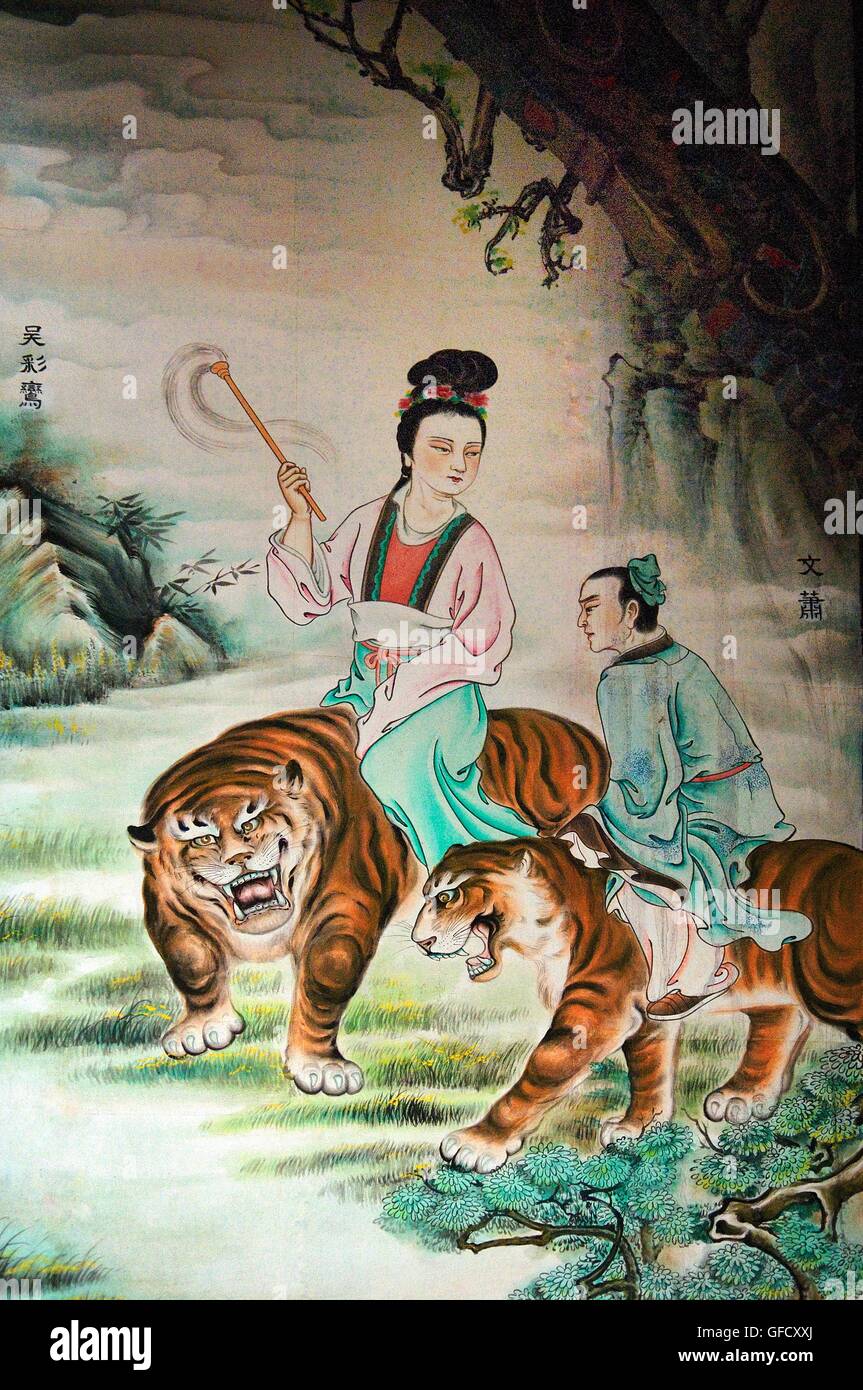 Qingyang Gong Taoist temple, also called Green Ram Temple or Green Goat Temple Chengdu, Sichuan Province, China. Tang Dynasty Stock Photohttps://www.alamy.com/image-license-details/?v=1https://www.alamy.com/stock-photo-qingyang-gong-taoist-temple-also-called-green-ram-temple-or-green-112766602.html
Qingyang Gong Taoist temple, also called Green Ram Temple or Green Goat Temple Chengdu, Sichuan Province, China. Tang Dynasty Stock Photohttps://www.alamy.com/image-license-details/?v=1https://www.alamy.com/stock-photo-qingyang-gong-taoist-temple-also-called-green-ram-temple-or-green-112766602.htmlRMGFCXXJ–Qingyang Gong Taoist temple, also called Green Ram Temple or Green Goat Temple Chengdu, Sichuan Province, China. Tang Dynasty
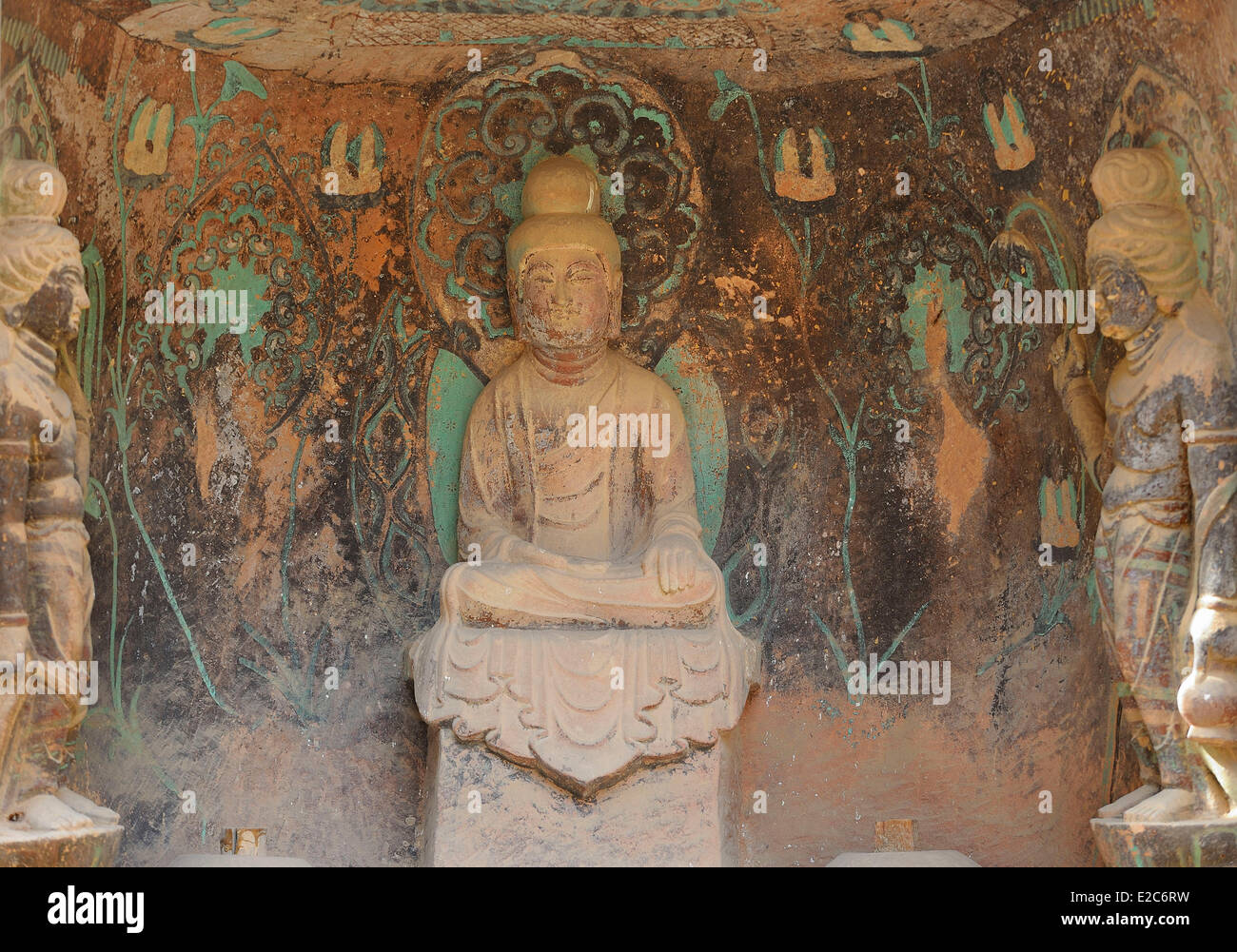 China, Gansu, Bingling Si caves, Buddha (Tang dynasty) Stock Photohttps://www.alamy.com/image-license-details/?v=1https://www.alamy.com/stock-photo-china-gansu-bingling-si-caves-buddha-tang-dynasty-70339581.html
China, Gansu, Bingling Si caves, Buddha (Tang dynasty) Stock Photohttps://www.alamy.com/image-license-details/?v=1https://www.alamy.com/stock-photo-china-gansu-bingling-si-caves-buddha-tang-dynasty-70339581.htmlRME2C6RW–China, Gansu, Bingling Si caves, Buddha (Tang dynasty)
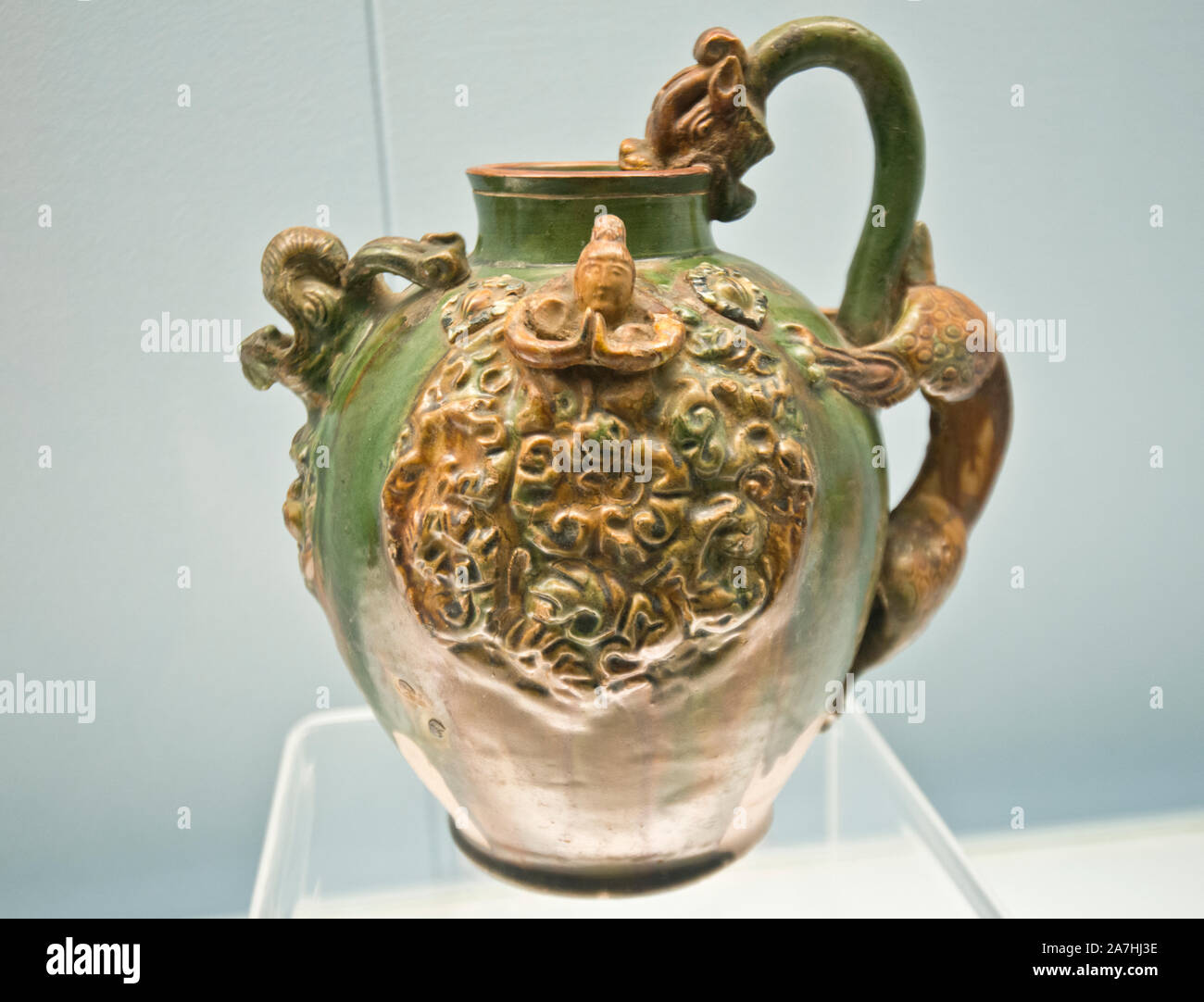 Chinese porcelain: Polychrome glazed pottery pitcher with dragon head and applied design. Tang Dynasty (618-907 A.D.). Shanghai Museum, China. Stock Photohttps://www.alamy.com/image-license-details/?v=1https://www.alamy.com/chinese-porcelain-polychrome-glazed-pottery-pitcher-with-dragon-head-and-applied-design-tang-dynasty-618-907-ad-shanghai-museum-china-image331686978.html
Chinese porcelain: Polychrome glazed pottery pitcher with dragon head and applied design. Tang Dynasty (618-907 A.D.). Shanghai Museum, China. Stock Photohttps://www.alamy.com/image-license-details/?v=1https://www.alamy.com/chinese-porcelain-polychrome-glazed-pottery-pitcher-with-dragon-head-and-applied-design-tang-dynasty-618-907-ad-shanghai-museum-china-image331686978.htmlRF2A7HJ3E–Chinese porcelain: Polychrome glazed pottery pitcher with dragon head and applied design. Tang Dynasty (618-907 A.D.). Shanghai Museum, China.
 Seoul, South Korea. 16th Jan, 2014. A visitor views Tangka, or the Tibetan art of scroll painting, from China's Gansu province at the China Cultural Center in Seoul, South Korea, Jan. 16, 2014. Originated from Tang Dynasty, Tangka is a unique style of traditional Tibetan scroll paintings found only in China's Tibetan areas. © Yao Qilin/Xinhua/Alamy Live News Stock Photohttps://www.alamy.com/image-license-details/?v=1https://www.alamy.com/seoul-south-korea-16th-jan-2014-a-visitor-views-tangka-or-the-tibetan-image65693846.html
Seoul, South Korea. 16th Jan, 2014. A visitor views Tangka, or the Tibetan art of scroll painting, from China's Gansu province at the China Cultural Center in Seoul, South Korea, Jan. 16, 2014. Originated from Tang Dynasty, Tangka is a unique style of traditional Tibetan scroll paintings found only in China's Tibetan areas. © Yao Qilin/Xinhua/Alamy Live News Stock Photohttps://www.alamy.com/image-license-details/?v=1https://www.alamy.com/seoul-south-korea-16th-jan-2014-a-visitor-views-tangka-or-the-tibetan-image65693846.htmlRMDPTH4P–Seoul, South Korea. 16th Jan, 2014. A visitor views Tangka, or the Tibetan art of scroll painting, from China's Gansu province at the China Cultural Center in Seoul, South Korea, Jan. 16, 2014. Originated from Tang Dynasty, Tangka is a unique style of traditional Tibetan scroll paintings found only in China's Tibetan areas. © Yao Qilin/Xinhua/Alamy Live News
 . In this landscape painting, the young Sakyamuni cuts off his hair while attendants watch, ink and color on silk, from Dunhuang, Gansu province, China, dated to the Tang Dynasty (618–907 AD) . Tang Dynasty (618–907 AD). Chinese artist 539 Sakyamuni cuts his hair, Tang Dynasty Stock Photohttps://www.alamy.com/image-license-details/?v=1https://www.alamy.com/in-this-landscape-painting-the-young-sakyamuni-cuts-off-his-hair-while-attendants-watch-ink-and-color-on-silk-from-dunhuang-gansu-province-china-dated-to-the-tang-dynasty-618907-ad-tang-dynasty-618907-ad-chinese-artist-539-sakyamuni-cuts-his-hair-tang-dynasty-image188109183.html
. In this landscape painting, the young Sakyamuni cuts off his hair while attendants watch, ink and color on silk, from Dunhuang, Gansu province, China, dated to the Tang Dynasty (618–907 AD) . Tang Dynasty (618–907 AD). Chinese artist 539 Sakyamuni cuts his hair, Tang Dynasty Stock Photohttps://www.alamy.com/image-license-details/?v=1https://www.alamy.com/in-this-landscape-painting-the-young-sakyamuni-cuts-off-his-hair-while-attendants-watch-ink-and-color-on-silk-from-dunhuang-gansu-province-china-dated-to-the-tang-dynasty-618907-ad-tang-dynasty-618907-ad-chinese-artist-539-sakyamuni-cuts-his-hair-tang-dynasty-image188109183.htmlRMMX1353–. In this landscape painting, the young Sakyamuni cuts off his hair while attendants watch, ink and color on silk, from Dunhuang, Gansu province, China, dated to the Tang Dynasty (618–907 AD) . Tang Dynasty (618–907 AD). Chinese artist 539 Sakyamuni cuts his hair, Tang Dynasty
 Joaquin Baldomero Fernandez-Espartero Alvarez de Toro (1793-1879), called Baldomero Espartero. Spanish military and politician. Oath of General Espartero (on May 10, 1841). Sketch. Oil on cardboard, ca.1841. Anonymous. Museum of Romanticism. Madrid, Spain. Stock Photohttps://www.alamy.com/image-license-details/?v=1https://www.alamy.com/joaquin-baldomero-fernandez-espartero-alvarez-de-toro-1793-1879-called-baldomero-espartero-spanish-military-and-politician-oath-of-general-espartero-on-may-10-1841-sketch-oil-on-cardboard-ca1841-anonymous-museum-of-romanticism-madrid-spain-image447937082.html
Joaquin Baldomero Fernandez-Espartero Alvarez de Toro (1793-1879), called Baldomero Espartero. Spanish military and politician. Oath of General Espartero (on May 10, 1841). Sketch. Oil on cardboard, ca.1841. Anonymous. Museum of Romanticism. Madrid, Spain. Stock Photohttps://www.alamy.com/image-license-details/?v=1https://www.alamy.com/joaquin-baldomero-fernandez-espartero-alvarez-de-toro-1793-1879-called-baldomero-espartero-spanish-military-and-politician-oath-of-general-espartero-on-may-10-1841-sketch-oil-on-cardboard-ca1841-anonymous-museum-of-romanticism-madrid-spain-image447937082.htmlRM2H0N88X–Joaquin Baldomero Fernandez-Espartero Alvarez de Toro (1793-1879), called Baldomero Espartero. Spanish military and politician. Oath of General Espartero (on May 10, 1841). Sketch. Oil on cardboard, ca.1841. Anonymous. Museum of Romanticism. Madrid, Spain.
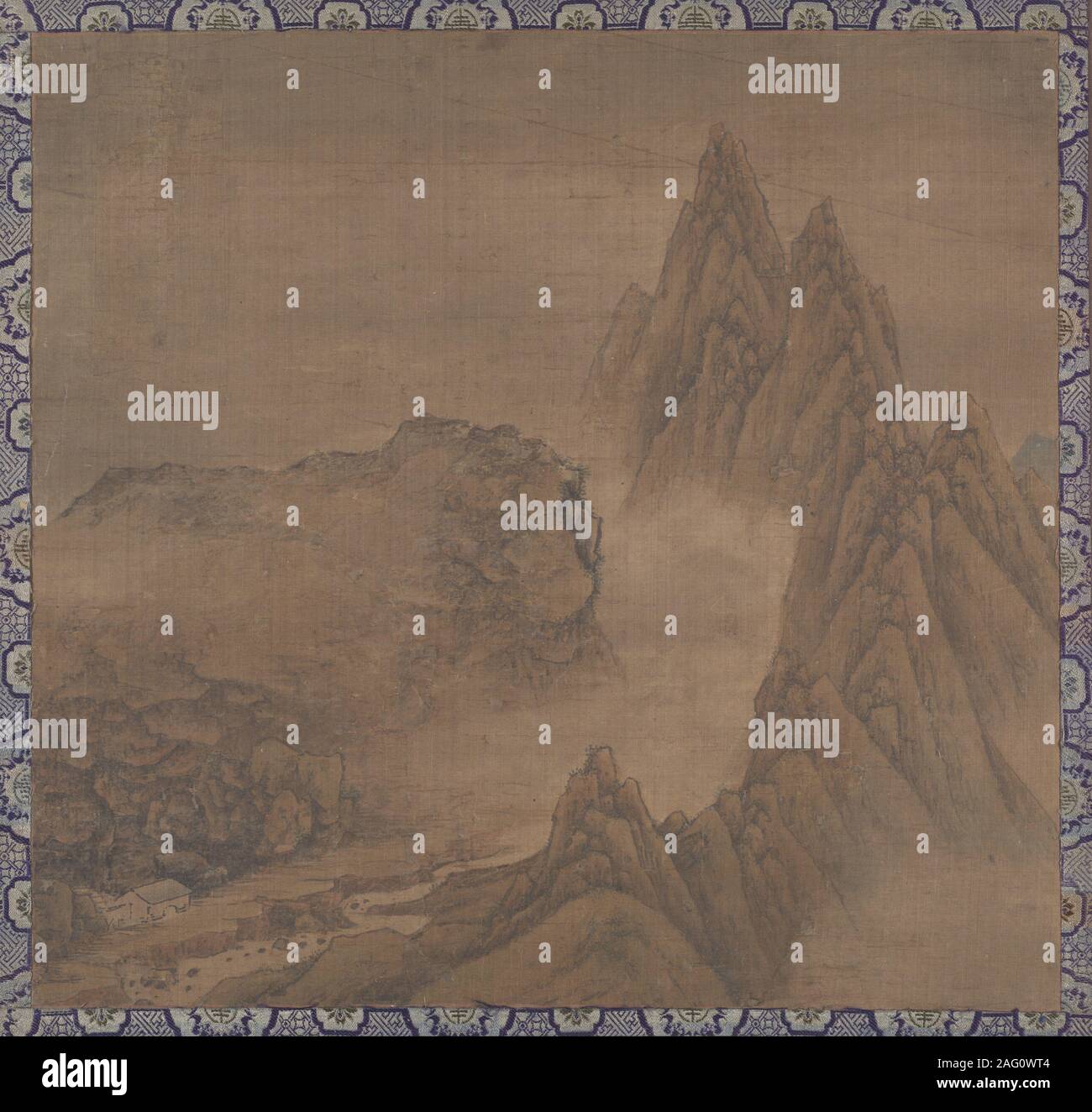 Landscape. Formerly Attributed to Pei Kuan (Chinese, Tang dynasty) Stock Photohttps://www.alamy.com/image-license-details/?v=1https://www.alamy.com/landscape-formerly-attributed-to-pei-kuan-chinese-tang-dynasty-image336851764.html
Landscape. Formerly Attributed to Pei Kuan (Chinese, Tang dynasty) Stock Photohttps://www.alamy.com/image-license-details/?v=1https://www.alamy.com/landscape-formerly-attributed-to-pei-kuan-chinese-tang-dynasty-image336851764.htmlRM2AG0WT4–Landscape. Formerly Attributed to Pei Kuan (Chinese, Tang dynasty)
 The Southern Tang Dynasty map of Nanjing Stock Photohttps://www.alamy.com/image-license-details/?v=1https://www.alamy.com/stock-photo-the-southern-tang-dynasty-map-of-nanjing-132492059.html
The Southern Tang Dynasty map of Nanjing Stock Photohttps://www.alamy.com/image-license-details/?v=1https://www.alamy.com/stock-photo-the-southern-tang-dynasty-map-of-nanjing-132492059.htmlRMHKFEY7–The Southern Tang Dynasty map of Nanjing
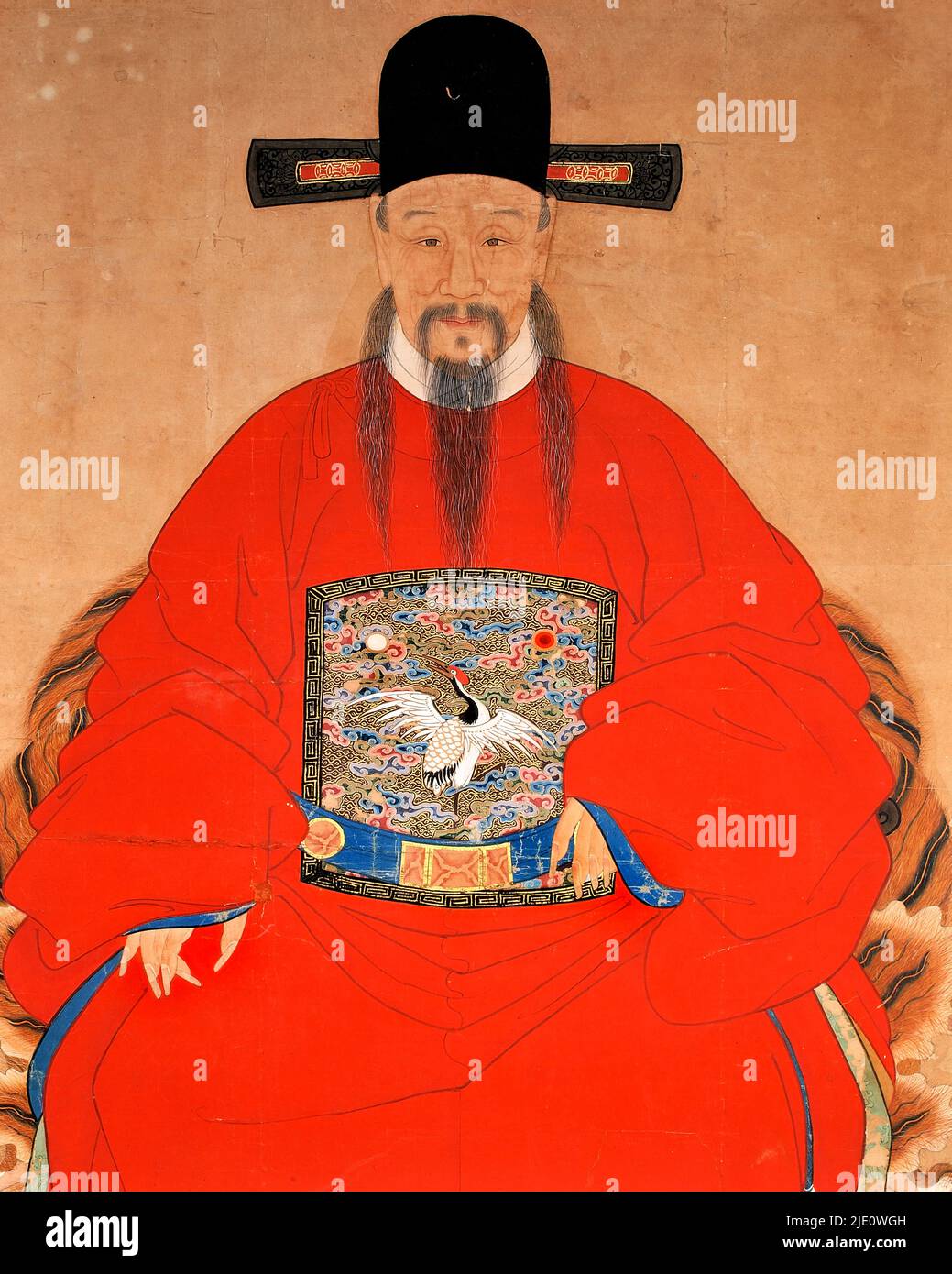 Ancient Chinese painting, portrait of a Chinese dignitary, tempera on canvas, Qing period 1644-1911. Stock Photohttps://www.alamy.com/image-license-details/?v=1https://www.alamy.com/ancient-chinese-painting-portrait-of-a-chinese-dignitary-tempera-on-canvas-qing-period-1644-1911-image473305185.html
Ancient Chinese painting, portrait of a Chinese dignitary, tempera on canvas, Qing period 1644-1911. Stock Photohttps://www.alamy.com/image-license-details/?v=1https://www.alamy.com/ancient-chinese-painting-portrait-of-a-chinese-dignitary-tempera-on-canvas-qing-period-1644-1911-image473305185.htmlRM2JE0WGH–Ancient Chinese painting, portrait of a Chinese dignitary, tempera on canvas, Qing period 1644-1911.
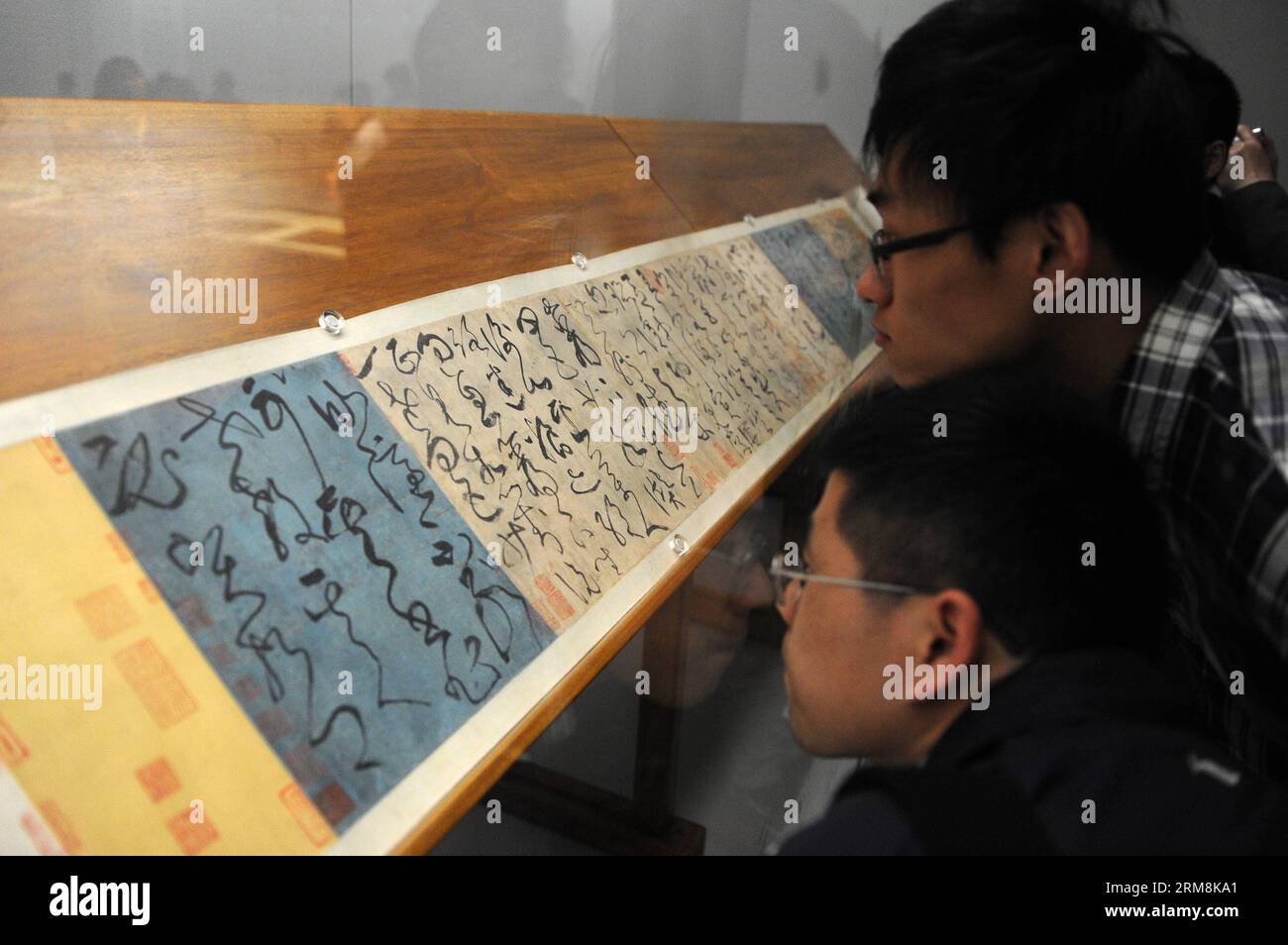 People look at a work of Zhang Xu, a famous calligrapheer in Tang Dynasty (618-907), at the Zhejiang Provincial Museum in Hangzhou, capital of east China s Zhejiang Province, April 18, 2014. An exhibition displaying master works of famous calligraphers and painters in the Tang Dynasty (618-907), Song Dynasty (1127-1279) and Yuan Dynasty (1271-1368) kicked off here Friday. It will last until May 18. (Xinhua/Ju Huanzong)(wjq) CHINA-ZHEJIANG-HANGZHOU-PAINTING & CALLIGRAPHY EXHIBITION (CN) PUBLICATIONxNOTxINxCHN Celebrities Look AT a Work of Zhang Xu a Famous in Tang Dynasty 618 907 AT The Zhej Stock Photohttps://www.alamy.com/image-license-details/?v=1https://www.alamy.com/people-look-at-a-work-of-zhang-xu-a-famous-calligrapheer-in-tang-dynasty-618-907-at-the-zhejiang-provincial-museum-in-hangzhou-capital-of-east-china-s-zhejiang-province-april-18-2014-an-exhibition-displaying-master-works-of-famous-calligraphers-and-painters-in-the-tang-dynasty-618-907-song-dynasty-1127-1279-and-yuan-dynasty-1271-1368-kicked-off-here-friday-it-will-last-until-may-18-xinhuaju-huanzongwjq-china-zhejiang-hangzhou-painting-calligraphy-exhibition-cn-publicationxnotxinxchn-celebrities-look-at-a-work-of-zhang-xu-a-famous-in-tang-dynasty-618-907-at-the-zhej-image563215689.html
People look at a work of Zhang Xu, a famous calligrapheer in Tang Dynasty (618-907), at the Zhejiang Provincial Museum in Hangzhou, capital of east China s Zhejiang Province, April 18, 2014. An exhibition displaying master works of famous calligraphers and painters in the Tang Dynasty (618-907), Song Dynasty (1127-1279) and Yuan Dynasty (1271-1368) kicked off here Friday. It will last until May 18. (Xinhua/Ju Huanzong)(wjq) CHINA-ZHEJIANG-HANGZHOU-PAINTING & CALLIGRAPHY EXHIBITION (CN) PUBLICATIONxNOTxINxCHN Celebrities Look AT a Work of Zhang Xu a Famous in Tang Dynasty 618 907 AT The Zhej Stock Photohttps://www.alamy.com/image-license-details/?v=1https://www.alamy.com/people-look-at-a-work-of-zhang-xu-a-famous-calligrapheer-in-tang-dynasty-618-907-at-the-zhejiang-provincial-museum-in-hangzhou-capital-of-east-china-s-zhejiang-province-april-18-2014-an-exhibition-displaying-master-works-of-famous-calligraphers-and-painters-in-the-tang-dynasty-618-907-song-dynasty-1127-1279-and-yuan-dynasty-1271-1368-kicked-off-here-friday-it-will-last-until-may-18-xinhuaju-huanzongwjq-china-zhejiang-hangzhou-painting-calligraphy-exhibition-cn-publicationxnotxinxchn-celebrities-look-at-a-work-of-zhang-xu-a-famous-in-tang-dynasty-618-907-at-the-zhej-image563215689.htmlRM2RM8KA1–People look at a work of Zhang Xu, a famous calligrapheer in Tang Dynasty (618-907), at the Zhejiang Provincial Museum in Hangzhou, capital of east China s Zhejiang Province, April 18, 2014. An exhibition displaying master works of famous calligraphers and painters in the Tang Dynasty (618-907), Song Dynasty (1127-1279) and Yuan Dynasty (1271-1368) kicked off here Friday. It will last until May 18. (Xinhua/Ju Huanzong)(wjq) CHINA-ZHEJIANG-HANGZHOU-PAINTING & CALLIGRAPHY EXHIBITION (CN) PUBLICATIONxNOTxINxCHN Celebrities Look AT a Work of Zhang Xu a Famous in Tang Dynasty 618 907 AT The Zhej
 Confucius Tang Dynasty Stock Photohttps://www.alamy.com/image-license-details/?v=1https://www.alamy.com/stock-photo-confucius-tang-dynasty-139704506.html
Confucius Tang Dynasty Stock Photohttps://www.alamy.com/image-license-details/?v=1https://www.alamy.com/stock-photo-confucius-tang-dynasty-139704506.htmlRMJ382EJ–Confucius Tang Dynasty
 'Lan-ting Xu'Preface to the Poems Composed at the Orchid Pavilion,copy by an artist in the Tang dynasty. Date/Period: 618/906. Painting. Width: 65.6 cm. Height: 24.5 cm (Without frame). Author: UNKNOWN. Stock Photohttps://www.alamy.com/image-license-details/?v=1https://www.alamy.com/lan-ting-xupreface-to-the-poems-composed-at-the-orchid-pavilioncopy-by-an-artist-in-the-tang-dynasty-dateperiod-618906-painting-width-656-cm-height-245-cm-without-frame-author-unknown-image219068876.html
'Lan-ting Xu'Preface to the Poems Composed at the Orchid Pavilion,copy by an artist in the Tang dynasty. Date/Period: 618/906. Painting. Width: 65.6 cm. Height: 24.5 cm (Without frame). Author: UNKNOWN. Stock Photohttps://www.alamy.com/image-license-details/?v=1https://www.alamy.com/lan-ting-xupreface-to-the-poems-composed-at-the-orchid-pavilioncopy-by-an-artist-in-the-tang-dynasty-dateperiod-618906-painting-width-656-cm-height-245-cm-without-frame-author-unknown-image219068876.htmlRMPMBCGC–'Lan-ting Xu'Preface to the Poems Composed at the Orchid Pavilion,copy by an artist in the Tang dynasty. Date/Period: 618/906. Painting. Width: 65.6 cm. Height: 24.5 cm (Without frame). Author: UNKNOWN.
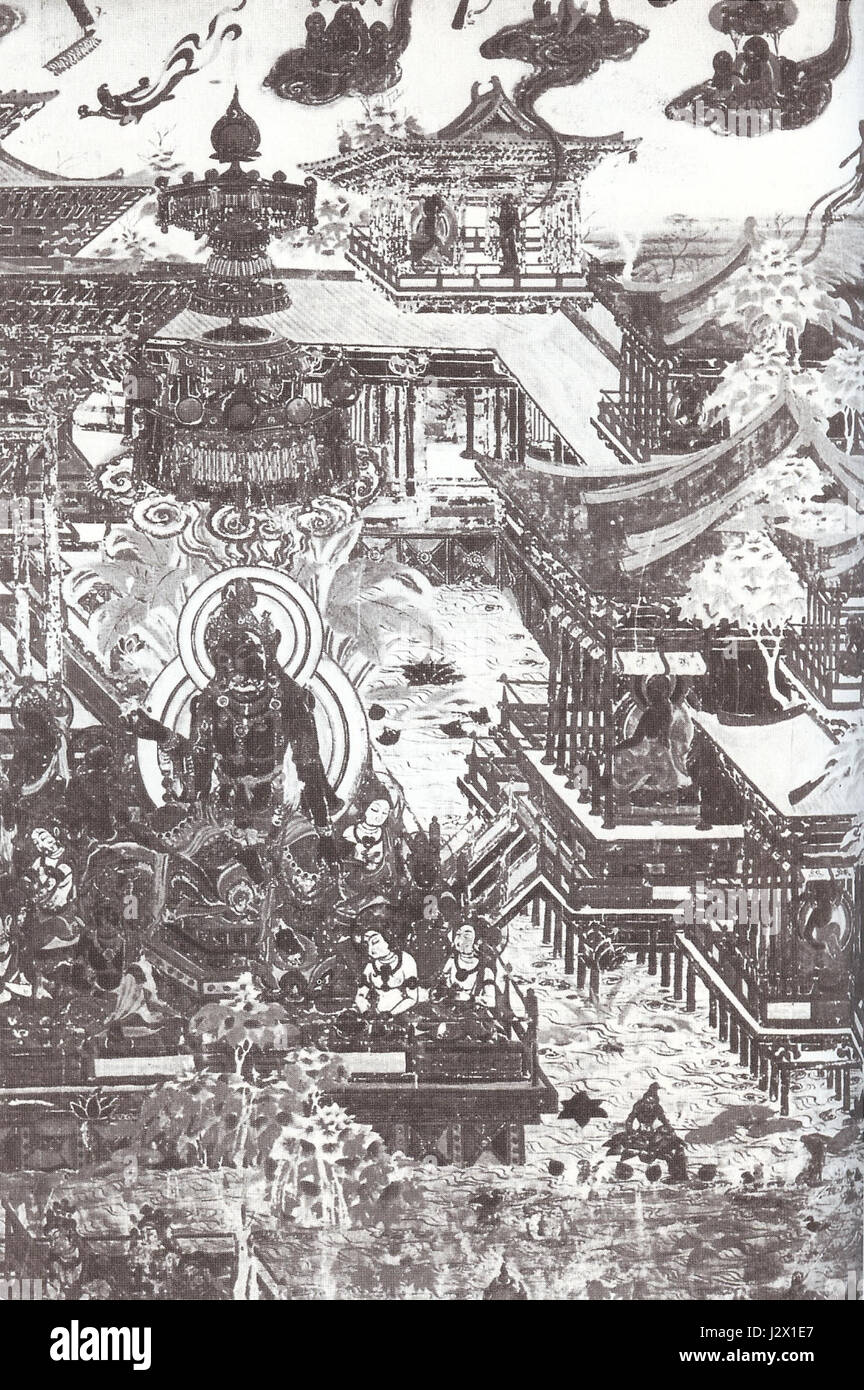 Buddhist Paradise of Amitabha, Tang Dynasty Stock Photohttps://www.alamy.com/image-license-details/?v=1https://www.alamy.com/stock-photo-buddhist-paradise-of-amitabha-tang-dynasty-139484191.html
Buddhist Paradise of Amitabha, Tang Dynasty Stock Photohttps://www.alamy.com/image-license-details/?v=1https://www.alamy.com/stock-photo-buddhist-paradise-of-amitabha-tang-dynasty-139484191.htmlRMJ2X1E7–Buddhist Paradise of Amitabha, Tang Dynasty
 EQUATORIAL GUINEA - CIRCA 1977: a stamp printed in Equatorial Guinea shows Chinese Horse Painting, Chinese Art, Dynasty Tang, circa 1977 Stock Photohttps://www.alamy.com/image-license-details/?v=1https://www.alamy.com/equatorial-guinea-circa-1977-a-stamp-printed-in-equatorial-guinea-shows-chinese-horse-painting-chinese-art-dynasty-tang-circa-1977-image448408596.html
EQUATORIAL GUINEA - CIRCA 1977: a stamp printed in Equatorial Guinea shows Chinese Horse Painting, Chinese Art, Dynasty Tang, circa 1977 Stock Photohttps://www.alamy.com/image-license-details/?v=1https://www.alamy.com/equatorial-guinea-circa-1977-a-stamp-printed-in-equatorial-guinea-shows-chinese-horse-painting-chinese-art-dynasty-tang-circa-1977-image448408596.htmlRF2H1ENMM–EQUATORIAL GUINEA - CIRCA 1977: a stamp printed in Equatorial Guinea shows Chinese Horse Painting, Chinese Art, Dynasty Tang, circa 1977